Sercomm AP105NA 802.11N Wireless Access Point User Manual AP105NA FCC
Sercomm Corporation 802.11N Wireless Access Point AP105NA FCC
Sercomm >
Users Manual

11n Wireless
Access Point
User's Guide

i
TABLE OF CONTENTS
CHAPTER 1 INTRODUCTION ............................................................................................. 1
Features of your Wireless Access Point ........................................................................... 1
Package Contents .............................................................................................................. 3
Physical Details .................................................................................................................. 4
CHAPTER 2 INSTALLATION ............................................................................................... 6
Requirements ..................................................................................................................... 6
Procedure ........................................................................................................................... 6
CHAPTER 3 ACCESS POINT SETUP .................................................................................. 8
Overview ............................................................................................................................ 8
Setup using the Windows Utility ...................................................................................... 8
Setup using a Web Browser ............................................................................................ 11
System Basic Settings Screen .......................................................................................... 13
System Advanced Settings Screen .................................................................................. 15
Wireless Screens .............................................................................................................. 17
Basic Screen ..................................................................................................................... 17
Virtual AP Settings .......................................................................................................... 20
Virtual AP Screen ............................................................................................................ 22
Radius Server Settings .................................................................................................... 35
Access Control ................................................................................................................. 36
Advanced Settings ........................................................................................................... 39
Wi-Fi Protected Setup .................................................................................................... .40
CHAPTER 4 PC AND SERVER CONFIGURATION ....................................................... 41
Overview .......................................................................................................................... 41
Using WEP ....................................................................................................................... 40
Using WPA-PSK/WPA2-PSK ........................................................................................ 42
Using WPA-Enterprise ................................................................................................... 43
802.1x Server Setup (Windows 2000 Server) ................................................................ 44
802.1x Client Setup on Windows XP ............................................................................. 54
Using 802.1x Mode (without WPA) ............................................................................... 60
CHAPTER 5 OPERATION AND STATUS ......................................................................... 61
Operation ......................................................................................................................... 61
Status Screen .................................................................................................................... 61
CHAPTER 6 ACCESS POINT MANAGEMENT ............................................................... 68
Overview .......................................................................................................................... 68
Admin Login Screen ........................................................................................................ 68
Auto Config/Update ........................................................................................................ 73
Config File
........................................................................................................................ 74
SNMP ............................................................................................................................... 76
Log Settings ...................................................................................................................... 77
Firmware Upgrade .......................................................................................................... 78
APPENDIX A SPECIFICATIONS ....................................................................................... 79
Wireless Access Point ...................................................................................................... 79
APPENDIX B TROUBLESHOOTING ................................................................................ 82
Overview .......................................................................................................................... 82
General Problems ............................................................................................................ 82
APPENDIX C WINDOWS TCP/IP ....................................................................................... 84
Overview .......................................................................................................................... 84
Checking TCP/IP Settings - Windows 9x/ME: ............................................................. 84
Checking TCP/IP Settings - Windows NT4.0 ............................................................... 86
Checking TCP/IP Settings - Windows 2000 .................................................................. 88
Wireless Access Point User Guide
ii
Checking TCP/IP Settings - Windows XP .................................................................... 90
Checking TCP/IP Settings - Windows Vista ................................................................. 92
APPENDIX D ABOUT WIRELESS LANS .......................................................................... 94
Overview .......................................................................................................................... 94
Wireless LAN Terminology ............................................................................................ 94
APPENDIX E COMMAND LINE INTERFACE ................................................................ 97
Overview .......................................................................................................................... 97
Command Reference ....................................................................................................... 97
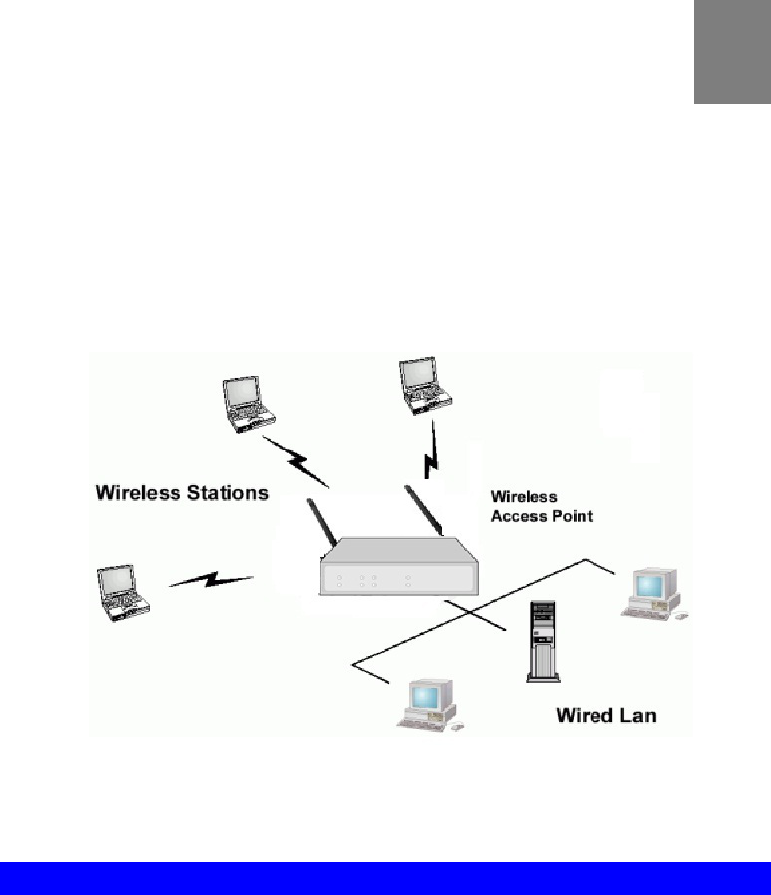
1
Chapter 1
Introduction
This Chapter provides an overview of the Wireless Access Point's features
and capabilities.
Congratulations on the purchase of your new Wireless Access Point. The Wireless Access
Point links your Wireless Stations to your wired LAN. The Wireless stations and devices on
the wired LAN are then on the same network, and can communicate with each other without
regard for whether they are connected to the network via a Wireless or wired connection.
Figure 1: Wireless Access Point
Features of your Wireless Access Point
The Wireless Access Point incorporates many advanced features, carefully designed to provide
sophisticated functions while being easy to use.
Standards Compliant. The Wireless Access Point complies with the IEEE802.11g and
IEEE802.11n draft 2.0 specifications for Wireless LANs.
Supports 11n Wireless Stations. The 802.11n Draft standard provides for backward
compatibility with the 802.11b standard, so 802.11n, 802.11b and 802.11g Wireless sta-
tions can be used simultaneously.
Bridge Mode Support. The Wireless Access Point can operate in Bridge Mode, con-
necting to another Access Point. Both PTP (Point to Point) and PTMP (Point to Multi-
Point) Bridge modes are supported.
And you can even use both Bridge Mode and Access Point Mode simultaneously!
DHCP Client Support. Dynamic Host Configuration Protocol provides a dynamic IP
address to PCs and other devices upon request. The Wireless Access Point can act as a
DHCP Client, and obtain an IP address and related information from your existing DHPC
Server.
1

Wireless Access Point User Guide
2
Thin AP. Support thin AP function.
Upgradeable Firmware. Firmware is stored in a flash memory and can be upgraded
easily, using only your Web Browser.
PoE Support. You can use PoE (Power over Ethernet) to provide power to the Wireless
Access Point, so only a single cable connection is required.
Security Features
Virtual APs. For maximum flexibility, wireless security settings are stored in Virtual AP.
Up to 8 Virtual APs can be defined and used as any time.
Multiple BSSIDs. Because each Virtual AP has it own SSID and beacon, and up to 4
Virtual APs can be active simultaneously, multiple SSIDs are supported. Different clients
can connect to the Wireless Access Point using different SSIDs, with different security
settings.
Virtual APs Isolation. If desired, PCs and devices connecting to different Virtual APs
can be isolated from each other.
VLAN Support. The 802.1Q VLAN standard is supported, allowing traffic from differ-
ent sources to be segmented. Combined with the multiple SSID feature, this provides a
powerful tool to control access to your LAN.
WEP support. Support for WEP (Wired Equivalent Privacy) is included. Both 64 Bit
128 Bit, and 152 Bit keys are supported.
WPA support. Support for WPA is included. WPA is more secure than WEP, and
should be used if possible. Both TKIP and AES encryption methods are supported.
802.1x Support. Support for 802.1x mode is included, providing for the industrial-
strength wireless security of 802.1x authentication and authorization.
Radius Client Support. The Wireless Access Point can login to your existing Radius
Server (as a Radius client).
Radius MAC Authentication. You can centralize the checking of Wireless Station
MAC addresses by using a Radius Server.
Rogue AP Detection. The Wireless Access Point can detect unauthorized (Rouge)
Access Points on your LAN.
Access Control. The Access Control feature can check the MAC address of Wireless
clients to ensure that only trusted Wireless Stations can use the Wireless Access Point to
gain access to your LAN.
Password - protected Configuration. Optional password protection is provided to
prevent unauthorized users from modifying the configuration data and settings.
Advanced Features
Command Line Interface. If desired, the command line interface (CLI) can be used for
configuration. This provides the possibility of creating scripts to perform common config-
uration changes.
Auto Configuration. The Wireless Access Point can perform self-configuration by
copying the configuration data from another Access Point. This feature is enabled by de-
fault.
Auto Update. The Wireless Access Point can automatically update its firmware, by
downloading and installing new firmware from your FTP server.
Radius Accounting Support. If you have a Radius Server, you can use it to provide
accounting data on Wireless clients.

Introduction
3
Syslog Support. If you have a Syslog Server, the Wireless Access Point can send its log
data to your Syslog Server.
SNMP Support. SNMP (Simple Network Management Protocol) is supported, allowing
you to use a SNMP program to manage the Wireless Access Point.
Package Contents
The following items should be included:
Wireless Access Point
Power Adapter
2Pcs Antenna
If any of the above items are damaged or missing, please contact your dealer immediately.
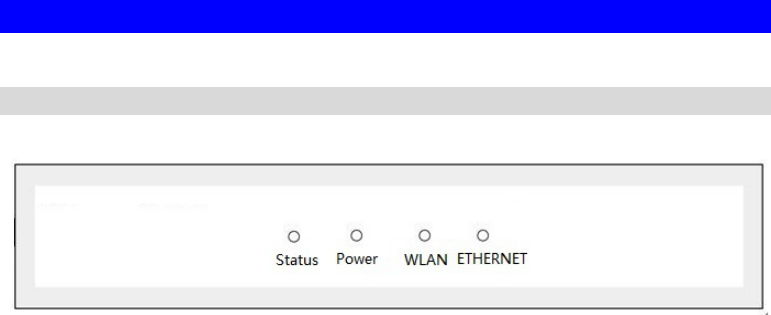
Wireless Access Point User Guide
4
Physical Details
Front Panel LEDs
Figure 2: Front Panel
Power On - Normal operation.
Off - No power
WLAN On - Idle
Off - Wireless connection is not available.
Flashing - Data is being transmitted or received via the Wireless access
point. Data includes "network traffic" as well as user data.
Status On - Error condition.
Off - Normal operation.
Blinking - During start up, and when the Firmware is being upgraded.
Ethernet On - The LAN (Ethernet) port is active.
Off - No active connection on the LAN (Ethernet) port.
Flashing - Data is being transmitted or received via the corresponding
LAN (Ethernet) port.

Introduction
5
Rear Panel
Figure 3: Rear Panel
Reset Button This button has two (2) functions:
Reboot. When pressed and released, the Wireless Access Point
will reboot (restart).
Reset to Factory Defaults. This button can also be used to clear
ALL data and restore ALL settings to the factory default values.
To Clear All Data and restore the factory default values:
1. Hold the Reset Button until the Status (Red) LED blinks TWICE,
usually more than 5 seconds.
2. Release the Reset Button.
The factory default configuration has now been restored, and the
Access Point is ready for use.
ETHERNET Use a standard LAN cable (RJ45 connectors) to connect this port to a
10/100/1000BaseT hub/switch on your LAN.
Power port Connect the supplied power adapter (12V@1A) here.
CONSOLE DB9 female RS232 port.
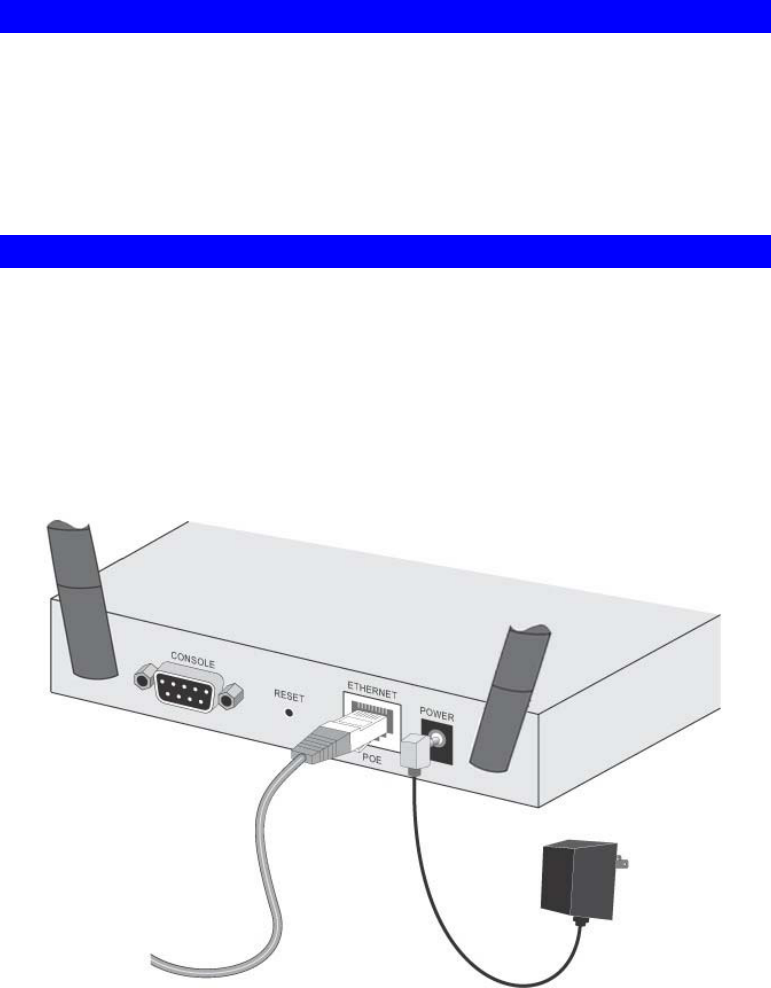
6
Chapter 2
Installation
This Chapter covers the physical installation of the Wireless Access Point.
Requirements
Requirements:
TCP/IP network
Ethernet cable with RJ-45 connectors
Installed Wireless network adapter for each PC that will be wirelessly connected to the
network
Procedure
1. Select a suitable location for the installation of your Wireless Access Point. To maximize
reliability and performance, follow these guidelines:
Use an elevated location, such as wall mounted or on the top of a cubicle.
Place the Wireless Access Point near the center of your wireless coverage area.
If possible, ensure there are no thick walls or metal shielding between the Wireless
Access Point and Wireless stations. Under ideal conditions, the Wireless Access Point
has a range of around 150 meters (450 feet). The range is reduced, and transmission
speed is lower, if there are any obstructions between Wireless devices.
Figure 4: Installation Diagram
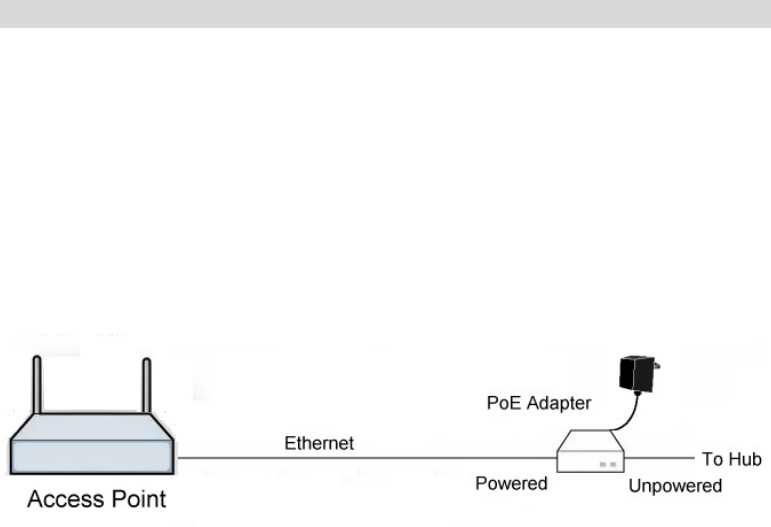
Installation
7
2. Use a standard LAN cable to connect the "LAN" port on the Wireless Access Point to a
10/100/1000BaseT hub/switch on your LAN.
3. Connect the supplied power adapter to the Wireless Access Point and a convenient power
outlet, and power up.
4. Check the LEDs:
The Status LED should flash, then turn OFF.
The Power, Ethernet and WLAN LEDs should be ON.
For more information, refer to Front Panel LEDs in Chapter 1.
Using PoE (Power over Ethernet)
The Wireless Access Point supports PoE (Power over Ethernet). To use PoE:
1. Do not connect the supplied power adapter to the Wireless Access Point.
2. Connect one end of a standard (category 5) LAN cable to the Ethernet port on the Wire-
less Access Point.
3. Connect the other end of the LAN cable to the powered Ethernet port on a suitable PoE
Adapter. (48V DC)
4. Connect the unpowered Ethernet port on the PoE adapter to your Hub or switch.
5. Connect the power supply to the PoE adapter and power up.
6. Check the LEDs on the Wireless Access Point to see it is drawing power via the Ethernet
connection.
Figure 5: Using PoE (Power over Ethernet)

8
Chapter 3
Access Point Setup
This Chapter provides details of the Setup process for Basic Operation of
your Wireless Access Point.
Overview
This chapter describes the setup procedure to make the Wireless Access Point a valid device
on your LAN, and to function as an Access Point for your Wireless Stations.
Wireless Stations may also require configuration. For details, see Chapter 4 - PC and Server
Configuration.
The Wireless Access Point can be configured using either the supplied Windows utility or your
Web Browser
Setup using the Windows Utility
A simple Windows setup utility is supplied on the CD-ROM. This utility can be used to assign
a suitable IP address to the Wireless Access Point. Using this utility is recommended, because
it can locate the Wireless Access Point even if it has an invalid IP address.
Installation
1. Insert the supplied CD-ROM in your drive.
2. If the utility does not start automatically, run the SETUP program in the root folder.
3. Follow the prompts to complete the installation.
Main Screen
Start the program by using the icon created by the setup program.
When run, the program searches the network for all active Wireless Access Points, then
lists them on screen, as shown by the example below.

Access Point Setup
9
Figure 6: Management utility Screen
Wireless Access Points
The main panel displays a list of all Wireless Access Points found on the network. For each
Access Point, the following data is shown:
Name The Name is shown on a sticker on the base of the device.
IP address The IP address for the Wireless Access Point.
MAC Address The hardware or physical address of the Wireless Access Point.
IEEE Standard The wireless standard or standards used by the Wireless Access Point
(e.g. 802.11b, 802.11g)
FW Version The current Firmware version installed in the Wireless Access Point.
Description Any extra information for the Wireless Access Point, entered by the
administrator.
Note: If the desired Wireless Access Point is not listed, check that the device is installed and
ON, then update the list by clicking the Refresh button.
Buttons
Refresh Click this button to update the Wireless Access Point device listing
after changing the name or IP Address.
Detail Info When clicked, additional information about the selected Access
Point will be displayed.
Web Management Use this button to connect to the Wireless Access Point's Web-
based management interface.
Set IP Address Click this button if you want to change the IP Address of the
Wireless Access Point.
Exit Exit the Management utility program by clicking this button.

Wireless Access Point User Guide
10
Setup Procedure
1. Select the desired Wireless Access Point.
2. Click the Set IP Address button.
3. If prompted, enter the user name and password. The default values are admin for the
User Name, and password for the Password.
4. Ensure the IP address, Network Mask, and Gateway are correct for your LAN. Save any
changes.
5. Click the Web Management button to connect to the selected Wireless Access Point using
your Web Browser. If prompted, enter the User Name and Password again.
6. Check the following screens, and configure as necessary for your environment. Use the
on-line help if necessary.
The later sections in this Chapter also provides more details about each of these screens.
7. You may also wish to set the admin password and administration connection options.
These are on the Admin Login screen accessed from the Management menu. See Chapter
6 for details of the screens and features available on the Management menu.
8. Use the Apply and Reboot buttons on the menu to apply your changes and restart the
Wireless Access Point.
Setup is now complete.
Wireless stations must now be set to match the Wireless Access Point. See Chapter 4 for
details.

Access Point Setup
11
Setup using a Web Browser
Your Browser must support JavaScript. The configuration program has been tested on the
following browsers:
Netscape V4.08 or later
Internet Explorer V4 or later
Setup Procedure
Before commencing, install the Wireless Access Point in your LAN, as described previously.
1. Check the Wireless Access Point to determine its Default Name. This is shown on a label
on the base or rear, and is in the following format:
SCxxxxxx
Where xxxxxx is a set of 6 Hex characters (0 ~ 9, and A ~ F).
2. Use a PC which is already connected to your LAN, either by a wired connection or anoth-
er Access Point.
Until the Wireless Access Point is configured, establishing a Wireless connection to it
may be not possible.
If your LAN contains a Router or Routers, ensure the PC used for configuration is on
the same LAN segment as the Wireless Access Point.
3. Start your Web browser.
4. In the Address box, enter "HTTP://" and the IP Address of the 11N Wireless Access Point,
as in this example, which uses the Wireless Access Point's default IP Address:
HTTP://192.168.0.228
5. You should then see a login prompt, which will ask for a User Name and Password.
Enter admin for the User Name, and password for the Password.
These are the default values. The password can and should be changed. Always enter the
current user name and password, as set on the Admin Login screen.
Figure 7: Password Dialog
6. You will then see the Status screen, which displays the current settings and status. No data
input is possible on this screen. See Chapter 5 for details of the Status screen.

Wireless Access Point User Guide
12
7. From the menu, check the following screens, and configure as necessary for your envi-
ronment. Details of these screens and settings are described in the following sections of
this chapter.
System - Basic and Advanced settings
Wireless - Basic, Advanced, Access Control, Radius Server, Virtual APs & WIFI
Protected Setup.
8. You may also wish to set the admin password and administration connection options.
These are on the Admin Login screen accessed from the Management menu. See Chapter
6 for details of the screens and features available on the Management menu.
9. Use the Apply and Reboot buttons on the menu to apply your changes and restart the
Wireless Access Point.
Setup is now complete.
Wireless stations must now be set to match the Wireless Access Point. See Chapter 4 for
details.
If you can't connect:
It is likely that your PC’s IP address is incompatible with the Wireless Access
Point’s IP address. This can happen if your LAN does not have a DHCP Server.
The default IP address of the Wireless Access Point is 192.168.0.228, with a
Network Mask of 255.255.255.0.
If your PC’s IP address is not compatible with this, you must change your PC’s IP
address to an unused value in the range 192.168.0.1 ~ 192.168.0.254, with a
Network Mask of 255.255.255.0. See Appendix C - Windows TCP/IP for details
for this procedure.
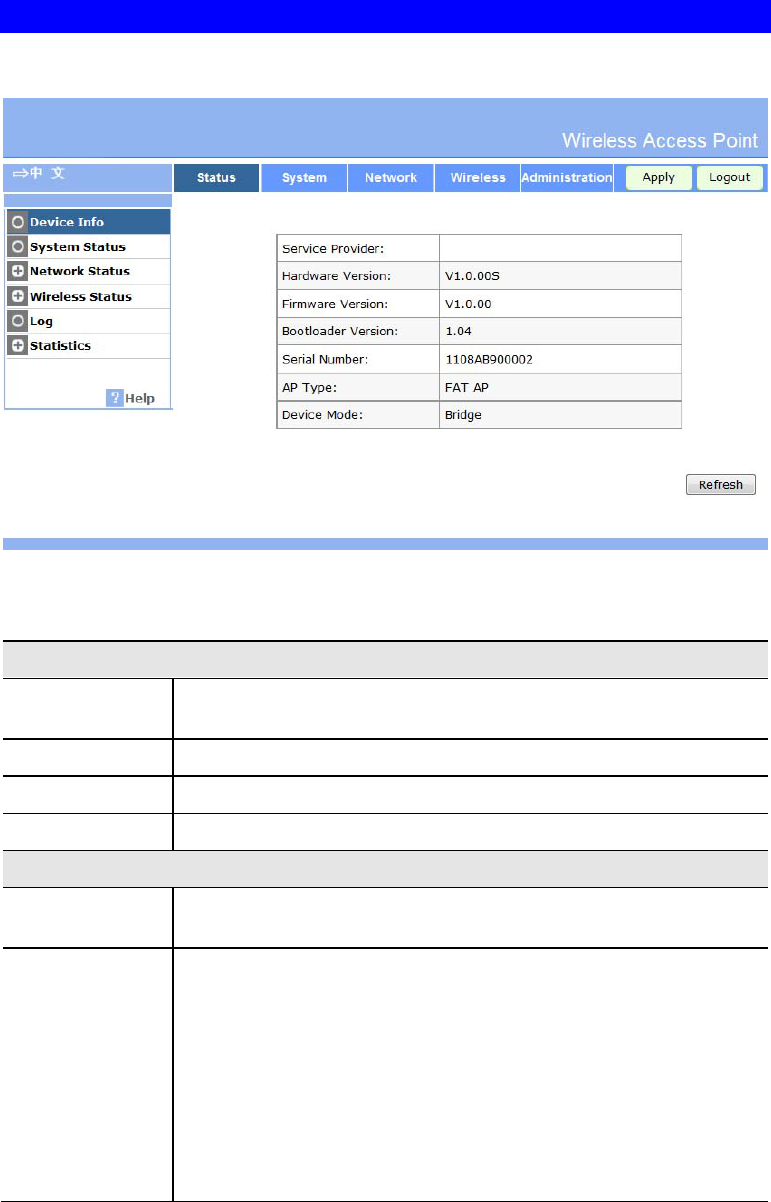
Access Point Setup
13
System Basic Settings Screen
Click Basic Settings on the System menu to view a screen like the following.
Figure 8: System Basic Settings Screen
Data - System Basic Settings Screen
Identification
Access Point
Name Enter a suitable name for this Access Point.
Description If desired, you can enter a description for the Access Point.
Country Domain The country or domain which is matching your current location.
MAC Address The MAC address is displayed.
IP Settings
DHCP Client Select this option if you have a DHCP Server on your LAN, and you
wish the Access Point to obtain an IP address automatically.
Fixed IP Address If selected, the following data must be entered.
IP Address - The IP Address of this device. Enter an unused IP
address from the address range on your LAN.
Subnet Mask - The Network Mask associated with the IP Address
above. Enter the value used by other devices on your LAN.
Gateway - The IP Address of your Gateway or Router. Enter the
value used by other devices on your LAN.
DNS - Enter the DNS (Domain Name Server) used by PCs on
your LAN.

Wireless Access Point User Guide
14
DHCP Server If Enabled, the Access Point will allocate IP Addresses to PCs
(DHCP clients) on your LAN when they start up. The default (and
recommended) value is Enabled.
The Start IP Address and Finish IP Address fields set the values
used by the DHCP server when allocating IP Addresses to DHCP
clients. This range also determines the number of DHCP clients
supported.
Wins Server
Name/IP Ad-
dress
Enter the server name or IP address of the Wins Server.
TimeZone
TimeZone Choose the Time Zone for your location from the drop-down list. If
your location is currently using Daylight Saving, enable the Adjust for
Daylight Saving Time checkbox.
You must UNCHECK this checkbox when Daylight Saving Time
finishes.
NTP Server
Name/IP Ad-
dress
Enter the server name or IP address of the NTP.
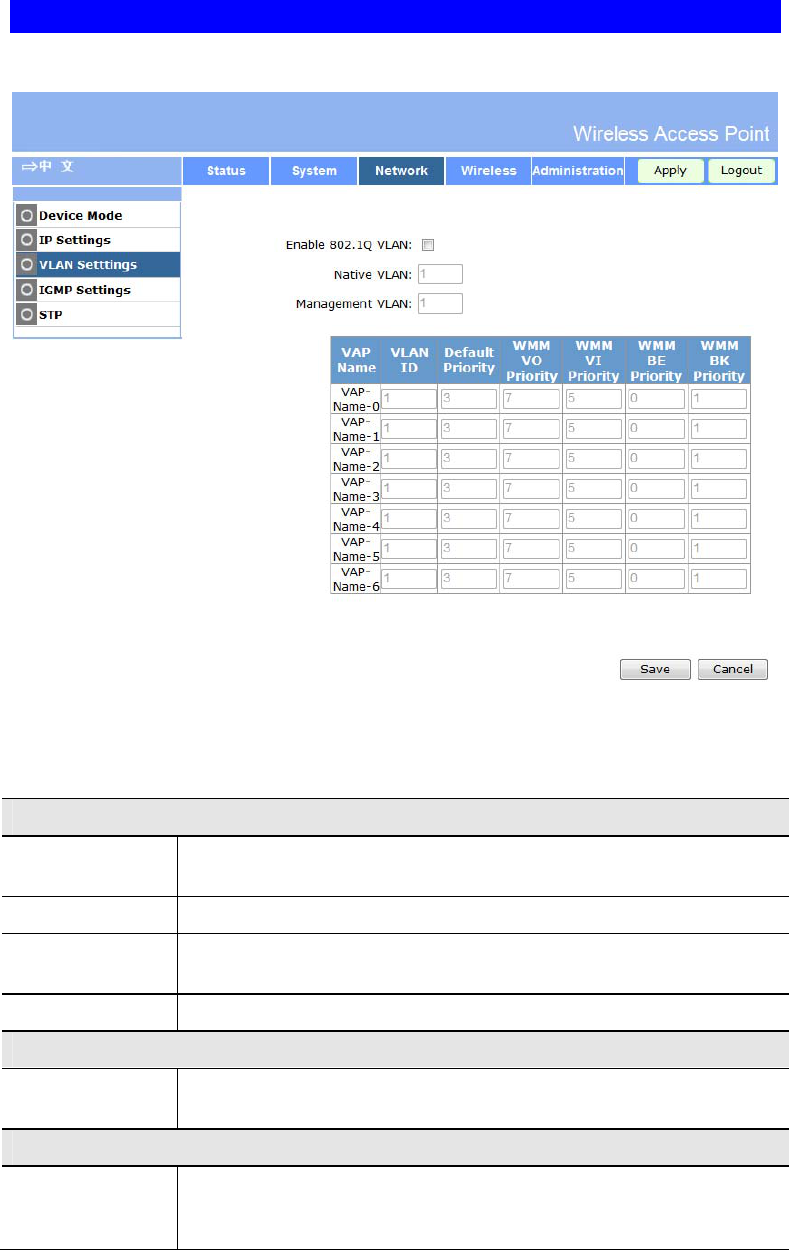
Access Point Setup
15
System Advanced Settings Screen
Click Advanced Settings on the System menu to view a screen like the following.
Figure 9: System Advanced Settings Screen
Data - System Advanced Settings Screen
VLAN
Enable 802.1Q
VLAN This option is only useful if the hubs/switches on your LAN support the
VLAN standard.
Native VLAN Enter the desired value for the Native VLAN. Default value is 1.
AP Management
VLAN Define the VLAN ID used for management.
VLAN List Define the unique ID value (1 - 4094) for each VAP.
Network Integrality Check
Enable Network
Integrality Check If enabled, the AP will disable the wireless connection if the wired
connect of AP is invalid.
Enable Bonjour
Enable Bonjour If checked, the Bonjour will enable applications to discover the devices
and the services on IP networks. Now, this AP only publish http and
https service.

Wireless Access Point User Guide
16
LLTD
Enable Link
Layer Topology
Discovery
Enable this if you want to use Link Layer Topology Discovery protocol
(LLTD) feature.
STP
Enable Spanning
tree Protocol Enable this if you want to use this feature.
802.1x Supplicant
Enable 802.1x
Supplicant Enable this if your network requires this AP to use 802.X authentication
in order to operate.
Authentication Authentication via MAC Address
Select this if you want to Use MAC Address for Authentication.
Authentication via Name and Password
Select this if you want to Use name and password for Authentica-
tion.
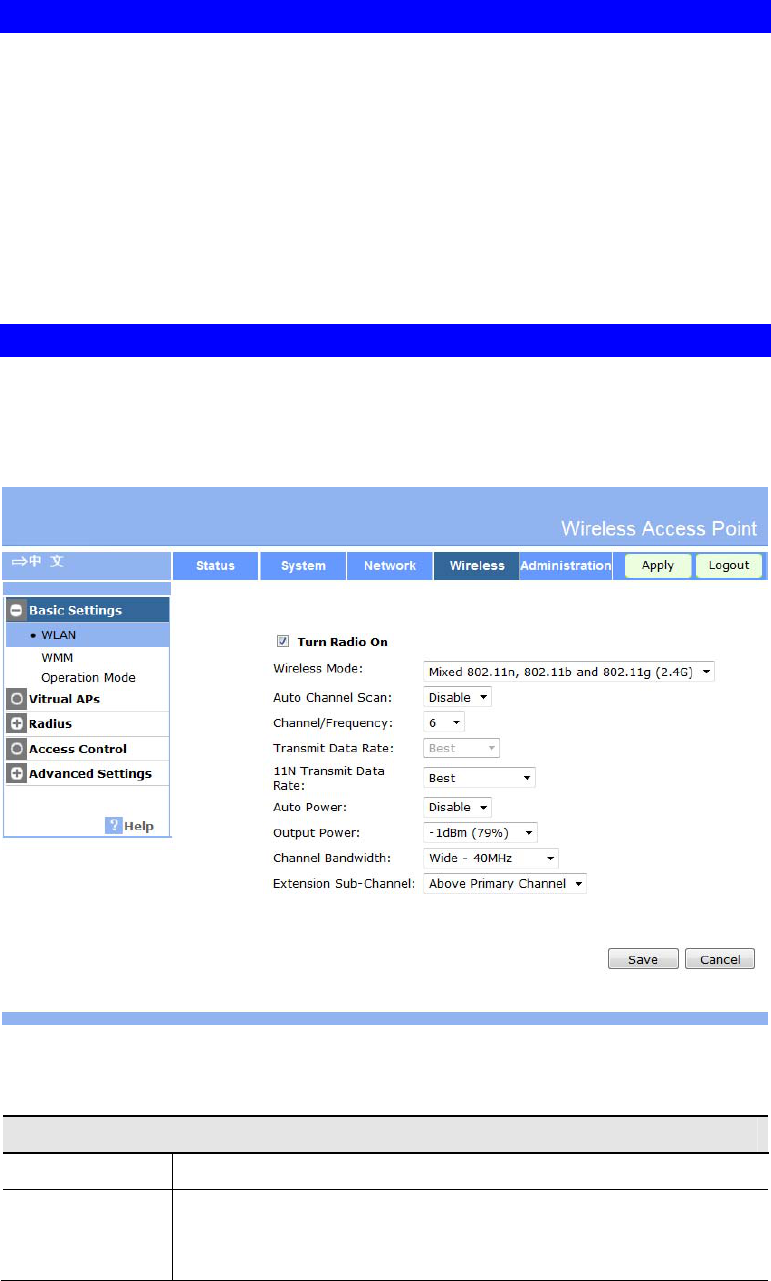
Access Point Setup
17
Wireless Screens
There are 6 configuration screens available:
Basic
Virtual APs
Radius Server Settings
Access Control
Advanced Settings
WIFI Protected Setup
Basic Screen
The settings on this screen must match the settings used by Wireless Stations.
Click Basic Settings on the Wireless menu to view a screen like the following.
Figure 10:Wireless Basic Screen
Data - Wireless Basic Settings Screen
Operation
Turn Radio On Enable this to use the wireless feature.
Wireless Mode Select the desired option:
Disable - select this if for some reason you do not this AP to
transmit or receive at all.

Wireless Access Point User Guide
18
802.11b - if selected, only 802.11b connections are allowed.
802.11g wireless stations will only be able to connect if they are
fully backward-compatible with the 802.11b standard.
802.11g - only 802.11g connections are allowed. If you only have
802.11g, selecting this option may provide a performance im-
provement over using the default setting.
802.11n - only 802.11n connections are allowed. If you only have
802.11n, selecting this option may provide a performance im-
provement over using the default setting.
802.11b and 802.11g - this will allow connections by both
802.11b and 802.11g wireless stations.
802.11n and 802.11g - this will allow connections by both
802.11n and 802.11g wireless stations.
Mixed 802.11n/802.11g/802.11b - this is the default, and will
allow connections by 802.11n, 802.11b and 802.11g wireless sta-
tions.
Auto Channel
Scan If "Enable" is selected, the Access Point will select the best available
Channel.
Channel
/Frequency If you experience interference (shown by lost connections and/or slow
data transfers) you may need to experiment with manually setting
different channels to see which is the best.
Channel Band-
width Select the desired bandwidth from the list.
Extension
Sub-Channel Select Above or Below Primary Channel from the list.

Access Point Setup
19
Operation Mode Select the desired mode:
Access Point - operate as a normal Access Point
Bridge (Point-to-Point) - Bridge to a single AP. You must
provide the MAC address of the other AP in the PTP Bridge AP
MAC Address field.
Bridge (Multi-Point) - Select this only if this AP is the "Master"
for a group of Bridge-mode APs. The other Bridge-mode APs
must be set to Point-to-Point Bridge mode, using this AP's MAC
address. They then send all traffic to this "Master".
Wireless Client/Repeater - Act as a client or repeater for another
Access Point. If selected, you must provide Remote SSID and the
address (MAC address) of the other AP in the Remote AP MAC
Address field. In this mode, all traffic is sent to the specified AP.
Wireless Detection - This mode will turn the access point into a
wireless Monitor. A "Rouge AP" is an Access Point which should
not be in use, and so can be considered to be providing unauthor-
ized access to your LAN.
No Security - If checked, then any AP operating with security
disabled is considered to be a Rogue AP.
Not in Legal AP List - If checked, then any AP not listed in
the "Legal AP List" is considered to be a Rogue AP. If
checked, you must maintain the Legal AP List.
Define Legal AP - Click this to open a sub-screen where you
can modify the "Legal AP List". This list must contain all
known APs, so must be kept up to date.
Remote MAC
Address You must enter the MAC address(es) of other AP(s) in the fields.
Select Remote
AP If the other AP is on-line, you can click the "Select Remote AP" button
and select from a list of available APs.
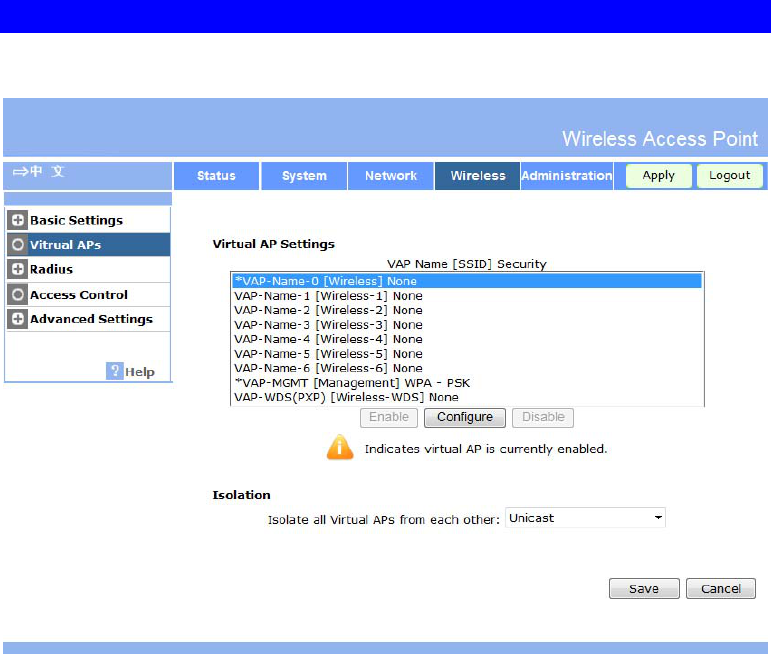
Wireless Access Point User Guide
20
Virtual AP Settings
Clicking the Virtual APs link on the Wireless menu will result in a screen like the following.
Figure 11: Virtual AP Settings

Access Point Setup
21
Data - Virtual AP Settings Screen
VAPs
VAP List All available VAPs are listed. For each VAP, the following data
is displayed:
*
If displayed before the name of the VAP, this indicates
the VAP is currently enabled. If not displayed, the
VAP is currently disabled.
VAP Name
The current VAP name is displayed.
[SSID]
The current SSID associated with this VAP.
Security System
The current security system (e.g. WPA-PSK) is dis-
played.
Enable Button Enable the selected VAP.
Configure Button Change the settings for the selected VAP.
Disable Button Disable the selected VAP.
Isolation
Isolate all Virtual APs
from each other If this option is enabled, wireless clients using different VAPs
(different SSIDs) are isolated from each other, so they will
NOT be able to communicate with each other. They will still be
able to communicate with other clients using the same profile,
unless the "Wireless Separation" setting on the "Advanced"
screen has been enabled.
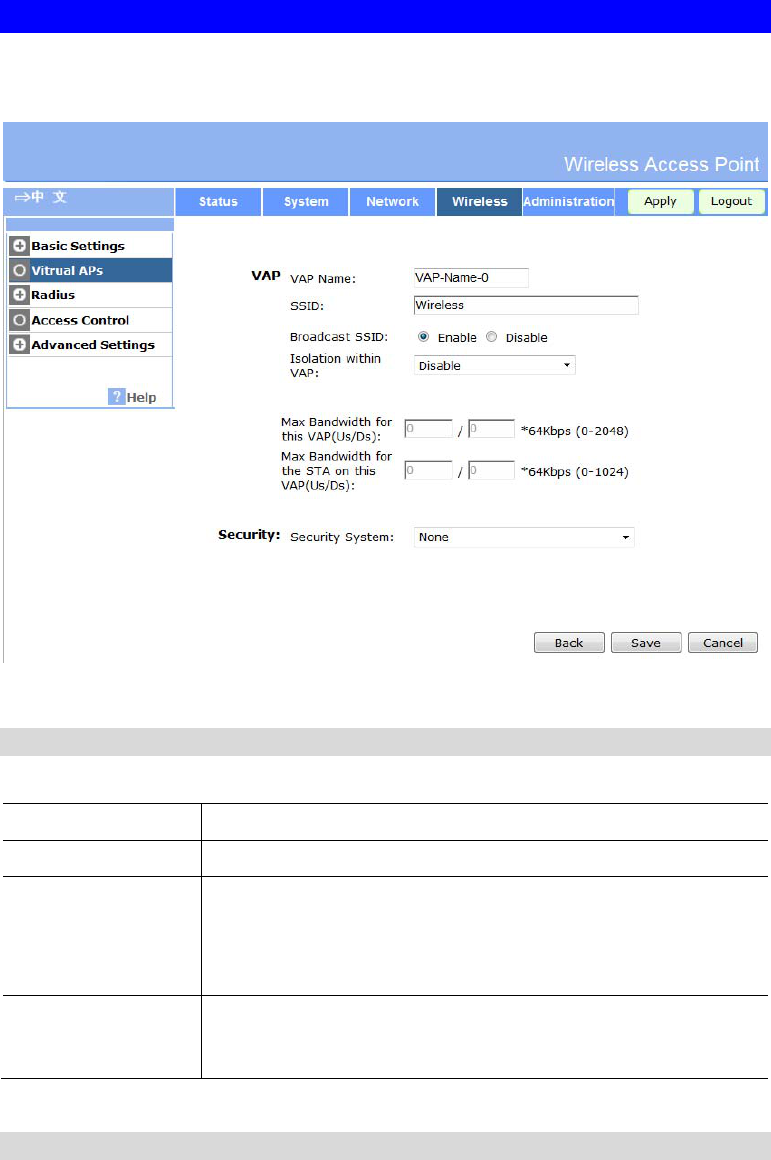
Wireless Access Point User Guide
22
Virtual AP Screen
This screen is displayed when you select a VAP on the Virtual AP Settings screen, and click
the Configure button.
Figure 12: Virtual AP Screen
VAP Data
Enter the desired settings for each of the following:
VAP Name Enter a suitable name for this VAP.
SSID Enter the desired SSID. Each VAP must have a unique SSID.
Broadcast SSID If Disabled, no SSID is broadcast.
If enabled, the SSID will then be broadcast to all Wireless Stations.
Stations which have no SSID (or a "null" value) can then adopt the
correct SSID for connections to this Access Point.
Isolation within
VAP If enabled, then each Wireless station using the Access Point is
invisible to other Wireless stations. In most business stations, this
setting should be Disabled.
Security Settings
Select the desired option, and then enter the settings for the selected method.
The available options are:
None - No security is used. Anyone using the correct SSID can connect to your network.
Access Point Setup
23
WEP - The 802.11b standard. Data is encrypted before transmission, but the encryption
system is not very strong.
WPA-PSK - Like WEP, data is encrypted before transmission. WPA is more secure than
WEP, and should be used if possible. The PSK (Pre-shared Key) must be entered on each
Wireless station. The 256Bit encryption key is derived from the PSK, and changes fre-
quently.
WPA2-PSK - This is a further development of WPA-PSK, and offers even greater securi-
ty, using the AES (Advanced Encryption Standard) method of encryption.
WPA-PSK and WPA2-PSK - This method, sometimes called "Mixed Mode", allows
clients to use EITHER WPA-PSK (with TKIP) OR WPA2-PSK (with AES).
WPA with Radius - This version of WPA requires a Radius Server on your LAN to
provide the client authentication according to the 802.1x standard. Data transmissions are
encrypted using the WPA standard.
If this option is selected:
This Access Point must have a "client login" on the Radius Server.
Each user must have a "user login" on the Radius Server.
Each user's wireless client must support 802.1x and provide the login data when re-
quired.
All data transmission is encrypted using the WPA standard. Keys are automatically
generated, so no key input is required.
WPA2 with Radius - This version of WPA2 requires a Radius Server on your LAN to
provide the client authentication according to the 802.1x standard. Data transmissions are
encrypted using the WPA2 standard.
If this option is selected:
This Access Point must have a "client login" on the Radius Server.
Each user must authenticate on the Radius Server. This is usually done using digital
certificates.
Each user's wireless client must support 802.1x and provide the Radius authentication
data when required.
All data transmission is encrypted using the WPA2 standard. Keys are automatically
generated, so no key input is required.
WPA and WPA2 with Radius - EITHER WPA or WPA2 require a Radius Server on
your LAN to provide the client authentication according to the 802.1x standard. Data
transmissions are encrypted using EITHER WPA or WPA2 standard.
If this option is selected:
This Access Point must have a "client login" on the Radius Server.
Each user must authenticate on the Radius Server. This is usually done using digital
certificates.
Each user's wireless client must support 802.1x and provide the Radius authentication
data when required.
All data transmission is encrypted using EITHER WPA or WPA2 standard. Keys are
automatically generated, so no key input is required.
802.1x - This uses the 802.1x standard for client authentication, and WEP for data encryp-
tion.
If this option is selected:
This Access Point must have a "client login" on the Radius Server.
Each user must have a "user login" on the Radius Server.
Wireless Access Point User Guide
24
Each user's wireless client must support 802.1x and provide the login data when re-
quired.
All data transmission is encrypted using the WEP standard. You only have to select
the WEP key size; the WEP key is automatically generated.
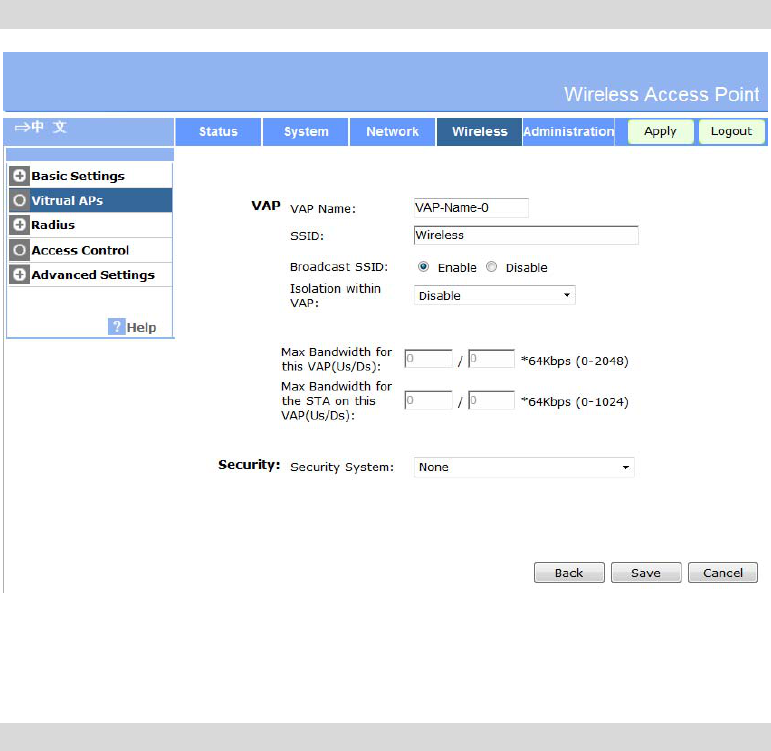
Access Point Setup
25
Security Settings - None
Figure 13: Wireless Security - None
No security is used. Anyone using the correct SSID can connect to your network.
Security Settings - WEP
This is the 802.11b standard. Data is encrypted before transmission, but the encryption system
is not very strong.
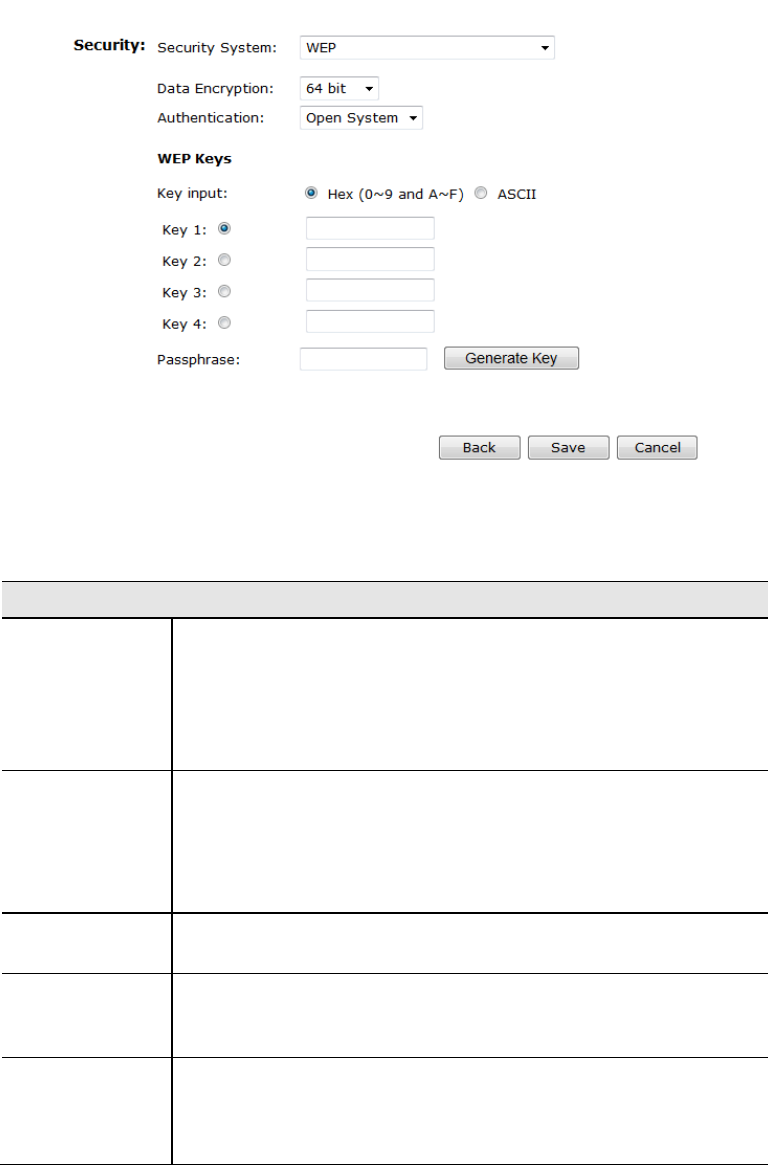
Wireless Access Point User Guide
26
Figure 14: WEP Wireless Security Screen
Data - WEP Screen
WEP
Data
Encryption Select the desired option, and ensure your Wireless stations have the
same setting:
64 Bit Encryption - Keys are 10 Hex (5 ASCII) characters.
128 Bit Encryption - Keys are 26 Hex (13 ASCII) characters.
152 Bit Encryption - Keys are 32 Hex (16 ASCII) characters.
Authentication Normally, you can leave this at “Automatic”, so that Wireless Stations
can use either method ("Open System" or "Shared Key".).
If you wish to use a particular method, select the appropriate value -
"Open System" or "Shared Key". All Wireless stations must then be set
to use the same method.
Key Input Select "Hex" or "ASCII" depending on your input method. (All keys
are converted to Hex, ASCII input is only for convenience.)
Key Value Enter the key values you wish to use. The default key, selected by the
radio button, is required. The other keys are optional. Other stations
must have matching key values.
Passphrase Use this to generate a key or keys, instead of entering them directly.
Enter a word or group of printable characters in the Passphrase box
and click the "Generate Key" button to automatically configure the
WEP Key(s).
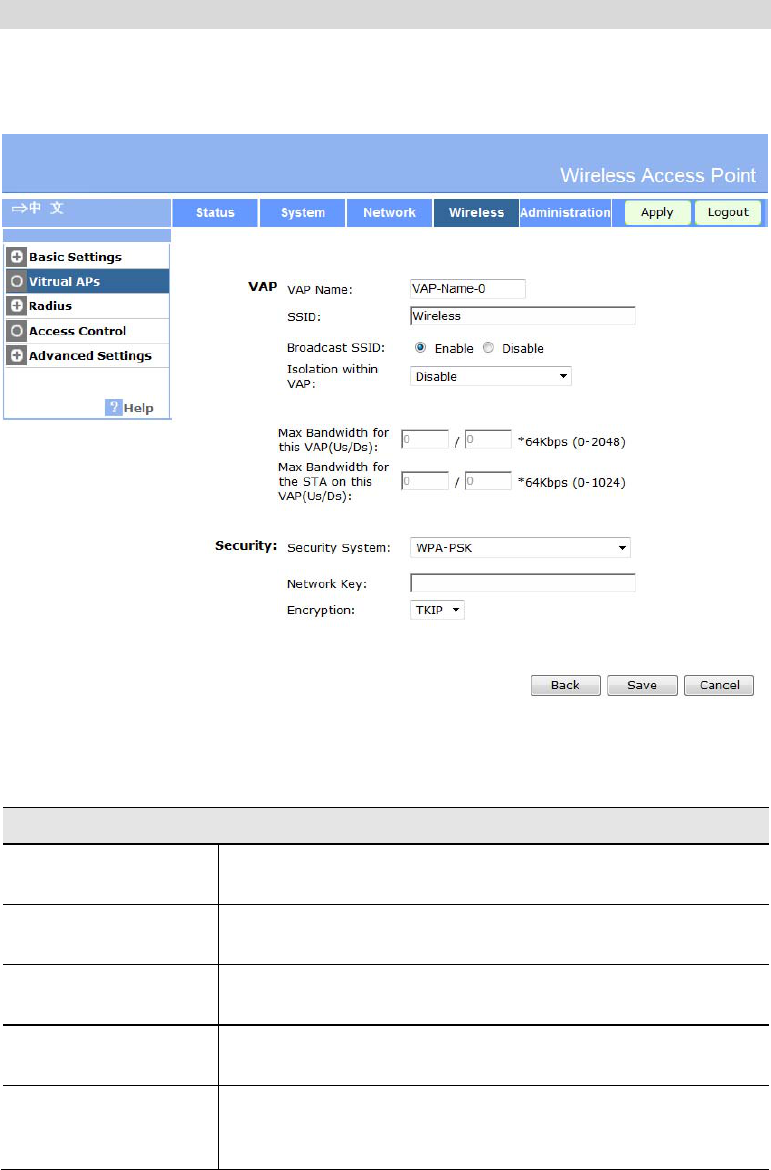
Access Point Setup
27
Security Settings - WPA-PSK
Like WEP, data is encrypted before transmission. WPA is more secure than WEP, and should
be used if possible. The PSK (Pre-shared Key) must be entered on each Wireless station. The
256Bit encryption key is derived from the PSK, and changes frequently.
Figure 15: WPA-PSK Wireless Security Screen
Data - WPA-PSK Screen
WPA-PSK
Network Key Enter the key value. Data is encrypted using a 256Bit key derived
from this key. Other Wireless Stations must use the same key.
WPA Encryption The encryption method is TKIP. Wireless Stations must also use
TKIP.
Group Key Update This refers to the key used for broadcast transmissions. Enable
this if you want the keys to be updated regularly.
Key Lifetime This field determines how often the Group key is dynamically
updated. Enter the desired value.
Update Group key
when any membership
terminates
If enabled, the Group key will be updated whenever any member
leaves the group or disassociates from the Access Point.
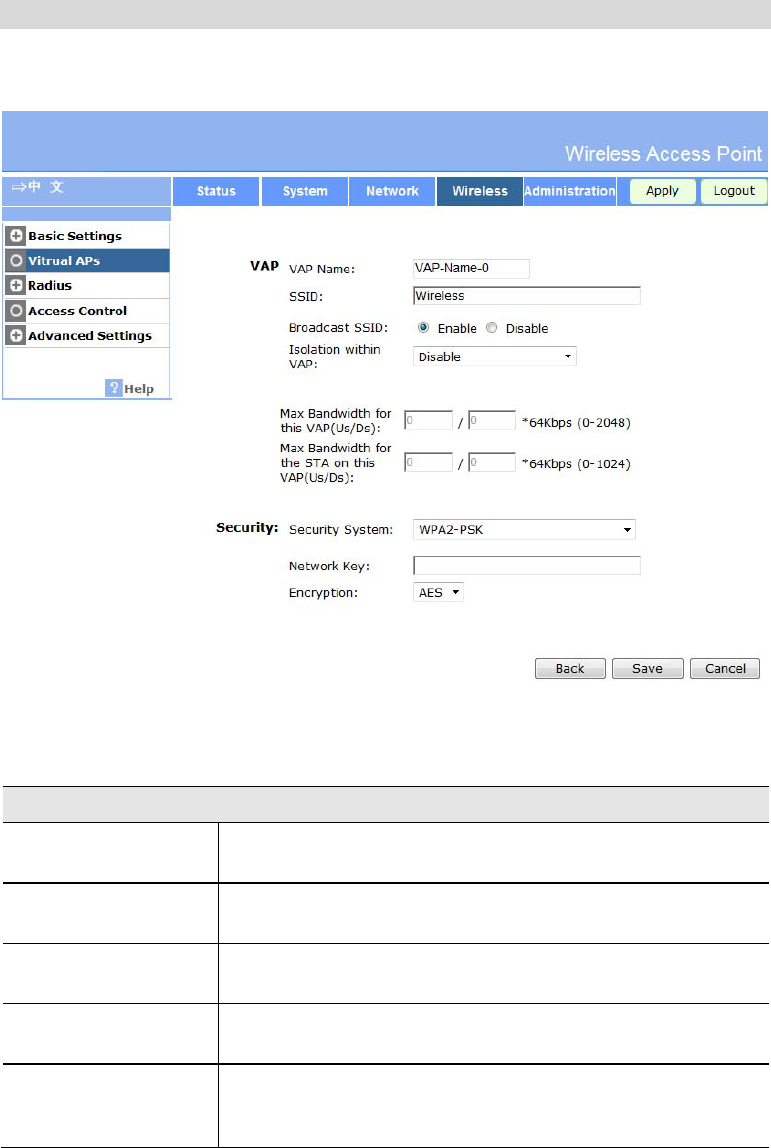
Wireless Access Point User Guide
28
Security Settings - WPA2-PSK
This is a further development of WPA-PSK, and offers even greater security, using the AES
(Advanced Encryption Standard) method of encryption.
Figure 16: WPA2-PSK Wireless Security Screen
Data - WPA2-PSK Screen
WPA2-PSK
Network Key Enter the key value. Data is encrypted using a 256Bit key derived
from this key. Other Wireless Stations must use the same key.
WPA Encryption The encryption method is AES. Wireless Stations must also use
AES.
Group Key Update This refers to the key used for broadcast transmissions. Enable
this if you want the keys to be updated regularly.
Key Lifetime This field determines how often the Group key is dynamically
updated. Enter the desired value.
Update Group key
when any membership
terminates
If enabled, the Group key will be updated whenever any member
leaves the group or disassociates from the Access Point.
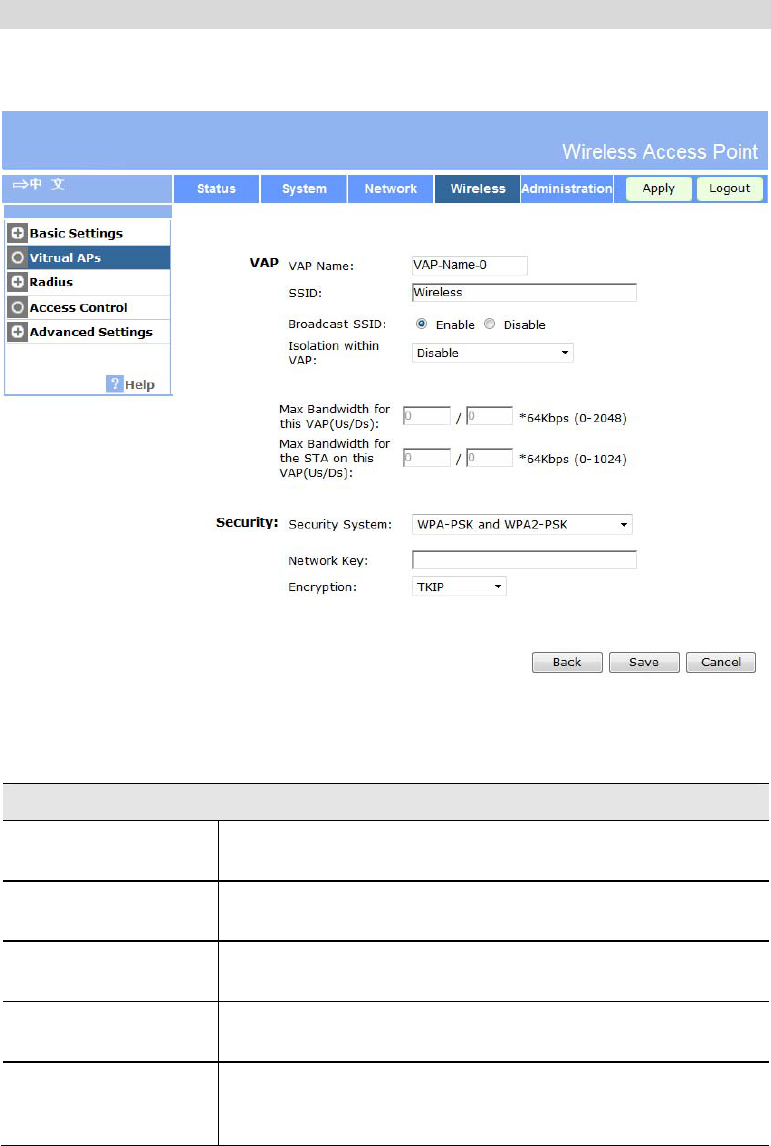
Access Point Setup
29
Security Settings - WPA-PSK and WPA2-PSK
This method, sometimes called "Mixed Mode", allows clients to use EITHER WPA-PSK (with
TKIP) OR WPA2-PSK (with AES).
Figure 17: WPA-PSK and WPA2-PSK Wireless Security Screen
Data - WPA-PSK and WPA2-PSK Screen
WPA-PSK and WPA2-PSK
Network Key Enter the key value. Data is encrypted using this key. Other
Wireless Stations must use the same key.
WPA Encryption The encryption method is TKIP for WPA-PSK, and AES for
WPA2-PSK.
Group Key Update This refers to the key used for broadcast transmissions. Enable
this if you want the keys to be updated regularly.
Key Lifetime This field determines how often the Group key is dynamically
updated. Enter the desired value.
Update Group key
when any membership
terminates
If enabled, the Group key will be updated whenever any member
leaves the group or disassociates from the Access Point.
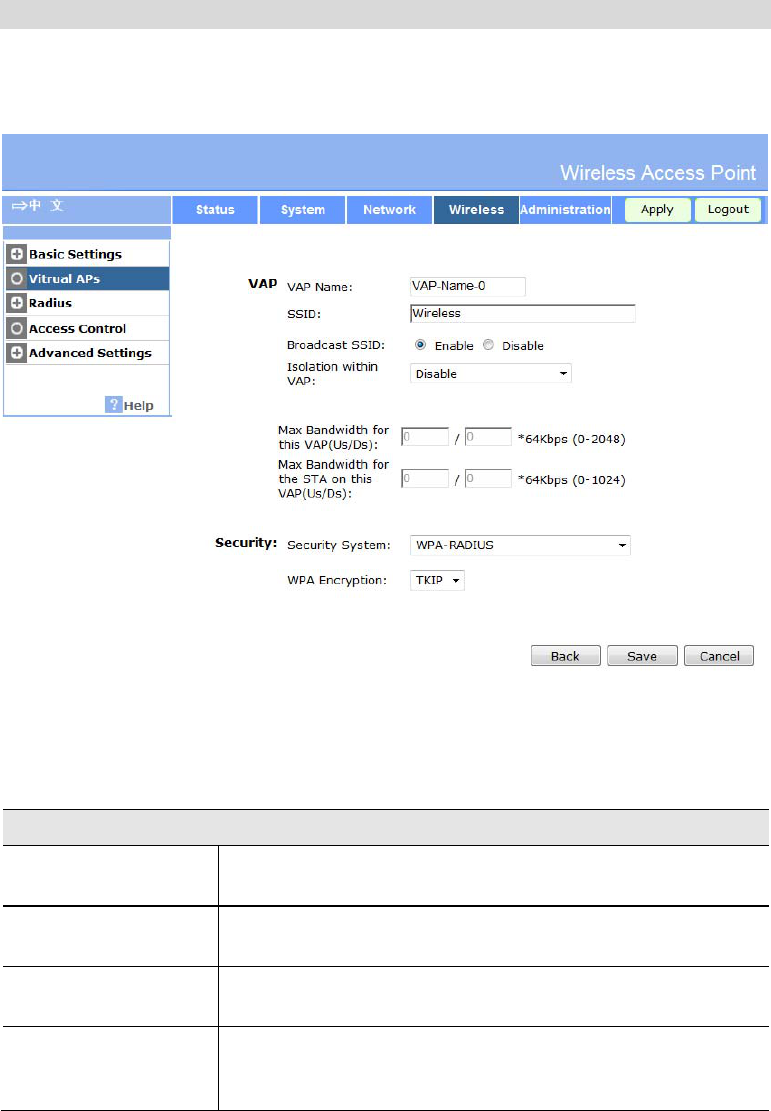
Wireless Access Point User Guide
30
Security Settings - WPA with Radius
This version of WPA requires a Radius Server on your LAN to provide the client authentica-
tion according to the 802.1x standard. Data transmissions are encrypted using the WPA
standard.
Figure 18: WPA with Radius Wireless Security Screen
Data - WPA with Radius Screen
WPA with Radius
WPA Encryption The encryption method is TKIP. Wireless Stations must also use
TKIP.
Group Key Update This refers to the key used for broadcast transmissions. Enable
this if you want the keys to be updated regularly.
Key Lifetime This field determines how often the Group key is dynamically
updated. Enter the desired value.
Update Group key
when any membership
terminates
If enabled, the Group key will be updated whenever any member
leaves the group or disassociates from the Access Point.
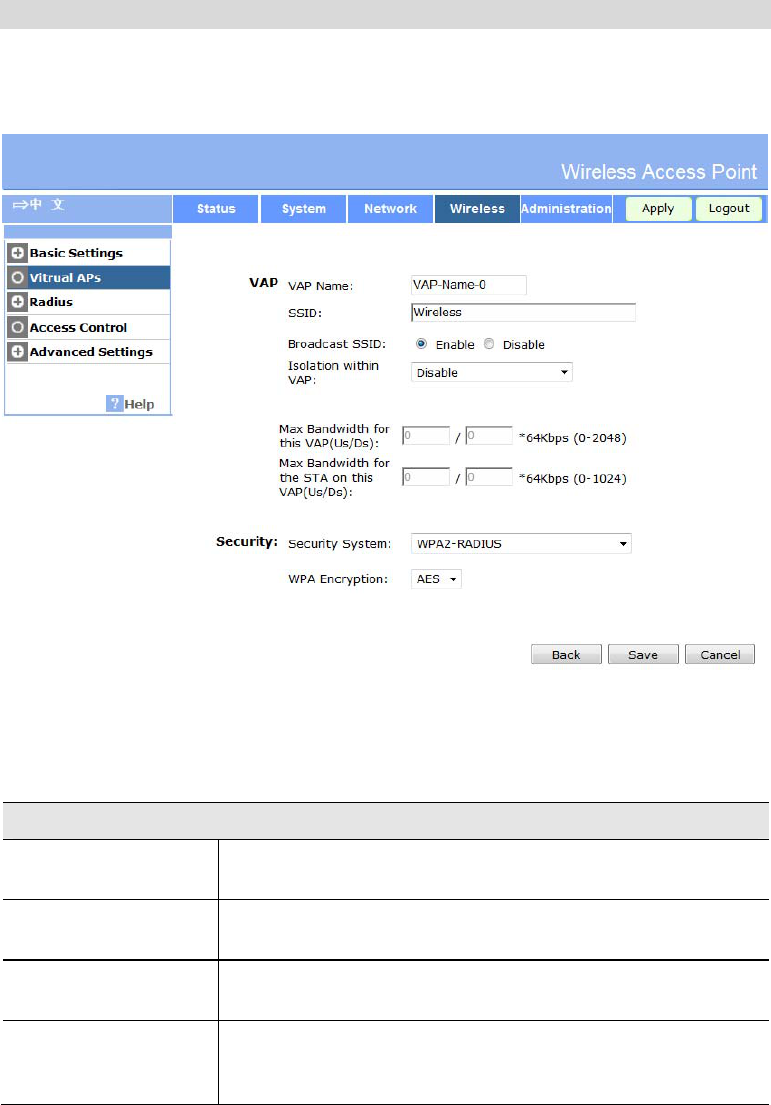
Access Point Setup
31
Security Settings - WPA2 with Radius
This version of WPA2 requires a Radius Server on your LAN to provide the client authentica-
tion according to the 802.1x standard. Data transmissions are encrypted using the WPA2
standard.
Figure 19: WPA2 with Radius Wireless Security Screen
Data - WPA2 with Radius Screen
WPA2 with Radius
WPA Encryption The encryption method is AES. Wireless Stations must also use
AES.
Group Key Update This refers to the key used for broadcast transmissions. Enable
this if you want the keys to be updated regularly.
Key Lifetime This field determines how often the Group key is dynamically
updated. Enter the desired value.
Update Group key
when any membership
terminates
If enabled, the Group key will be updated whenever any member
leaves the group or disassociates from the Access Point.
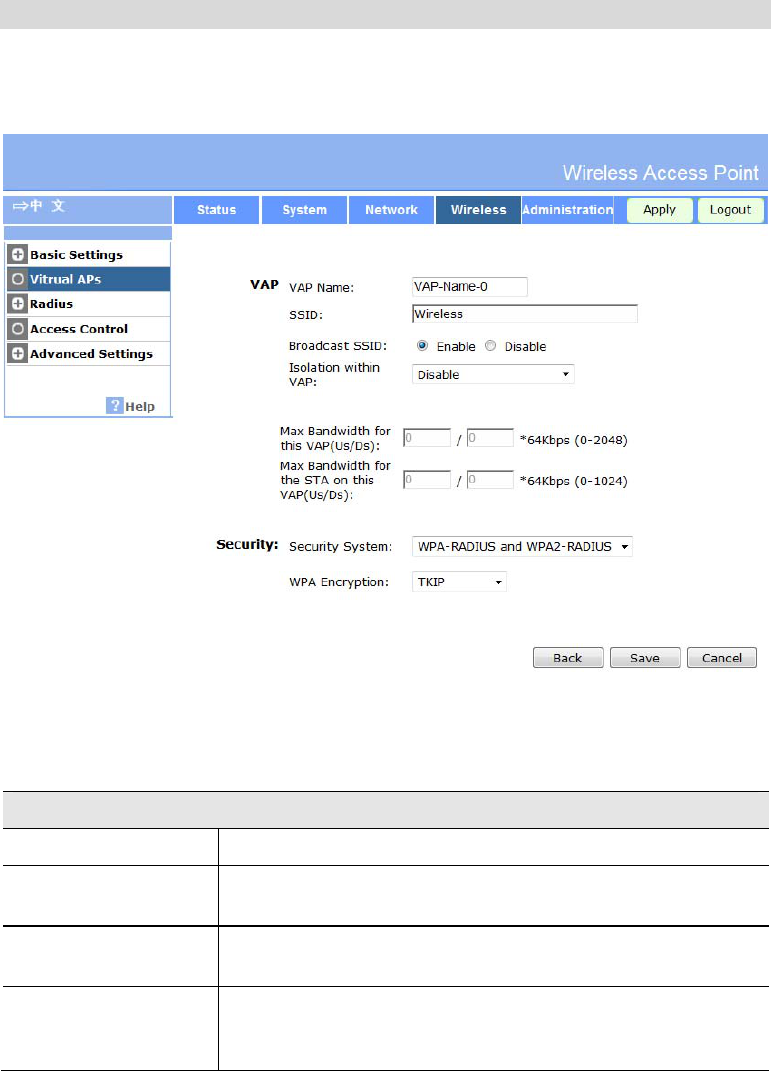
Wireless Access Point User Guide
32
Security Settings - WPA and WPA2 with Radius
EITHER WPA or WPA2 require a Radius Server on your LAN to provide the client authenti-
cation according to the 802.1x standard. Data transmissions are encrypted using EITHER
WPA or WPA2 standard.
Figure 20: WPA and WPA2 with Radius Wireless Security Screen
Data - WPA and WPA2 with Radius Screen
WPA and WPA2 with Radius
WPA Encryption The encryption method is TKIP for WPA, and AES for WPA2.
Group Key Update This refers to the key used for broadcast transmissions. Enable
this if you want the keys to be updated regularly.
Key Lifetime This field determines how often the Group key is dynamically
updated. Enter the desired value.
Update Group key
when any membership
terminates
If enabled, the Group key will be updated whenever any member
leaves the group or disassociates from the Access Point.
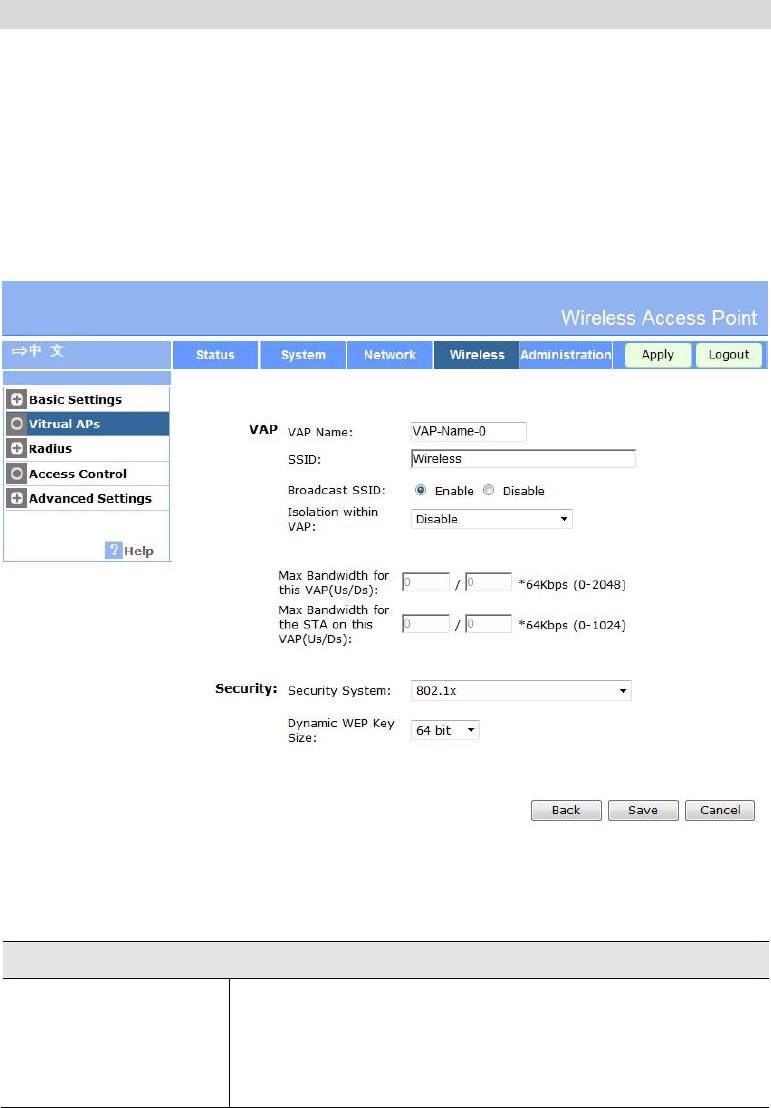
Access Point Setup
33
Security Settings - 802.1x
This uses the 802.1x standard for client authentication, and WEP for data encryption. If this
option is selected:
This Access Point must have a "client login" on the Radius Server.
Each user must have a "user login" on the Radius Server. Normally, a Certificate is used to
authenticate each user. See Chapter4 for details of user configuration.
Each user's wireless client must support 802.1x.
All data transmission is encrypted using the WEP standard. You only have to select the
WEP key size; the WEP key is automatically generated.
Figure 21: 802.1x Wireless Security Screen
Data - 802.1x Screen
802.1x
WEP Key Size Select the desired option:
64 Bit - Keys are 10 Hex (5 ASCII) characters.
128 Bit - Keys are 26 Hex (13 ASCII) characters.
152 Bit - Keys are 32 Hex (16 ASCII) characters.

Wireless Access Point User Guide
34
Dynamic WEP Key Click this if you want the WEP keys to be automatically gener-
ated.
The key exchange will be negotiated. The most widely
supported protocol is EAP-TLS.
The following Key Exchange setting determines how often
the keys are changed.
Both Dynamic and Static keys can be used simultaneously,
allowing clients using either method to use the Access
Point.
Key Exchange This setting if only available if using Dynamic WEP Keys. If
you want the Dynamic WEP keys to be updated regularly,
enable this and enter the desired lifetime (in minutes).
Static WEP Key
(EAP-MD5) Enable this if some wireless clients use a fixed (static) WEP
key, using EAP-MD5.
Note that both Dynamic and Static keys can be used simultane-
ously, allowing clients using either method to use the Access
Point.
WEP Key Enter the WEP key according to the WEP Key Size setting
above. Wireless stations must use the same key.
WEP Key Index Select the desired index value. Wireless stations must use the
same key index.
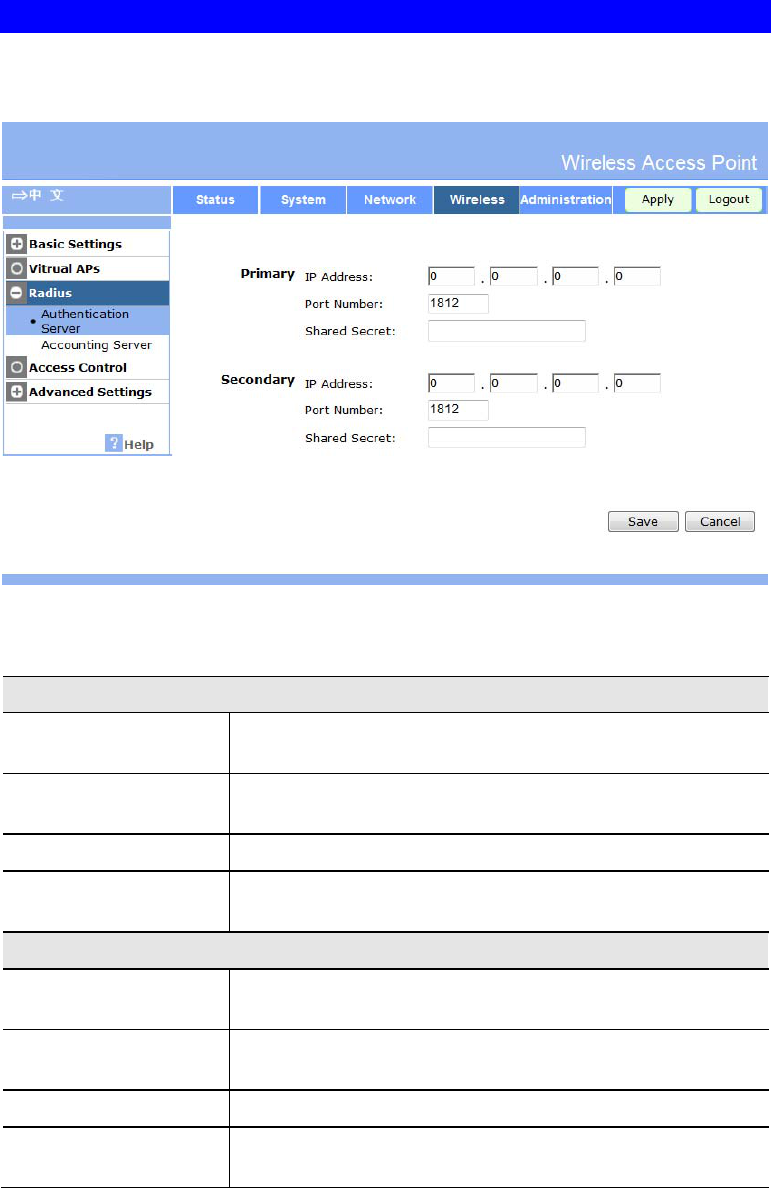
Access Point Setup
35
Radius Server Settings
Clicking the Radius Server Settings link on the Wireless menu will result in a screen like the
following.
Figure 22: Advanced Settings
Data - Radius Server Settings Screen
Authentication Server
Primary Authentica-
tion Server Enter the name or IP address of the Radius Server on your
network.
Port Number Enter the port number used for connections to the Radius
Server.
Shared Secret Enter the key value to match the Radius Server.
Secondary Authentica-
tion Server The Secondary Authentication Server will be used when the
Primary Authentication Server is not available.
Accounting Server
Primary Accounting
Server Enter the IP address in the following fields if you want this
Access Point to send accounting data to the Radius Server.
Port Number The port used by your Radius Server must be entered in the
field.
Shared Secret Enter the key value to match the Radius Server.
Secondary Accounting
Server The Secondary Accounting Server will be used when the
Primary Accounting Server is not available.
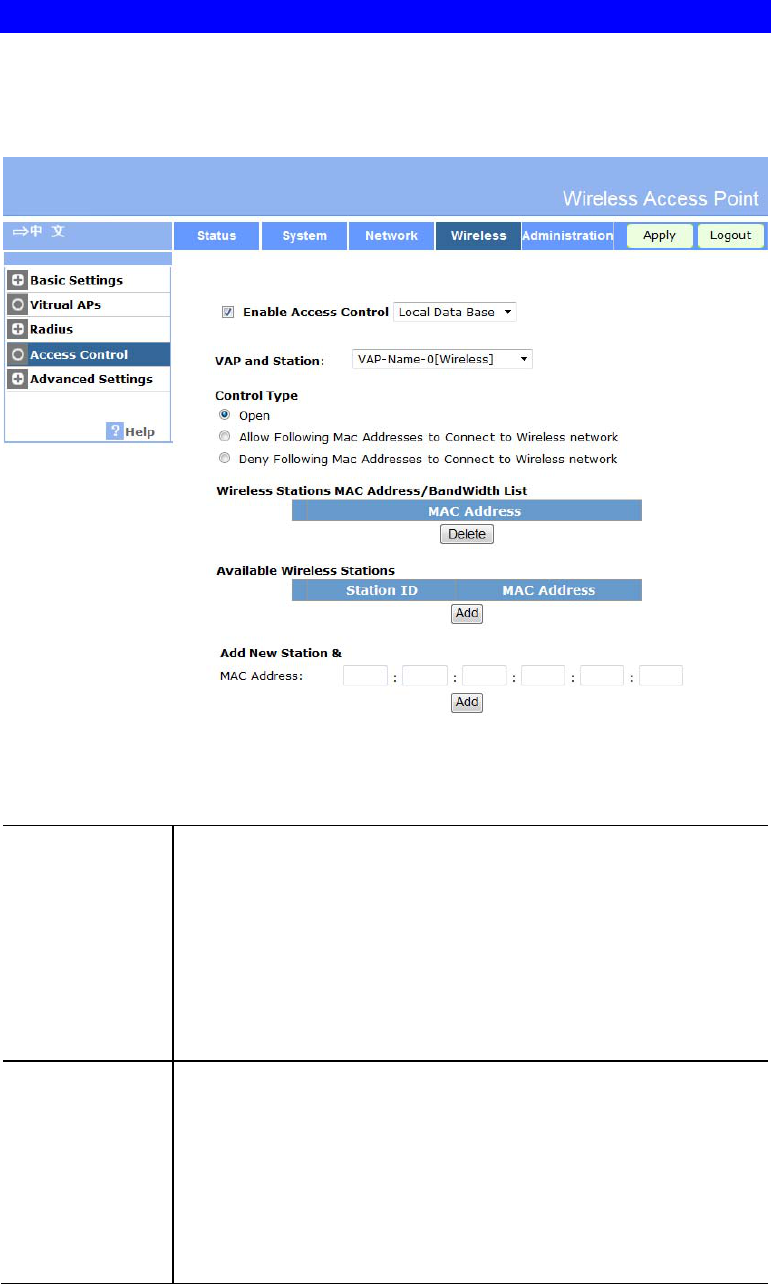
Wireless Access Point User Guide
36
Access Control
This feature can be used to block access to your LAN by unknown or untrusted wireless
stations.
Click Access Control on the Wireless menu to view a screen like the following.
Figure 23: Access Control Screen
Data - Access Control Screen
Access Control Select the desired option, as required
Disabled - The Access Control feature is disabled.
Local - Select Allow only following MAC addresses or Deny
following MAC addresses.
Radius - The Access Point will use the MAC address table located
on the external Radius server on the LAN for Access Control.
Warning! Ensure your own PC is in the "Trusted Wireless Stations"
list before enabling this feature.
Local Trusted
Stations This table lists any Wireless Stations you have designated as "Trust-
ed". If you have not added any stations, this table will be empty. For
each Wireless station, the following data is displayed:
Name - the name of the Wireless station.
MAC Address - the MAC or physical address of each Wireless
station.
Connected - this indicates whether or not the Wireless station is
currently associates with this Access Point.
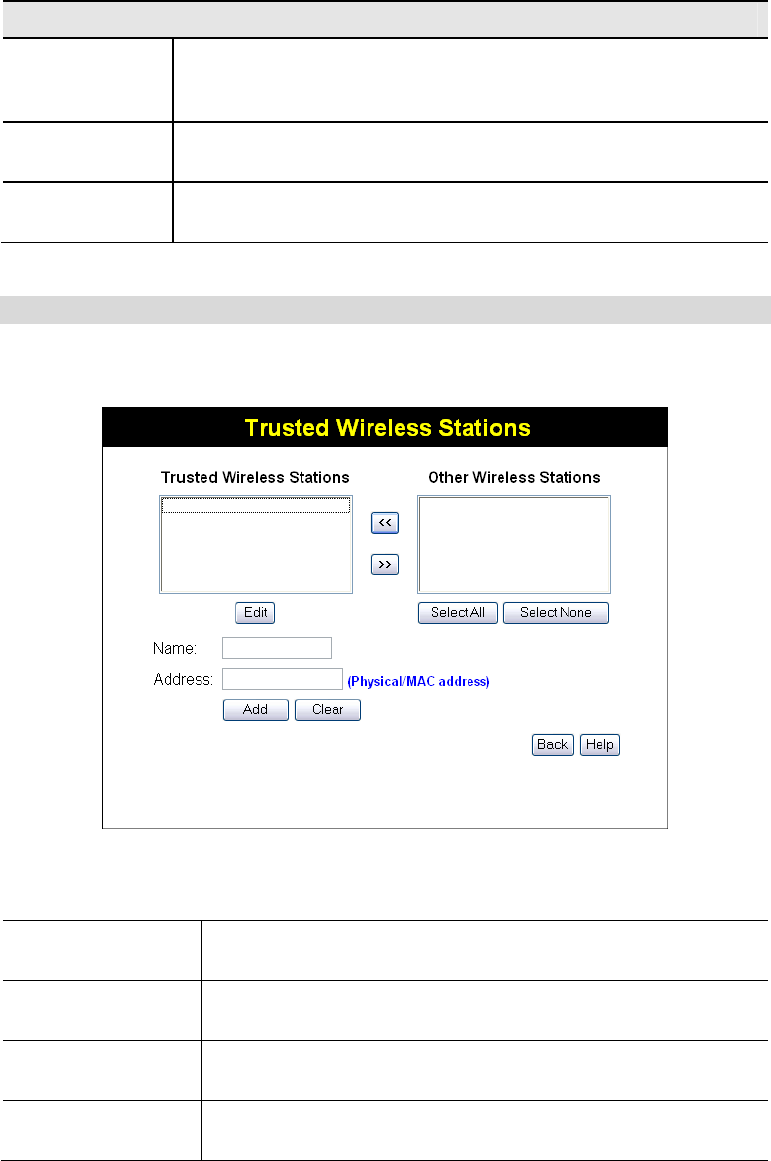
Access Point Setup
37
Buttons
Modify List To change the list of Trusted Stations (Add, Edit, or Delete a Wireless
Station or Stations), click this button. You will then see the Trusted
Wireless Stations screen, described below.
Read from File To upload a list of Trusted Stations from a file on your PC, click this
button.
Write to File To download the current list of Trusted Stations from the Access Point
to a file on your PC, click this button.
Trusted Wireless Stations
To change the list of trusted wireless stations, use the Modify List button on the Access Control
screen. You will see a screen like the sample below.
Figure 24: Trusted Wireless Stations
Data - Trusted Wireless Stations
Trusted Wireless
Stations This lists any Wireless Stations which you have designated as
“Trusted”.
Other Wireless
Stations This list any Wireless Stations detected by the Access Point, which
you have not designated as "Trusted".
Name The name assigned to the Trusted Wireless Station. Use this when
adding or editing a Trusted Station.
Address The MAC (physical) address of the Trusted Wireless Station. Use
this when adding or editing a Trusted Station.

Wireless Access Point User Guide
38
Buttons
<< Add a Trusted Wireless Station to the list (move from the "Other
Stations" list).
Select an entry (or entries) in the "Other Stations" list, and
click the " << " button.
Enter the Address (MAC or physical address) of the wireless
station, and click the "Add " button.
>> Delete a Trusted Wireless Station from the list (move to the "Other
Stations" list).
Select an entry (or entries) in the "Trusted Stations" list.
Click the " >> " button.
Select All Select all of the Stations listed in the "Other Stations" list.
Select None De-select any Stations currently selected in the "Other Stations"
list.
Edit To change an existing entry in the "Trusted Stations" list, select it
and click this button.
1. Select the Station in the "Trusted Station" list.
2. Click the "Edit" button. The address will be copied to the
"Address" field, and the "Add" button will change to "Update".
3. Edit the address (MAC or physical address) as required.
4. Click "Update" to save your changes.
Add To add a Trusted Station which is not in the "Other Wireless
Stations" list, enter the required data and click this button.
Clear Clear the Name and Address fields.
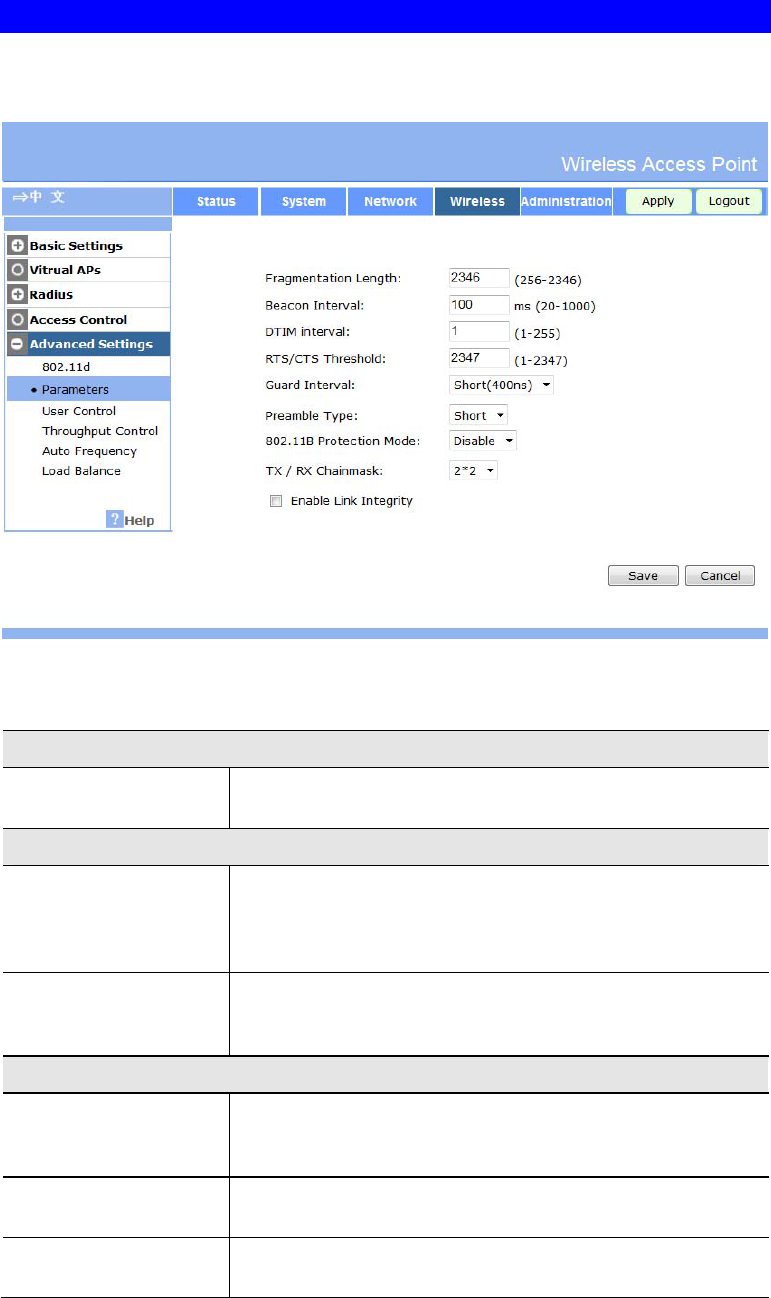
Access Point Setup
39
Advanced Settings
Clicking the Advanced Settings link on the Wireless menu will result in a screen like the
following.
Figure 25: Advanced Settings
Data - Advanced Settings Screen
Options
Worldwide Mode
(802.11d) Enable this setting if you wish to use this mode, and your
Wireless stations support this mode.
WMM
Enable WMM Support Check this to enable WMM (Wi-Fi Multimedia) support in the
Access Point. If WMM is also supported by your wireless
clients, voice and multimedia traffic will be given a higher
priority than other traffic.
No Acknowledgement If enabled, then WMM acknowledgement is disabled. Depend-
ing on the environment, disabling acknowledgement may
increase throughput slightly.
Parameters
Disassociated Timeout This determines how quickly a Wireless Station will be consid-
ered "Disassociated" with this AP, when no traffic is received.
Enter the desired time period.
Fragmentation Length Enter the preferred setting between 256 and 2346. Normally,
this can be left at the default value.
Beacon Interval Enter the preferred setting between 20 and 1000. Normally, this
can be left at the default value.

Wireless Access Point User Guide
40
RTS/CTS Threshold Enter the preferred setting between 1 and 2347. Normally, this
can be left at the default value.
Preamble Type Select the desired option. The default is "Long". The "Short"
setting takes less time when used in a good environment.
802.11b Protection
Mode The Protection system is intended to prevent older 802.11b
devices from interfering with 802.11g transmissions. (Older
802.11b devices may not be able to detect that a 802.11g
transmission is in progress.) Normally, this should be left at
"Auto".

41
Chapter 4
PC and Server Configuration
This Chapter details the PC Configuration required for each PC on the local
LAN.
Overview
All Wireless Stations need to have settings which match the Wireless Access Point. These
settings depend on the mode in which the Access Point is being used.
If using WEP or WPA-PSK, it is only necessary to ensure that each Wireless station's
settings match those of the Wireless Access Point, as described below.
For 802.1x modes, configuration is much more complex. The Radius Server must be
configured correctly, and setup of each Wireless station is also more complex.
Using WEP
For each of the following items, each Wireless Station must have the same settings as the
Wireless Access Point.
Mode On each PC, the mode must be set to Infrastructure.
SSID (ESSID) This must match the value used on the Wireless Access Point.
The default value is wireless
Note! The SSID is case sensitive.
Wireless
Security
Each Wireless station must be set to use WEP data encryption.
The Key size (64 bit, 128 bit, 152 bit) must be set to match the
Access Point.
The keys values on the PC must match the key values on the Access
Point.
Note:
On some systems, the key sizes may be shown as 40bit, 104bit, and
128bit instead of 64 bit, 128 bit and 152bit. This difference arises be-
cause the key input by the user is 24 bits less than the key size used for
encryption.
4

Wireless Access Point User Guide
42
Using WPA-PSK/WPA2-PSK
For each of the following items, each Wireless Station must have the same settings as the
Wireless Access Point.
Mode On each PC, the mode must be set to Infrastructure.
SSID (ESSID) This must match the value used on the Wireless Access Point.
The default value is wireless
Note! The SSID is case sensitive.
Wireless
Security On each client, Wireless security must be set to WPA-PSK.
The Pre-shared Key entered on the Access Point must also be
entered on each Wireless client.
The Encryption method (e.g. TKIP, AES) must be set to match the
Access Point.

PC and Server Configuration
43
Using WPA-Enterprise
This is the most secure and most complex system.
WPA-Enterprise mode provides greater security and centralized management, but it is more
complex to configure.
Wireless Station Configuration
For each of the following items, each Wireless Station must have the same settings as the
Wireless Access Point.
Mode On each PC, the mode must be set to Infrastructure.
SSID (ESSID) This must match the value used on the Wireless Access Point.
The default value is wireless
Note! The SSID is case sensitive.
802.1x
Authentication Each client must obtain a Certificate which is used for authentication for
the Radius Server.
802.1x
Encryption Typically, EAP-TLS is used. This is a dynamic key system, so keys do
NOT have to be entered on each Wireless station.
However, you can also use a static WEP key (EAP-MD5); the Wireless
Access Point supports both methods simultaneously.
Radius Server Configuration
If using WPA-Enterprise mode, the Radius Server on your network must be configured as
follow:
It must provide and accept Certificates for user authentication.
There must be a Client Login for the Wireless Access Point itself.
The Wireless Access Point will use its Default Name as its Client Login name. (How-
ever, your Radius server may ignore this and use the IP address instead.)
The Shared Key, set on the Security Screen of the Access Point, must match the
Shared Secret value on the Radius Server.
Encryption settings must be correct.

Wireless Access Point User Guide
44
802.1x Server Setup (Windows 2000 Server)
This section describes using Microsoft Internet Authentication Server as the Radius Server,
since it is the most common Radius Server available that supports the EAP-TLS authentication
method.
The following services on the Windows 2000 Domain Controller (PDC) are also required:
dhcpd
dns
rras
webserver (IIS)
Radius Server (Internet Authentication Service)
Certificate Authority
Windows 2000 Domain Controller Setup
1. Run dcpromo.exe from the command prompt.
2. Follow all of the default prompts, ensure that DNS is installed and enabled during installa-
tion.
Services Installation
1. Select the Control Panel - Add/Remove Programs.
2. Click Add/Remove Windows Components from the left side.
3. Ensure that the following components are activated (selected):
Certificate Services. After enabling this, you will see a warning that the computer
cannot be renamed and joined after installing certificate services. Select Yes to select
certificate services and continue
World Wide Web Server. Select World Wide Web Server on the Internet Information
Services (IIS) component.
From the Networking Services category, select Dynamic Host Configuration Protocol
(DHCP), and Internet Authentication Service (DNS should already be selected and in-
stalled).
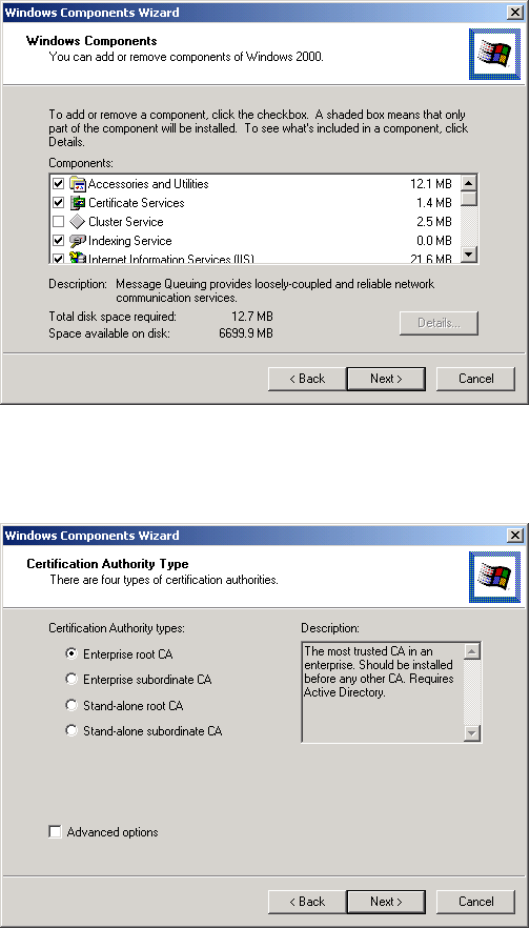
PC and Server Configuration
45
Figure 26: Components Screen
4. Click Next.
5. Select the Enterprise root CA, and click Next.
Figure 27: Certification Screen
6. Enter the information for the Certificate Authority, and click Next.
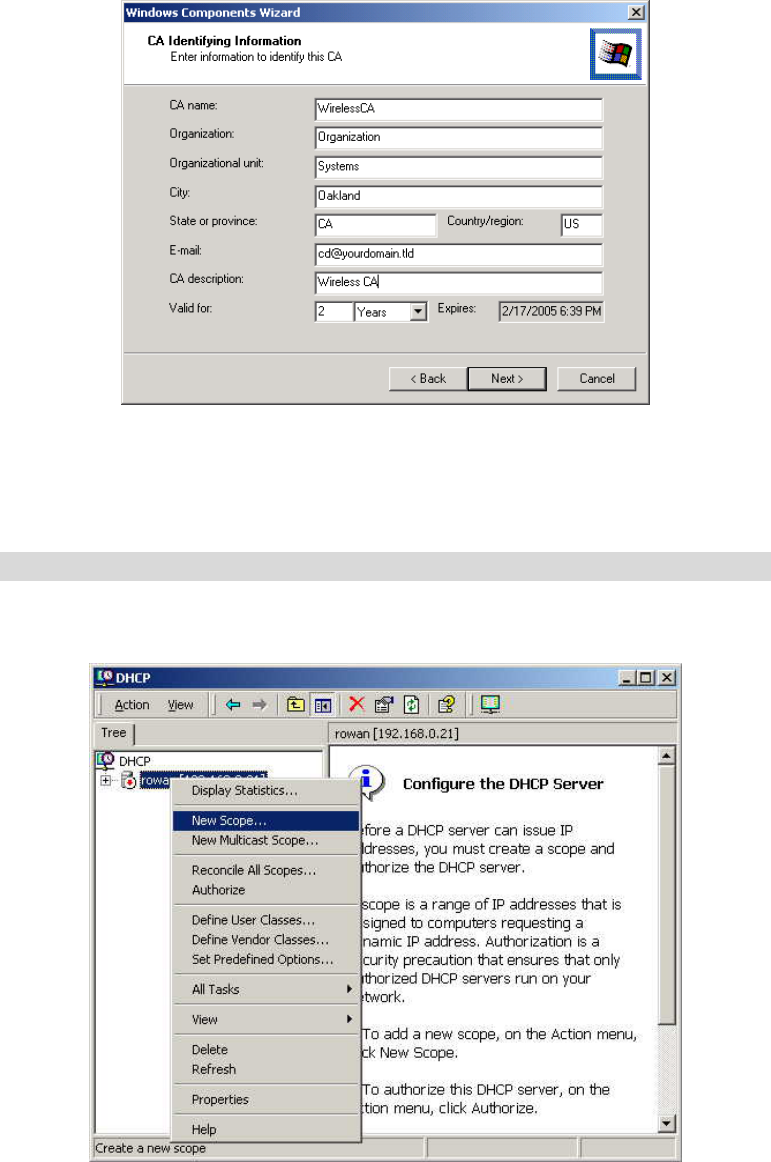
Wireless Access Point User Guide
46
Figure 28: CA Screen
7. Click Next if you don't want to change the CA's configuration data.
8. Installation will warn you that Internet Information Services are running, and must be
stopped before continuing. Click Ok, then Finish.
DHCP server configuration
1. Click on the Start - Programs - Administrative Tools - DHCP
2. Right-click on the server entry as shown, and select New Scope.
Figure 29: DHCP Screen
3. Click Next when the New Scope Wizard Begins.
4. Enter the name and description for the scope, click Next.
5. Define the IP address range. Change the subnet mask if necessary. Click Next.
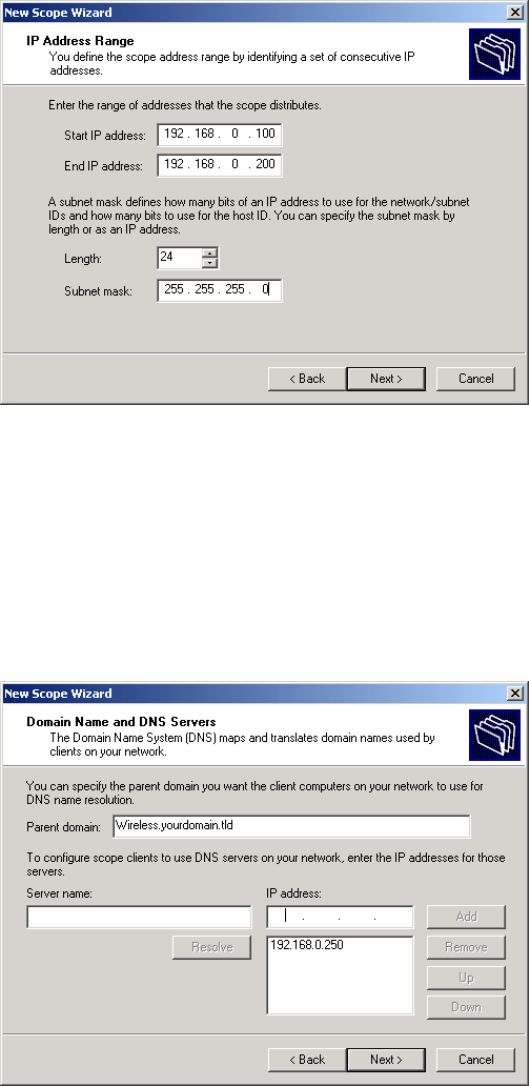
PC and Server Configuration
47
Figure 30:IP Address Screen
6. Add exclusions in the address fields if required. If no exclusions are required, leave it
blank. Click Next.
7. Change the Lease Duration time if preferred. Click Next.
8. Select Yes, I want to configure these options now, and click Next.
9. Enter the router address for the current subnet. The router address may be left blank if
there is no router. Click Next.
10. For the Parent domain, enter the domain you specified for the domain controller setup, and
enter the server's address for the IP address. Click Next.
Figure 31: DNS Screen
11. If you don't want a WINS server, just click Next.
12. Select Yes, I want to activate this scope now. Click Next, then Finish.
13. Right-click on the server, and select Authorize. It may take a few minutes to complete.
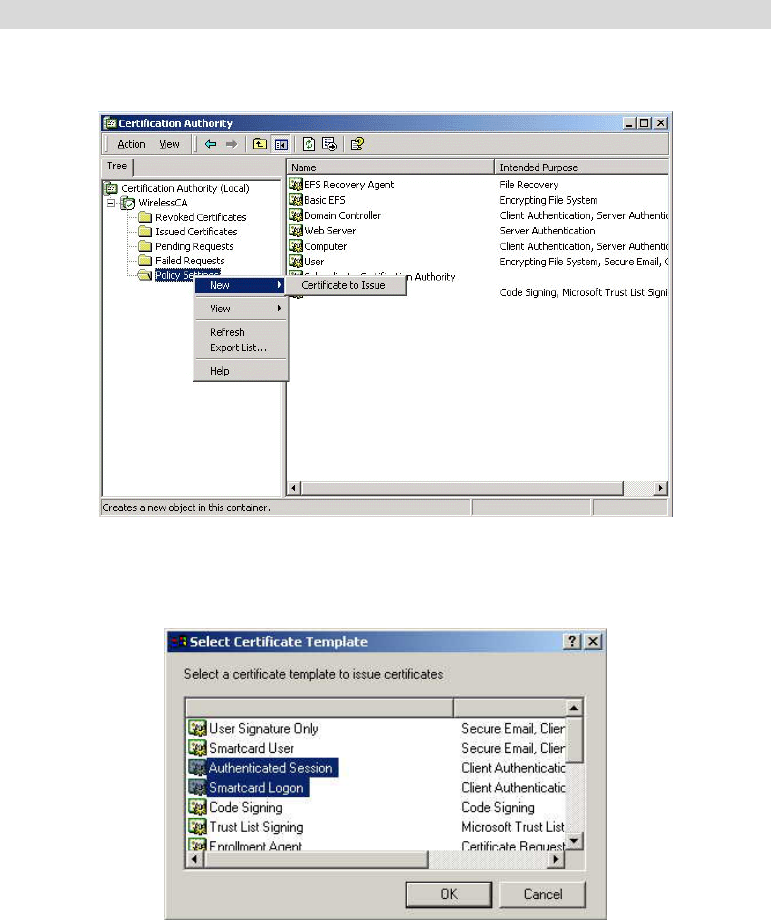
Wireless Access Point User Guide
48
Certificate Authority Setup
1. Select Start - Programs - Administrative Tools - Certification Authority.
2. Right-click Policy Settings, and select New - Certificate to Issue.
Figure 32: Certificate Authority Screen
3. Select Authenticated Session and Smartcard Logon (select more than one by holding down
the Ctrl key). Click OK.
Figure 33: Template Screen
4. Select Start - Programs - Administrative Tools - Active Directory Users and Computers.
5. Right-click on your active directory domain, and select Properties.
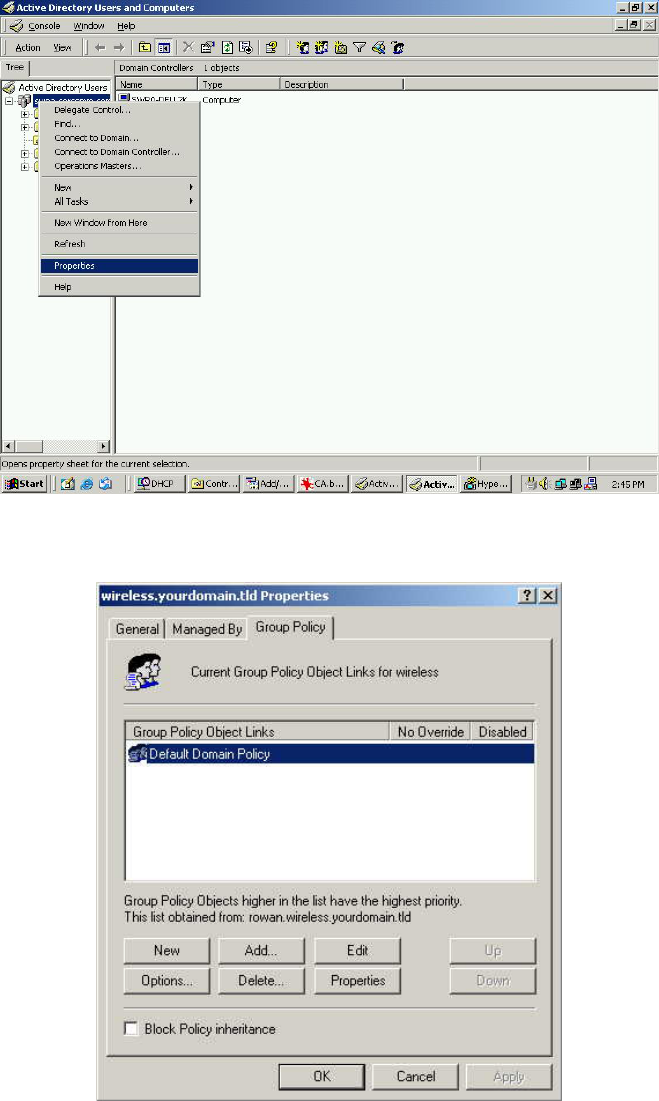
PC and Server Configuration
49
Figure 34: Active Directory Screen
6. Select the Group Policy tab, choose Default Domain Policy then click Edit.
Figure 35: Group Policy Tab
7. Select Computer Configuration - Windows Settings - Security Settings - Public Key
Policies, right-click Automatic Certificate Request Settings - New - Automatic Certificate
Request.
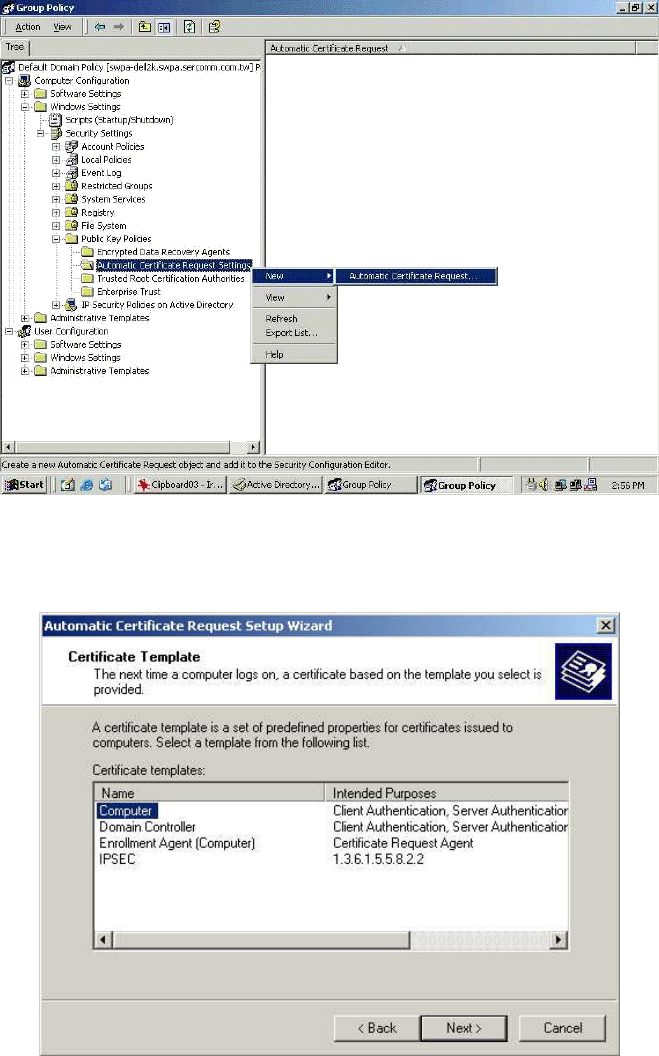
Wireless Access Point User Guide
50
Figure 36: Group Policy Screen
8. When the Certificate Request Wizard appears, click Next.
9. Select Computer, then click Next.
Figure 37: Certificate Template Screen
10. Ensure that your certificate authority is checked, then click Next.
11. Review the policy change information and click Finish.
12. Click Start - Run, type cmd and press enter.
Enter secedit /refreshpolicy machine_policy
This command may take a few minutes to take effect.
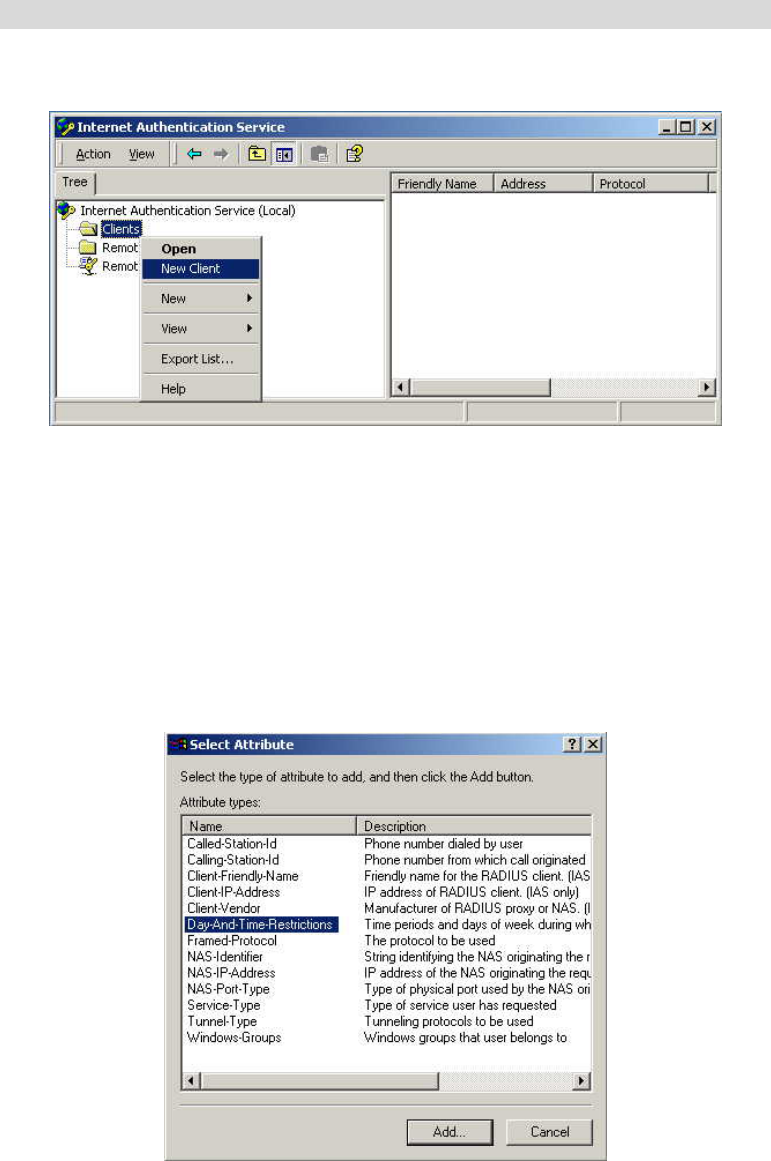
PC and Server Configuration
51
Internet Authentication Service (Radius) Setup
1. Select Start - Programs - Administrative Tools - Internet Authentication Service
2. Right-click on Clients, and select New Client.
Figure 38: Service Screen
3. Enter a name for the access point, click Next.
4. Enter the address or name of the Wireless Access Point, and set the shared secret, as
entered on the Security Settings of the Wireless Access Point.
5. Click Finish.
6. Right-click on Remote Access Policies, select New Remote Access Policy.
7. Assuming you are using EAP-TLS, name the policy eap-tls, and click Next.
8. Click Add...
If you don't want to set any restrictions and a condition is required, select Day-And-Time-
Restrictions, and click Add...
Figure 39: Attribute Screen
9. Click Permitted, then OK. Select Next.
10. Select Grant remote access permission. Click Next.
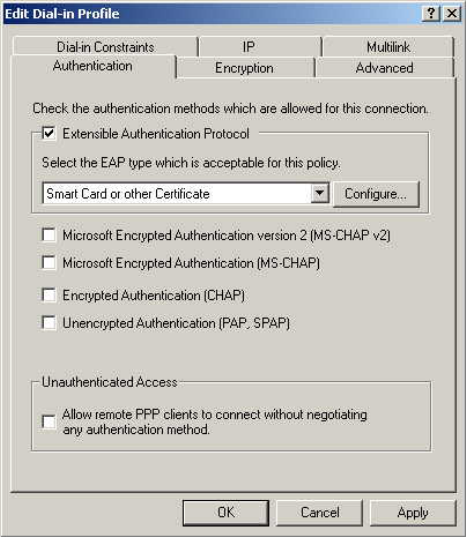
Wireless Access Point User Guide
52
11. Click Edit Profile... and select the Authentication tab. Enable Extensible Authentication
Protocol, and select Smart Card or other Certificate. Deselect other authentication meth-
ods listed. Click OK.
Figure 40: Authentication Screen
12. Select No if you don't want to view the help for EAP. Click Finish.
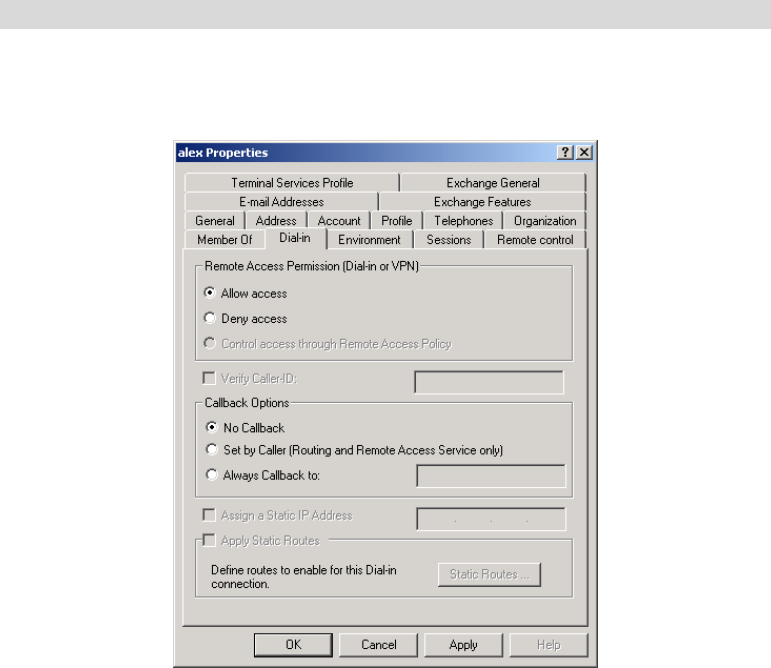
PC and Server Configuration
53
Remote Access Login for Users
1. Select Start - Programs - Administrative Tools- Active Directory Users and Computers.
2. Double click on the user who you want to enable.
3. Select the Dial-in tab, and enable Allow access. Click OK.
Figure 41: Dial-in Screen
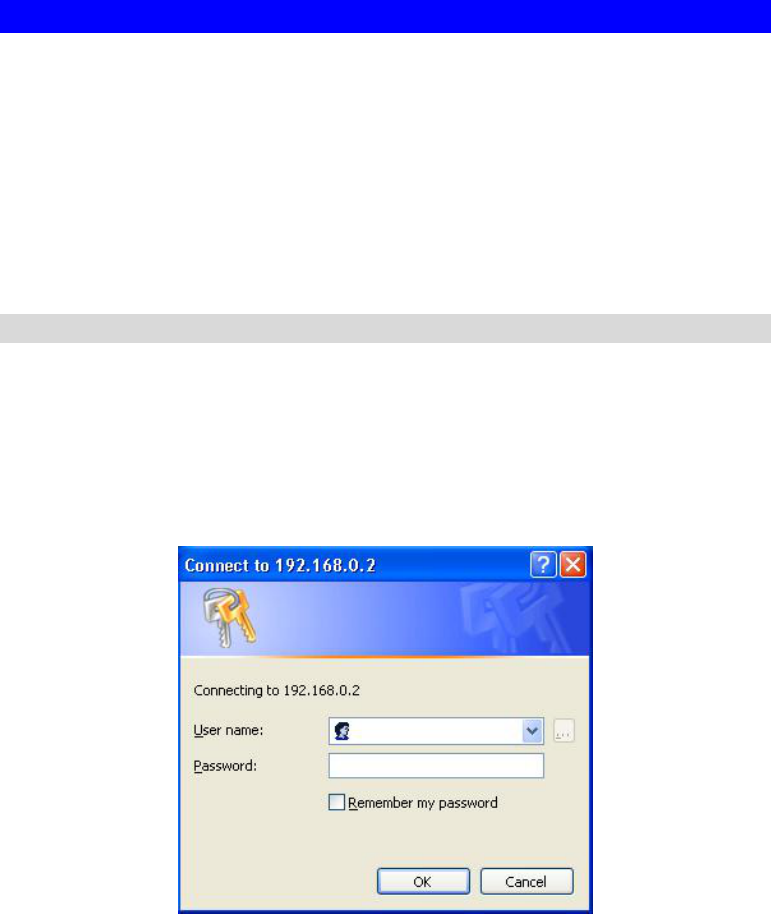
Wireless Access Point User Guide
54
802.1x Client Setup on Windows XP
Windows XP ships with a complete 802.1x client implementation. If using Windows 2000,
you can install SP3 (Service Pack 3) to gain the same functionality.
If you don't have either of these systems, you must use the 802.1x client software provided
with your wireless adapter. Refer to your vendor's documentation for setup instructions.
The following instructions assume that:
You are using Windows XP
You are connecting to a Windows 2000 server for authentication.
You already have a login (User name and password) on the Windows 2000 server.
Client Certificate Setup
1. Connect to a network which doesn't require port authentication.
2. Start your Web Browser. In the Address box, enter the IP address of the Windows 2000
Server, followed by /certsrv
e.g
http://192.168.0.2/certsrv
3. You will be prompted for a user name and password. Enter the User name and Password
assigned to you by your network administrator, and click OK.
Figure 42: Connect Screen
4. On the first screen (below), select Request a certificate, click Next.
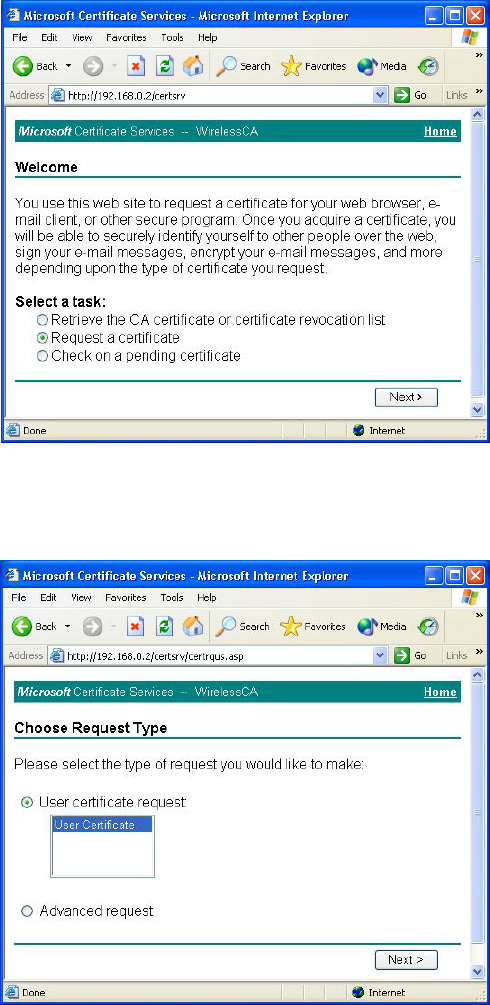
PC and Server Configuration
55
Figure 43: Wireless CA Screen
5. Select User certificate request and select User Certificate, the click Next.
Figure 44: Request Type Screen
6. Click Submit.
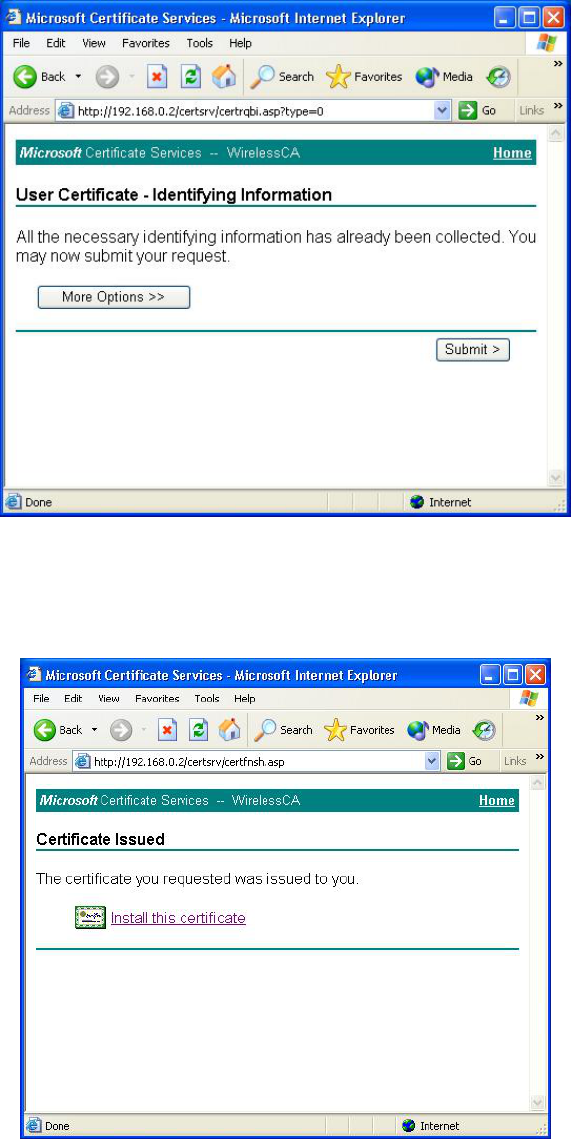
Wireless Access Point User Guide
56
Figure 45: Identifying Information Screen
7. A message will be displayed, then the certificate will be returned to you.
Click Install this certificate.
Figure 46:Certificate Issued Screen
8. . You will receive a confirmation message. Click Yes.
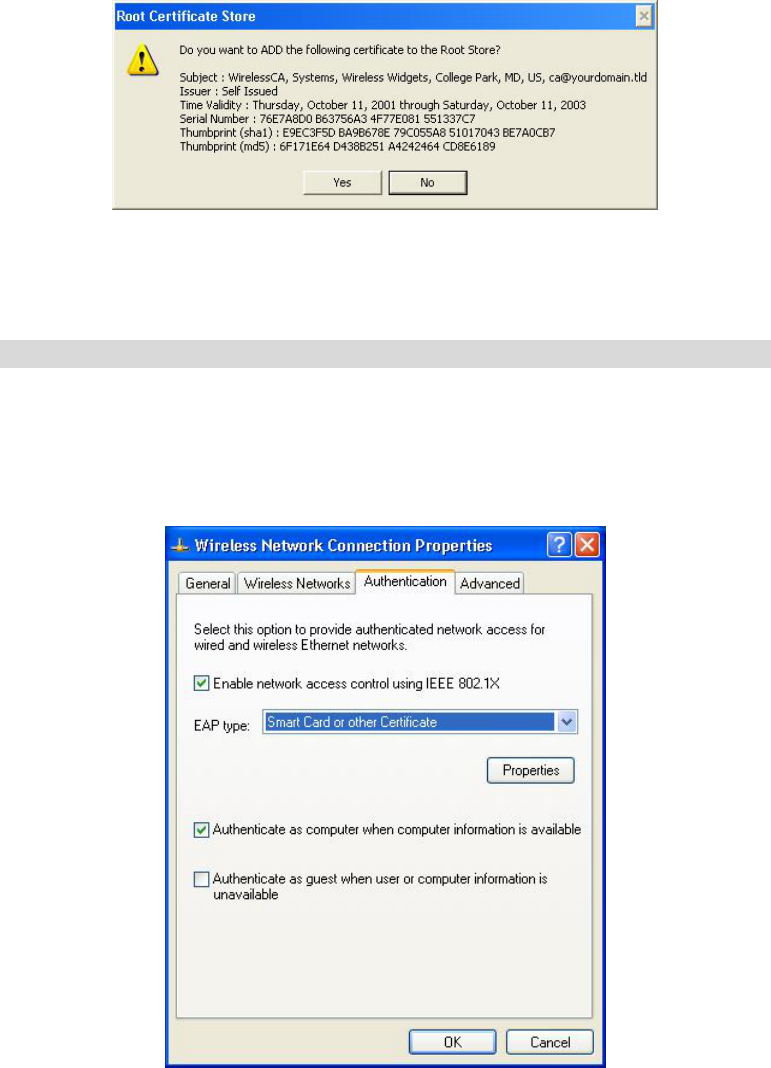
PC and Server Configuration
57
Figure 47: Root Certificate Screen
9. Certificate setup is now complete.
802.1x Authentication Setup
1. Open the properties for the wireless connection, by selecting Start - Control Panel -
Network Connections.
2. Right Click on the Wireless Network Connection, and select Properties.
3. Select the Authentication Tab, and ensure that Enable network access control using IEEE
802.1X is selected, and Smart Card or other Certificate is selected from the EAP type.
Figure 48: Authentication Tab
Encryption Settings
The Encryption settings must match the APs (Access Points) on the Wireless network you
wish to join.
Windows XP will detect any available Wireless networks, and allow you to configure
each network independently.
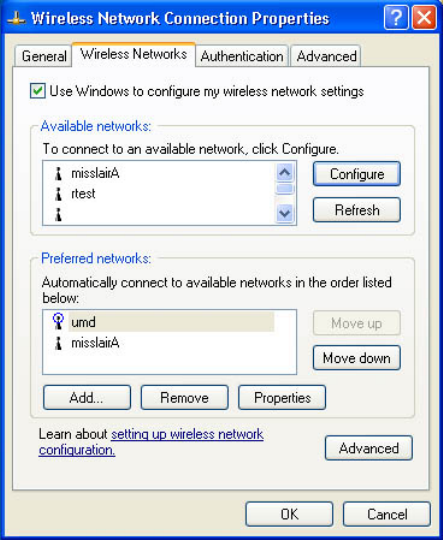
Wireless Access Point User Guide
58
Your network administrator can advise you of the correct settings for each network.
802.1x networks typically use EAP-TLS. This is a dynamic key system, so there is no
need to enter key values.
Enabling Encryption
To enable encryption for a wireless network, follow this procedure:
1. Click on the Wireless Networks tab.
Figure 49: Wireless Networks Screen
2. Select the wireless network from the Available Networks list, and click Configure.
3. Select and enter the correct values, as advised by your Network Administrator.
For example, to use EAP-TLS, you would enable Data encryption, and click the checkbox
for the setting The key is provided for me automatically, as shown below.
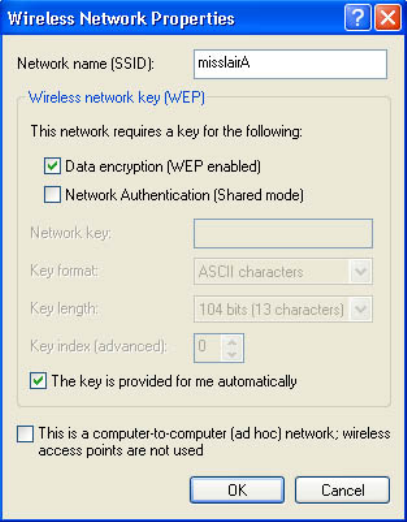
PC and Server Configuration
59
Figure 50: Properties Screen
Setup for Windows XP and 802.1x client is now complete.
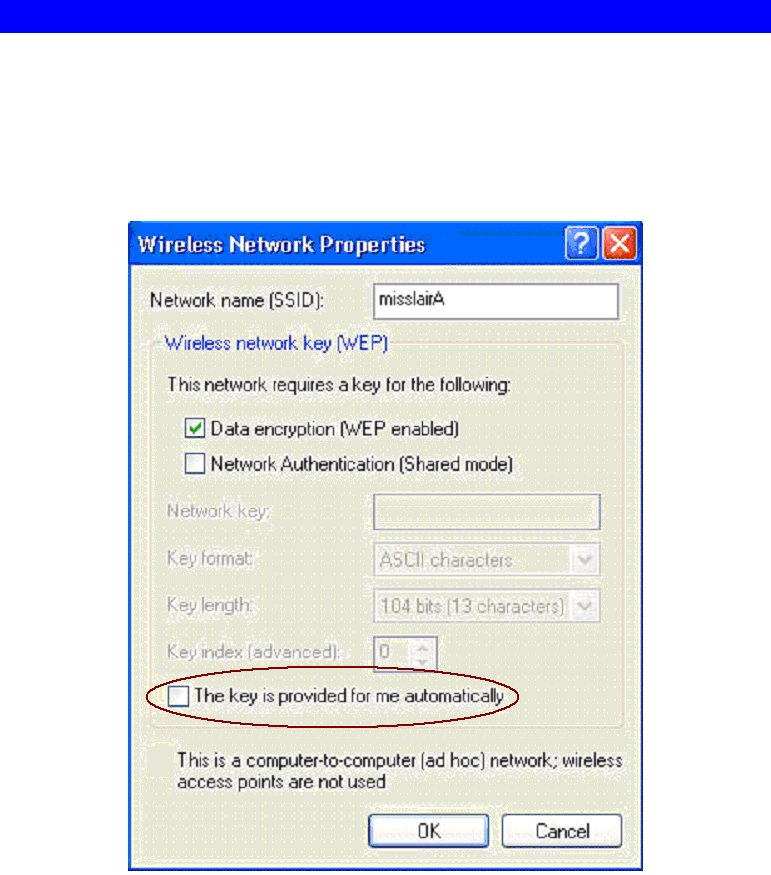
Wireless Access Point User Guide
60
Using 802.1x Mode (without WPA)
This is very similar to using WPA-Enterprise.
The only difference is that on your client, you must NOT enable the setting The key is provid-
ed for me automatically.
Instead, you must enter the WEP key manually, ensuring it matches the WEP key used on the
Access Point.
Figure 51: Properties Screen
Note:
On some systems, the "64 bit" WEP key is shown as "40 bit" and the "128 bit" WEP key is
shown as "104 bit". This difference arises because the key input by the user is 24 bits less than
the key size used for encryption.
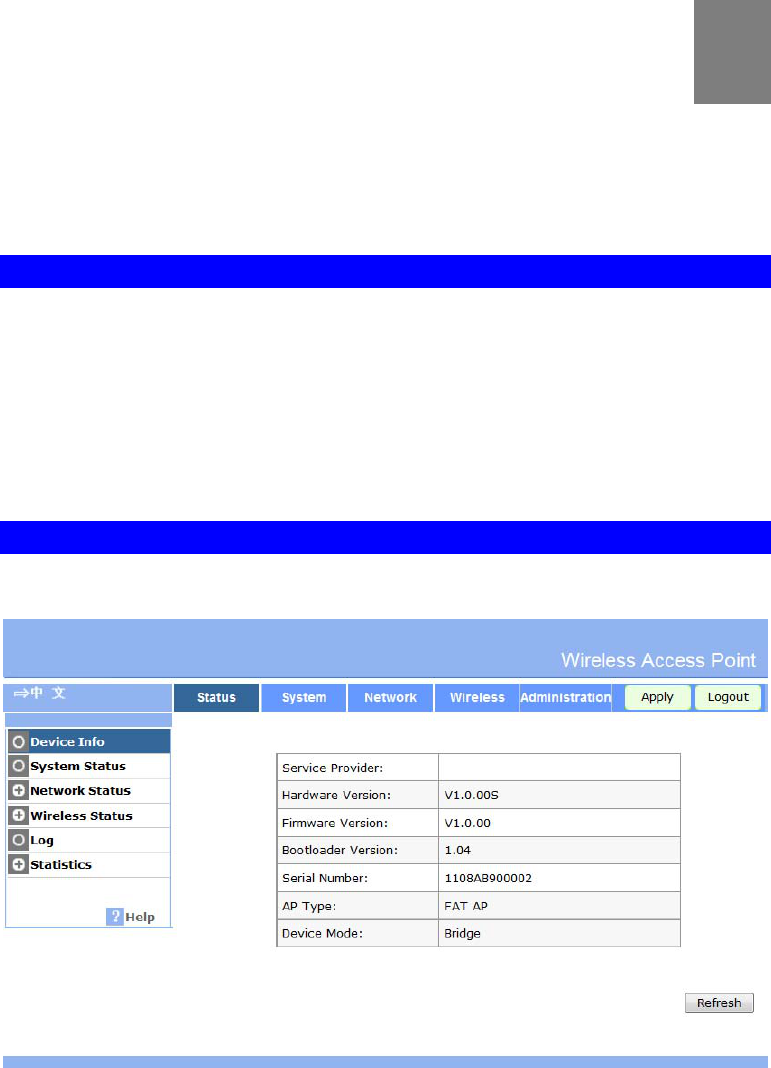
61
Chapter 5
Operation and Status
This Chapter details the operation of the Wireless Access Point and the status
screens.
Operation
Once both the Wireless Access Point and the PCs are configured, operation is automatic.
However, you may need to perform the following operations on a regular basis.
If using the Access Control feature, update the Trusted PC database as required. (See
Access Control in Chapter 3 for details.)
If using 802.1x mode, update the User Login data on the Windows 2000 Server, and
configure the client PCs, as required.
Status Screen
Use the Status link on the main menu to view this screen.
Figure 52: Status Screen
5

Wireless Access Point User Guide
62
Data - Status Screen
Access Point
Access Point Name The current name will be displayed.
MAC Address The MAC (physical) address of the Wireless Access Point.
Country/Domain The region or domain, as selected on the System screen.
Hardware Version The version of the hardware currently used.
Firmware Version The version of the firmware currently installed.
TCP/IP
IP Address The IP Address of the Wireless Access Point.
Subnet Mask The Network Mask (Subnet Mask) for the IP Address above.
Gateway Enter the Gateway for the LAN segment to which the Wireless
Access Point is attached (the same value as the PCs on that LAN
segment).
DHCP Client This indicates whether the current IP address was obtained from a
DHCP Server on your network.
It will display "Enabled" or "Disabled".
DHCP Server "Enabled" or "Disabled" is displayed for the DHCP server status.
Ethernet Status The current Ethernet status is displayed.
Wireless
Channel/Frequency The Channel currently in use is displayed.
Wireless Mode The current mode (e.g. 802.11g) is displayed.
AP Mode The current Access Point mode is displayed.
Buttons
Virtual AP Status Click this to open a sub-window displaying Virtual AP Status
about the information of Name, SSID, Broadcast SSID, Security,
Status and Clients.
Statistics Click this to open a sub-window where you can view Statistics on
data transmitted or received by the Access Point.
Log Click this to open a sub-window where you can view the activity
log.
Stations Click this to open a sub-window where you can view the list of
all current Wireless Stations using the Access Point.
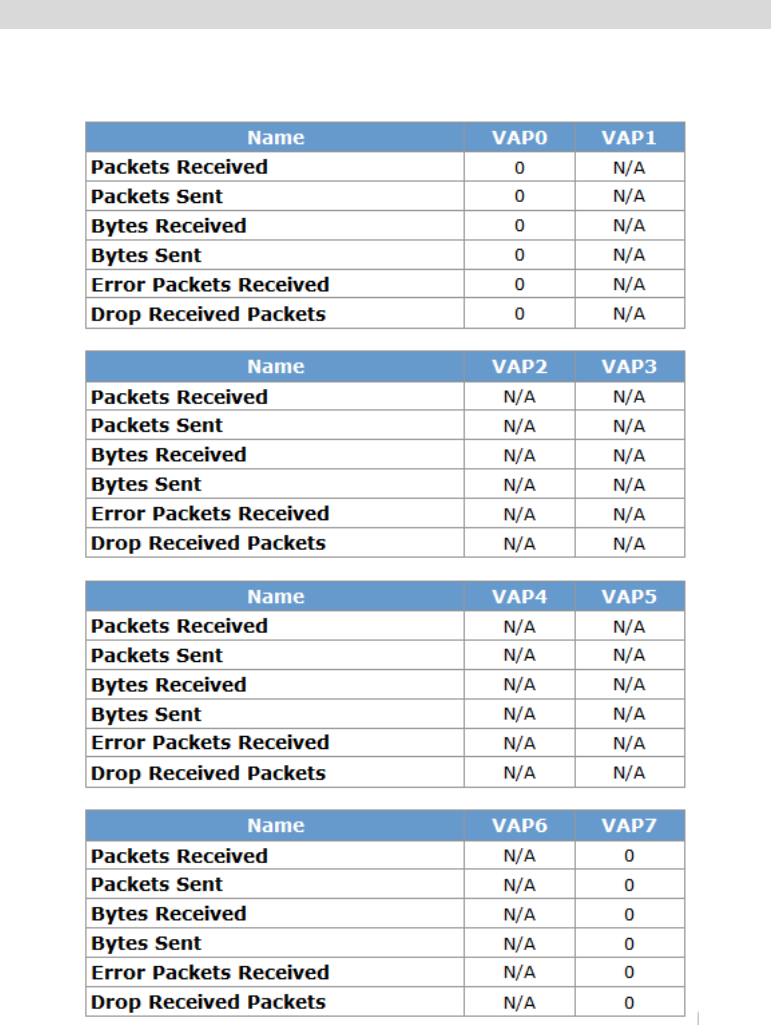
Operation and Status
63
Statistics Screen
This screen is displayed when the Statistics button on the Status screen is clicked. It shows
details of the traffic flowing through the Wireless Access Point.
Figure 53: Statistics Screen

Wireless Access Point User Guide
64
Data - Statistics Screen
System Up Time
Up Time This indicates how long the system has been running since the last
restart or reboot.
VAP
Authentication The number of "Authentication" packets received. Authentication
is the process of identification between the AP and the client.
Deauthentication The number of "Deauthentication" packets received. Deauthentica-
tion is the process of ending an existing authentication relationship.
Association The number of "Association" packets received. Association creates
a connection between the AP and the client. Usually, clients associ-
ate with only one (1) AP at any time.
Disassociation The number of "Disassociation" packets received. Disassociation
breaks the existing connection between the AP and the client.
Reassociation The number of "Reassociation" packets received. Reassociation is
the service that enables an established association (between AP and
client) to be transferred from one AP to another (or the same) AP.
Wireless
Data Number of valid Data packets transmitted to or received from
Wireless Stations, at driver level.
Management Number of Management packets transmitted to or received from
Wireless Stations.
Control Number of Control packets transmitted to or received from Wire-
less Stations.
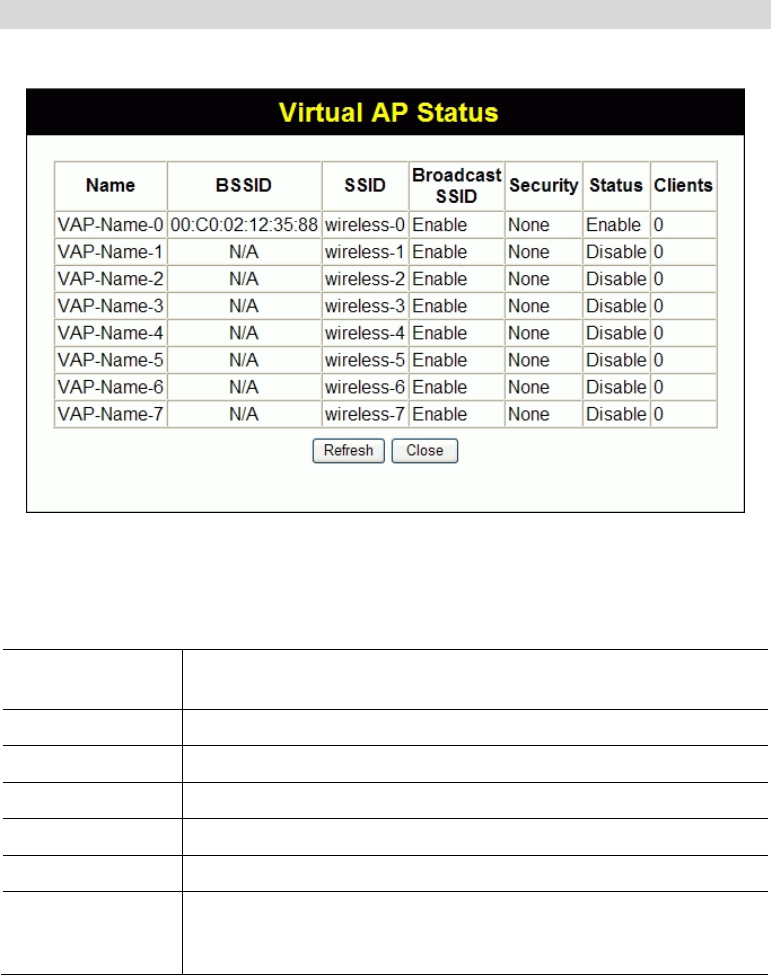
Operation and Status
65
Virtual AP Status
This screen is displayed when the Virtual AP Status button on the Status screen is clicked.
Figure 54: Virtual AP Status Screen
For each VAP, the following data is displayed:
Name The name you gave to this VAP; if you didn't change the name, the
default name is used.
BSSIS The MAC address of the VAP.
SSID The SSID assigned to this VAP.
Broadcast SSID Indicates whether or not the SSID is broadcast.
Security The security method used by this VAP.
Status Indicates whether or not this VAP is enabled or currently used.
Clients The number of wireless stations currently using accessing this Access
Point using this VAP.
If the VAP is disabled, this will always be zero.
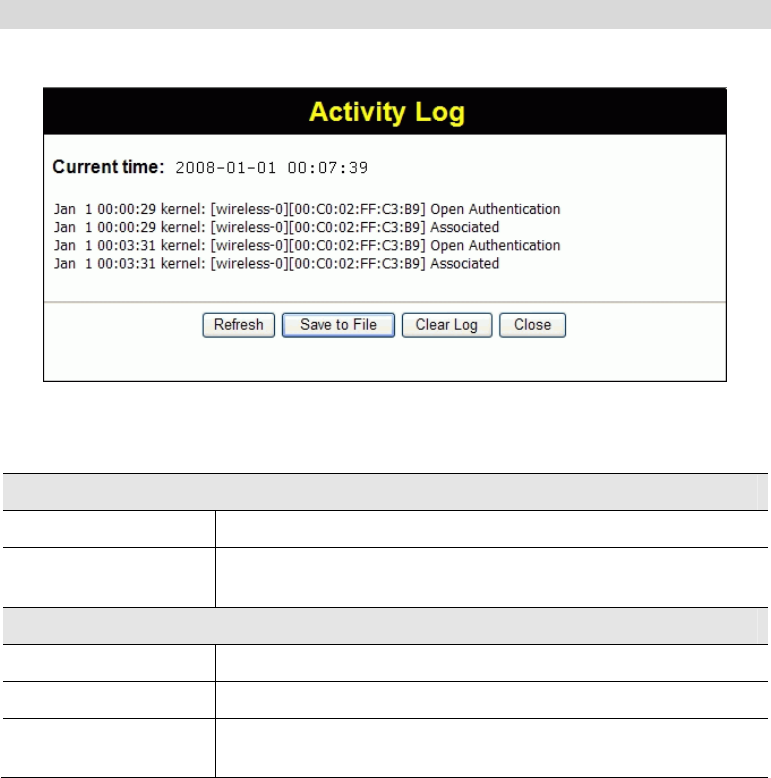
Wireless Access Point User Guide
66
Activity Log
This screen is displayed when the Log button on the Status screen is clicked.
Figure 55: Activity Log Screen
Data - Activity Log
Data
Current Time The system date and time is displayed.
Log The Log shows details of the connections to the Wireless Access
Point.
Buttons
Refresh Update the data on screen.
Save to File Save the log to a file on your pc.
Clear Log This will delete all data currently in the Log. This will make it
easier to read new messages.
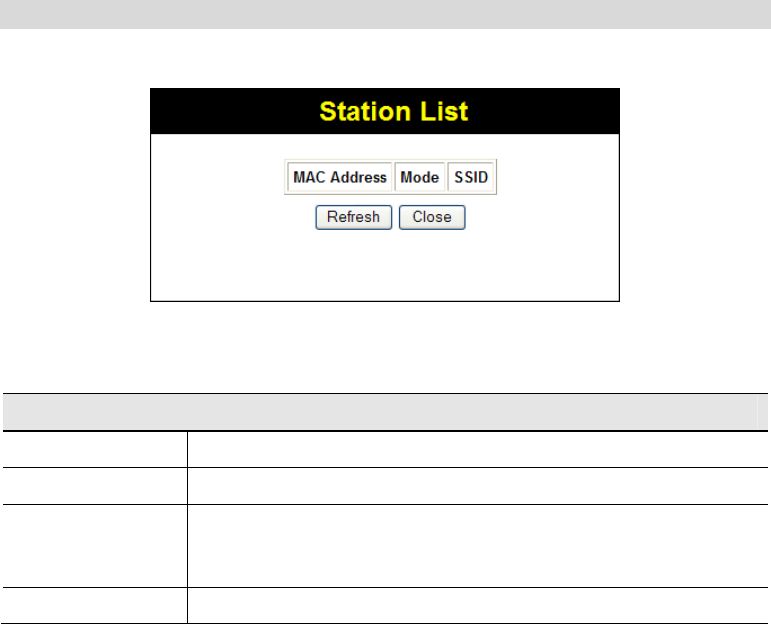
Operation and Status
67
Station List
This screen is displayed when the Stations button on the Status screen is clicked.
Figure 56 Station List Screen
Data - Station List Screen
Station List
MAC Address The MAC (physical) address of each Wireless Station is displayed.
Mode The mode of each Wireless Station.
SSID This displays the SSID used the Wireless station. Because the Wire-
less Access Point supports multiple SSIDs, different PCs could
connect using different SSIDs.
Refresh Button Update the data on screen.
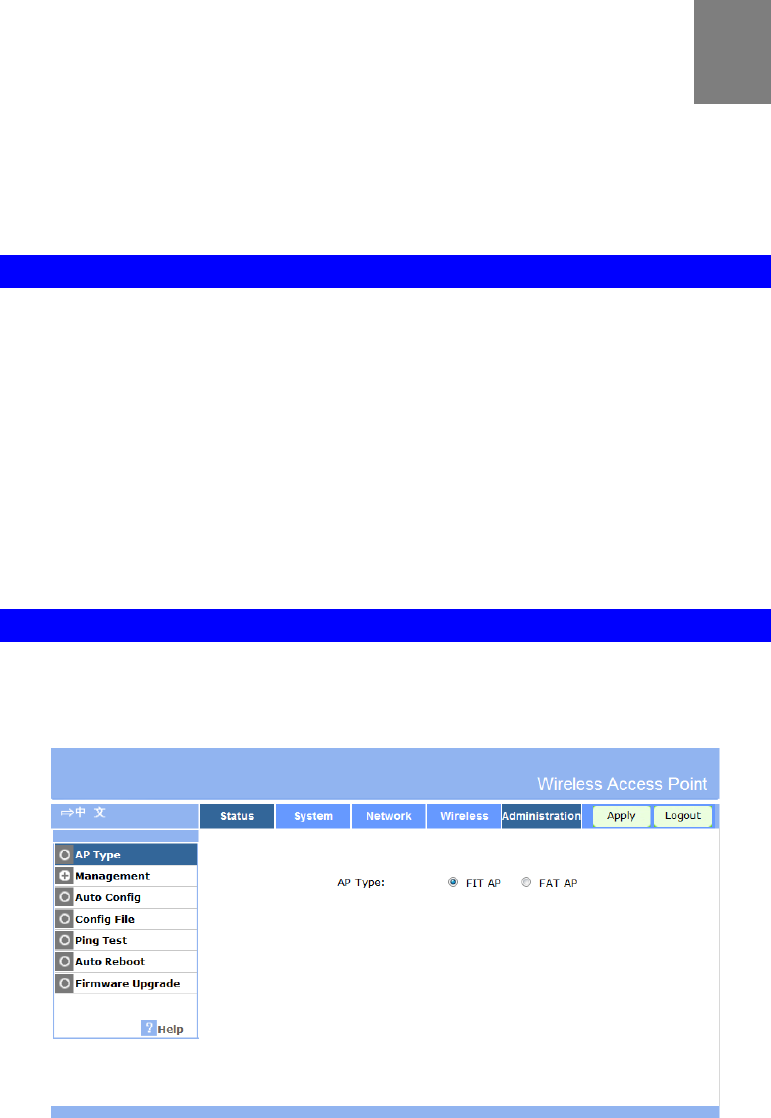
68
Chapter 6
Access Point Management
This Chapter explains when and how to use the Wireless Access Point's "Ad-
ministration" Features.
Overview
This Chapter covers the following features, available on the Wireless Access Point’s Man-
agement menu.
AP Type
Management
Auto Config
Config File
Ping Test
Auto Reboot
Firmware Upgrade
AP Type Screen
The AP Type screen allows you to assign Fat AP mode or Fit AP mode. The Wireless Access
Point will work as general AP in Fat AP mode. The Wireless Access Point must work with AC
in Fit AP mode.
Figure 57: AP Type Screen
6

Access Point Management
69
Data – AP Type Screen
FAT AP
FAT AP Select the mode. The AP will work as general AP. All of
function on the AP need User to configure it everyone.
FIT AP
FIT AP Select the mode. The AP will work as thin AP mode. The IP
Address will change to DHCP Client. It will ask one IP
Address from DHCP Server on the LAN. So User can config-
ure it by Web or AC.
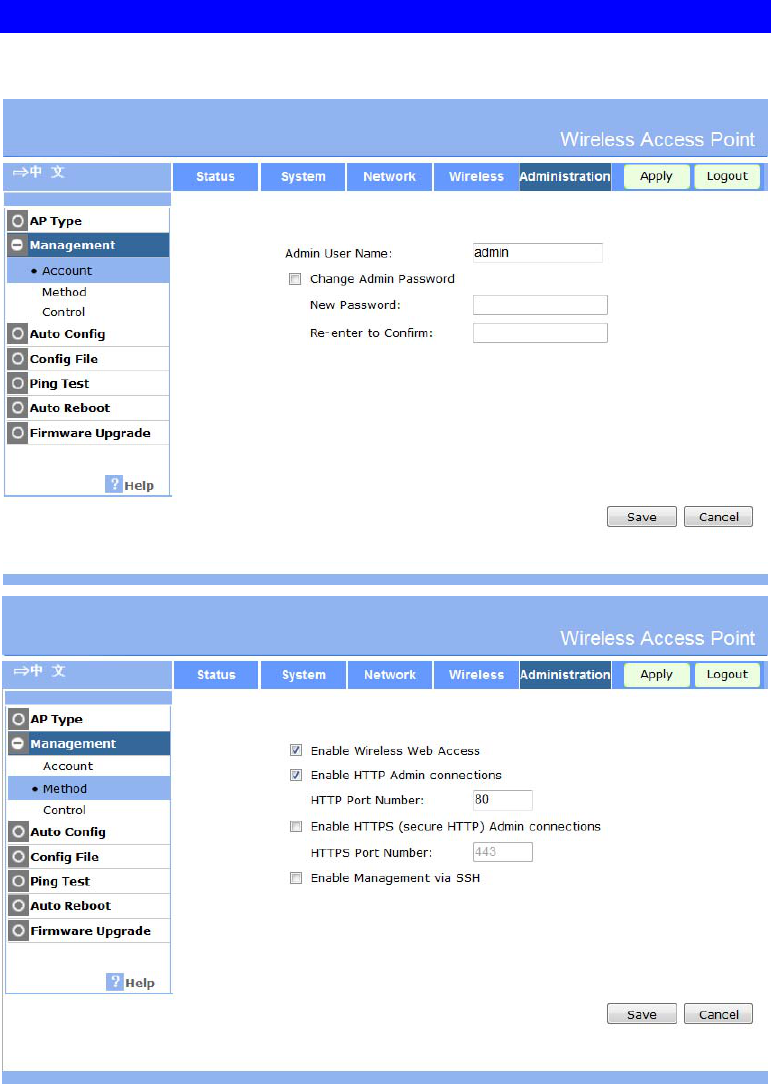
Wireless Access Point User Guide
70
Management
To reach this screen, select Management in the Administrtion section of the menu.
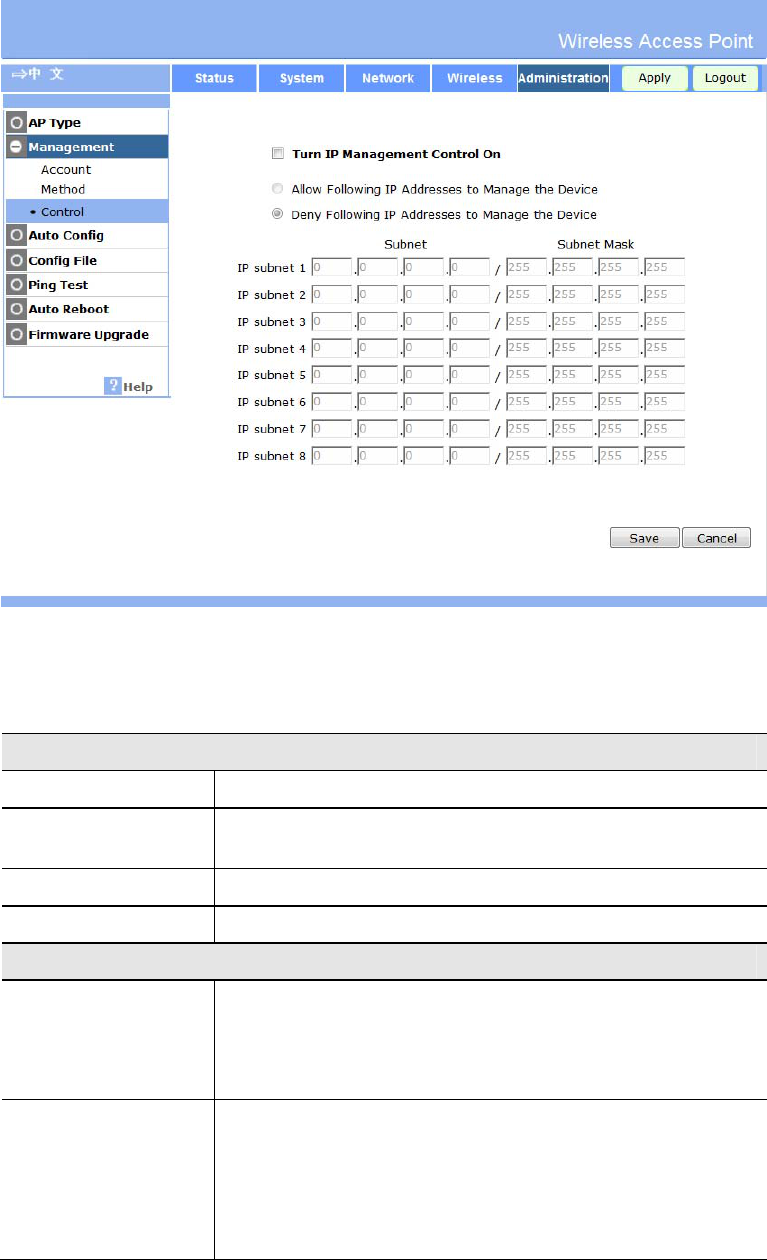
Access Point Management
71
Figure 58: Management Screen
Data - Management Screen
Account
Admin User Name The name for login the Device Web.
Change Admin
Password If checked, You can change the login password. The default
password is “password”.
New Password Input the new password.
Re-enter to Confirm Avoid the error. Re-enter the new password.
Method
Enable Wireless Web
Access If enabled, the device will allow wireless client access the Device
Web by wireless.
If disabled, the device will only allow Ethernet client access the
Device Web.
Enable HTTP Admin
Connections.
HTTP Port Number
If enabled. The device will allow user via it by HTTP method.
If disabled. The device will refuse user via it by HTTP method.
Input the desired HTTP port. The default port is 80.

Wireless Access Point User Guide
72
Enable HTTPS
(secure HTTP) Ad-
min connections
HTTPS Port Number
If enabled. The device will allow user via it by HTTPS method.
If disabled. The device will refuse user via it by HTTPS method.
Input the desired HTTPS port. The default port is 443.
Enable Management
via SSH If enabled. The device will allow via it by SSH method.
Control
Turn IP Management
Control On If enabled, the device will limit user access it. Not all of user can
manger it so improve safety.
Allow Following IP
Addresses to Manage
the Device
If enabled. The device only allow the follows PCs access it. The
PC not in the list will not access it.
Deny Following IP
Addresses to Manage
the Device
If enabled. The device will refuse the follows PCs access it. The
PC not in the list will allow access it.
PCs List You can define the desired network subnet. You need input the
subnet and subnet mask.
For example. 192.168.0.0/255.255.255.0.
It include 8 group subnet.
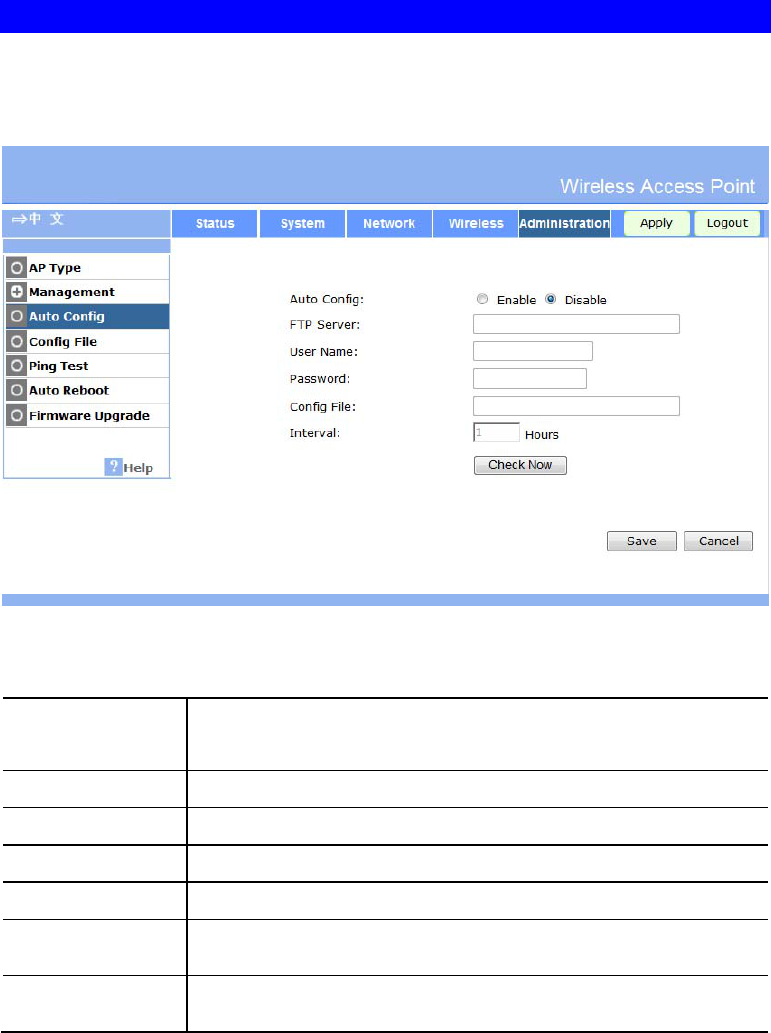
Access Point Management
73
Auto Config
Auto Config is only useful if you have a FTP Server on your LAN. So the device will auto
load the config file from the FTP Server. To reach this screen, select Auto Config in the Ad-
ministration section of the menu.
Figure 59: SNMP Screen
Data – Auto Config Screen
Auto Config If enable. The device will auto load config file from server.
If disable. The function is invalid.
FTP Server Input the FTP Server IP address.
User Name Input the user names for login FTP Server.
Password Input the password for login FTP Server.
Config file Input the config file path on the FTP Server.
Interval The device will as the interval time to check new config file on FTP
Server. If find new config file will auto load it. The unit is hours.
Check now Press the button. The device will check new config file on FTP
Server immediately.
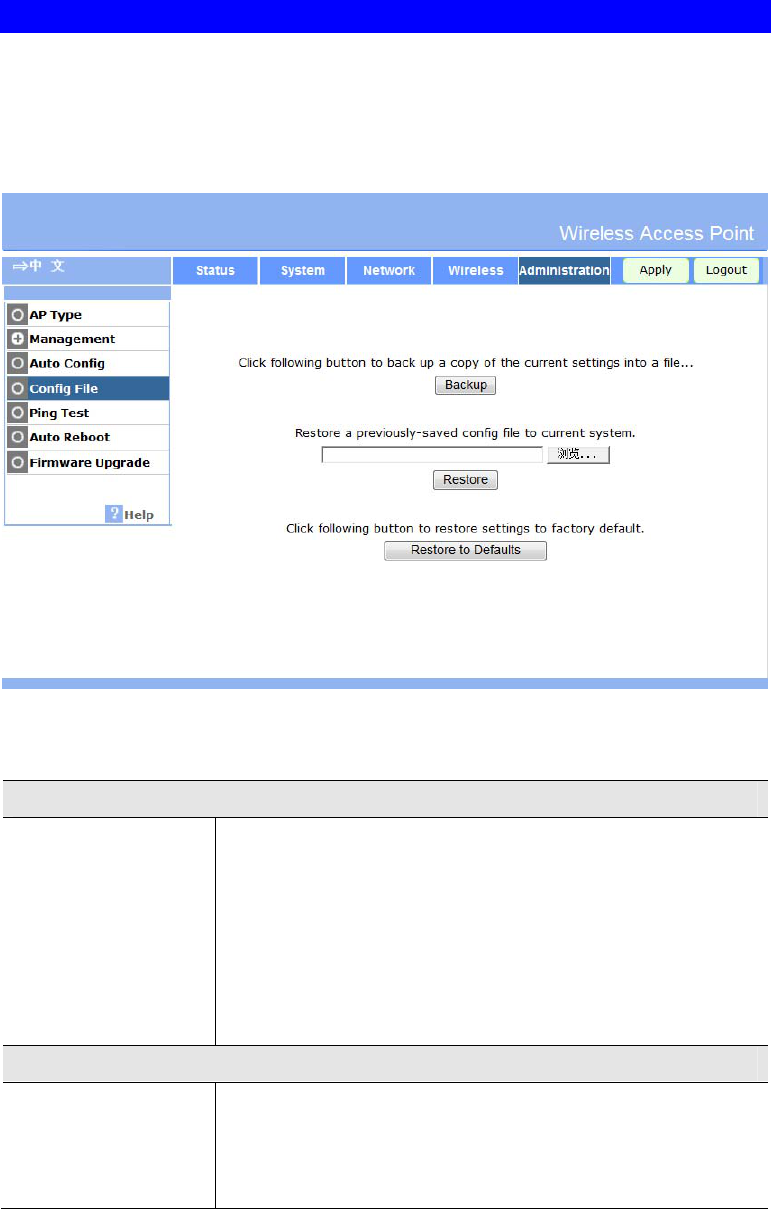
Wireless Access Point User Guide
74
Config File
This screen allows you to Backup (download) the configuration file, and to restore (upload) a
previously-saved configuration file.
You can also set the Wireless Access Point back to its factory default settings.
To reach this screen, select Config File in the Administration section of the menu.
Figure 60: Config File Screen
Data - Config File Screen
Backup
Save a copy of cur-
rent settings to a file Once you have the Access Point working properly, you should
back up the settings to a file on your computer. You can later
restore the Access Point's settings from this file, if necessary.
To create a backup file of the current settings:
Click Backup.
If you don't have your browser set up to save downloaded
files automatically, locate where you want to save the file,
rename it if you like, and click Save.
Restore
Restore saved settings
from a file To restore settings from a backup file:
1. Click Browse.
2. Locate and select the previously saved backup file.
3. Click Restore

Access Point Management
75
Defaults
Revert to factory
default settings To erase the current settings and restore the original factory
default settings, click Set to Defaults button.
Note!
This will terminate the current connection. The Access Point
will be unavailable until it has restarted.
By default, the Access Point will act as a DHCP client, and
automatically obtain an IP address. You will need to deter-
mine its new IP address in order to re-connect.
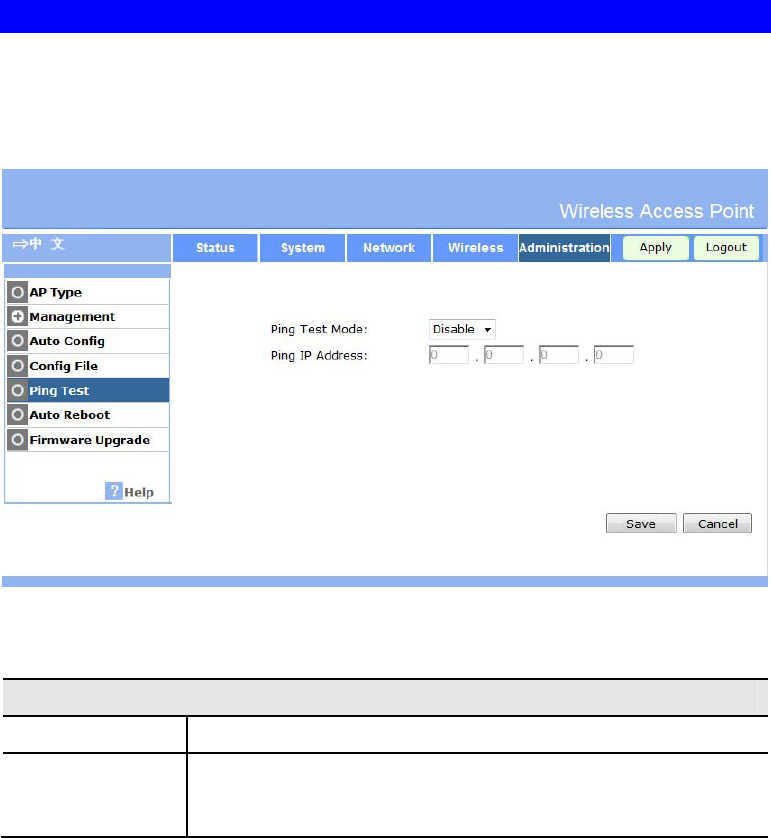
Wireless Access Point User Guide
76
Ping Test
Ping Test is one useful function for test the Ethernet integrality. If the device can PING the IP
address so the device will work normal. If the device can’t PING the IP address so the device
will disable the wireless function. To reach this screen, select Ping Test in the Administration
section of the menu.
Figure 61: SNMP Screen
Data – Ping Test Screen
Ping Test
Ping Test Mode Select enable or disable.
Ping IP Address If enable the function. You must input one IP address and it is valid.
If the IP address is invalid that the device will disable wireless
function.
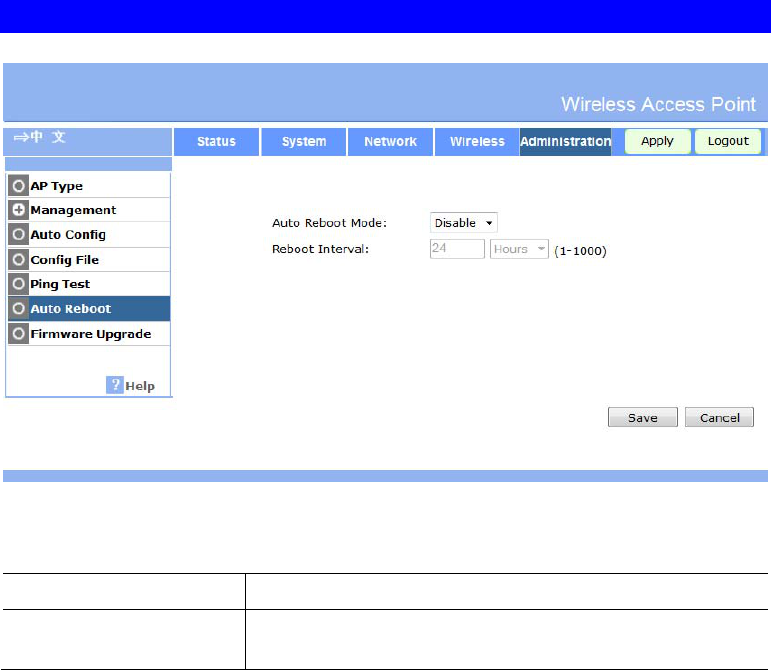
Access Point Management
77
Auto Reboot
Figure 62: Auto Reboot Screen
Data – Auto Reboot Screen
Auto Reboot Mode Select enable or disable.
Reboot Interval If enable the function. Please input the desired time. The unit
is hours. The device will auto reboot as the time interval.
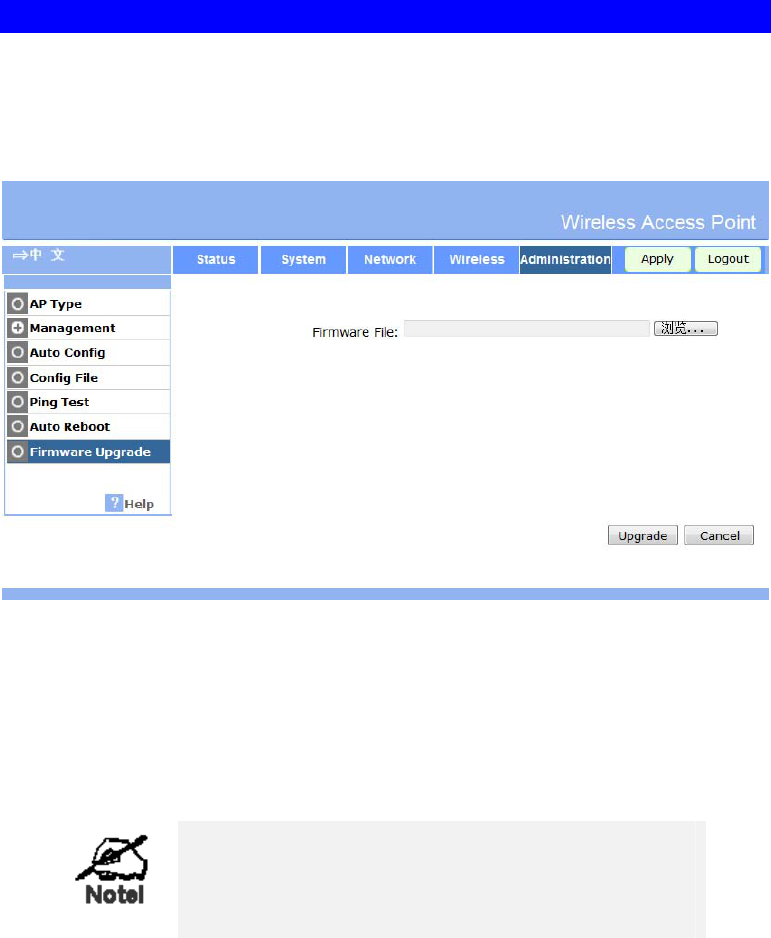
Wireless Access Point User Guide
78
Firmware Upgrade
The firmware (software) in the Wireless Access Point can be upgraded using your Web
Browser.
You must first download the upgrade file, and then select Upgrade Firmware in the Admin-
istration section of the menu. You will see a screen like the following.
Figure 63: Firmware Upgrade Screen
To perform the Firmware Upgrade:
1. Click the Browse button and navigate to the location of the upgrade file.
2. Select the upgrade file. Its name will appear in the Upgrade File field.
3. Click the Upgrade button to commence the firmware upgrade.
The Wireless Access Point is unavailable during the
upgrade process, and must restart when the up-
grade is completed. Any connections to or through
the Wireless Access Point will be lost.

79
Appendix A
Specifications
Wireless Access Point
Hardware Specifications
LAN port 1 x Auto-MDIX RJ 45 for 10/100/1000Mbps PoE port
IEEE 802.3af compliance
11b Embedded Atheros solution
Network Standard IEEE 802.11b (Wi-Fi™) and IEEE
802.11g compliance
OFDM; 802.11b: CCK (11 Mbps, 5.5 Mbps), DQPSK (2
Mbps), DBPSK (1 Mbps)
Operating Frequencies 2.412.2.497 GHz
Operating Channels 802.11g: 11 for North America, 13
for Europe (ETSI), 14 for Japan
802.11b: 11 for North America, 14 for Japan, 13 for
Europe (ETSI)
11n
IEEE802.11n draft 2.0 compliant
Rx Sensitivity: 11.n: 300Mbps@ -69dBm, 11.g:
54Mbps@ -73dBm, 11.b: 11Mbps@ -88dBm
Antennae 2 x 2dbi detachable antenna
Operating temperature 0 C to 40 C
Storage temperature -20 C to 70 C
Power Adapter 12VDC 1A External
Dimensions 235mm(W) * 145mm(D) * 40mm(H)
A

Wireless Access Point User Guide
80
Software Specifications
Feature Details
Wireless Access point support
Roaming supported
IEEE 802.11n/11g/11b compliance
Auto Sensing Open System / Share Key authentication
Wireless Channels Support
Automatic Wireless Channel Selection
Country Selection
Preamble Type: long or short support
RTS Threshold Adjustment
Fragmentation Threshold Adjustment
Beacon Interval Adjustment
8x Multi-BSSID assignment
802.11i pre-authentication
Short Slot time support
IEEE 802.11d
CTS-only & CTS/RTS protect mechanism support
WMM support
WPS support
Wireless isolations
Operation Mode Common AP+PTMP/PTP
Thin AP mode
Wireless Router mode
Rogue AP Detection
Security Open, shared, WPA, WPA-PSK, and WPA2-PSK authentication
64bit/128bit WEP, TKIP, AES-CCMP support
802.1x support
EAP-MD5, EAP-TLS, EAP-TTLS, PEAP
RADIUS based MAC authentication
Block inter-wireless station communication (wireless separation)
Block SSID broadcast
Management Web based configuration
Configurable Web port
RADIUS Accounting
RADIUS-On feature
RADIUS Accounting update
Telnet/CLI
Syslog/internal Log
Access Control list
Editable Configuration file backup/Restore

Appendix A - Specifications
81
Statistics support
SNMP v1 & v2c & v3
LLTD
Only wired users to be able to control
Auto configuration
Other Features DHCP client
WINS client
Radius client
Enable/Disable wireless
Network Integrality Check
FTP client
Firmware Upgrade HTTP/FTP network protocol download

82
Appendix B
Troubleshooting
Overview
This chapter covers some common problems that may be encountered while using the Wireless
Access Point and some possible solutions to them. If you follow the suggested steps and the
Wireless Access Point still does not function properly, contact your dealer for further advice.
General Problems
Problem 1: Can't connect to the Wireless Access Point to configure it.
Solution 1: Check the following:
The Wireless Access Point is properly installed, LAN connections are
OK, and it is powered ON. Check the LEDs for port status.
Ensure that your PC and the Wireless Access Point are on the same
network segment. (If you don't have a router, this must be the case.)
If your PC is set to "Obtain an IP Address automatically" (DHCP
client), restart it.
You can use the following method to determine the IP address of the
Wireless Access Point, and then try to connect using the IP address, in-
stead of the name.
To Find the Access Point's IP Address
1. Open a MS-DOS Prompt or Command Prompt Window.
2. Use the Ping command to “ping” the Wireless Access Point. Enter
ping followed by the Default Name of the Wireless Access Point.
e.g. ping SC003318
3. Check the output of the ping command to determine the IP address of
the Wireless Access Point, as shown below.
Figure 64: Ping
If your PC uses a Fixed (Static) IP address, ensure that it is using an IP
Address which is compatible with the Wireless Access Point. (If no DHCP
Server is found, the Wireless Access Point will default to an IP Address and
Mask of 192.168.0.228 and 255.255.255.0.) On Windows PCs, you can use
Control Panel-Network to check the Properties for the TCP/IP protocol.
B
Appendix B - Troubleshooting
83
Problem 2: My PC can't connect to the LAN via the Wireless Access Point.
Solution 2 Check the following:
The SSID and WEP settings on the PC match the settings on the Wire-
less Access Point.
On the PC, the wireless mode is set to "Infrastructure"
If using the Access Control feature, the PC's name and address is in the
Trusted Stations list.
If using 802.1x mode, ensure the PC's 802.1x software is configured
correctly. See Chapter 4 for details of setup for the Windows XP 802.1x
client. If using a different client, refer to the vendor's documentation.
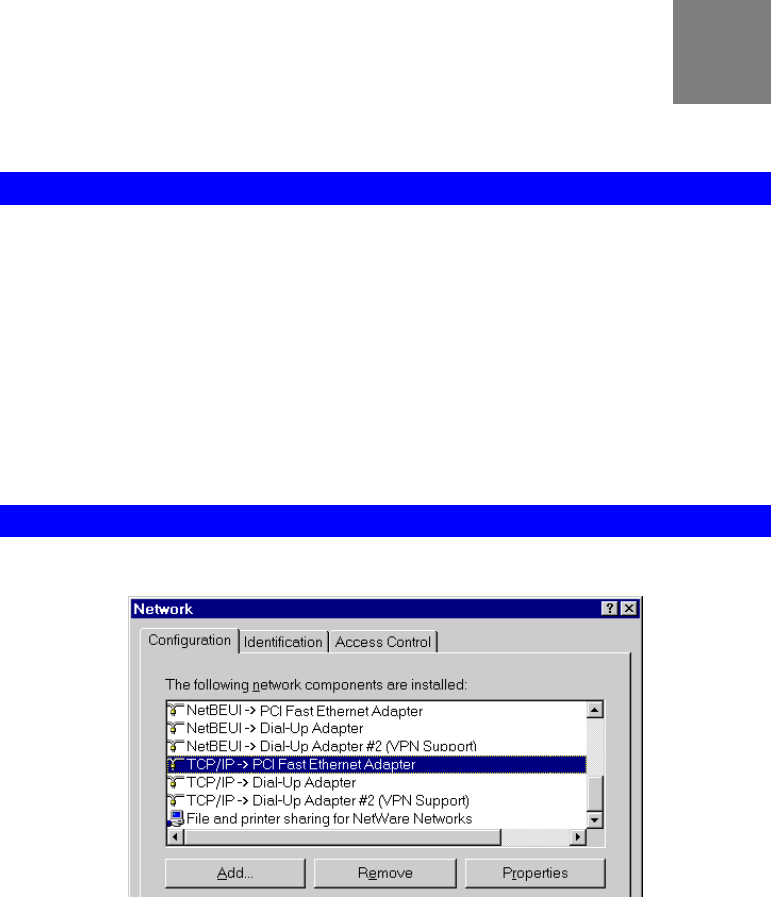
84
Appendix C
Windows TCP/IP
Overview
Normally, no changes need to be made.
By default, the Wireless Access Point will act as a DHCP client, automatically obtaining a
suitable IP Address (and related information) from your DHCP Server.
If using Fixed (specified) IP addresses on your LAN (instead of a DHCP Server), there is
no need to change the TCP/IP of each PC. Just configure the Wireless Access Point to
match your existing LAN.
The following sections provide details about checking the TCP/IP settings for various types of
Windows, should that be necessary.
Checking TCP/IP Settings - Windows 9x/ME:
1. Select Control Panel - Network. You should see a screen like the following:
Figure 65: Network Configuration
2. Select the TCP/IP protocol for your network card.
3. Click on the Properties button. You should then see a screen like the following.
C
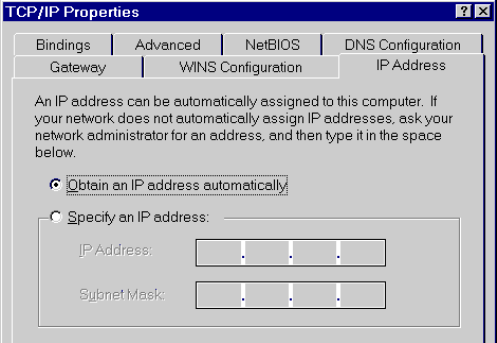
Appendix C - Windows TCP/IP
85
Figure 66: IP Address (Win 95)
Ensure your TCP/IP settings are correct, as follows:
Using DHCP
To use DHCP, select the radio button Obtain an IP Address automatically. This is the default
Windows settings. To work correctly, you need a DHCP server on your LAN.
Using "Specify an IP Address"
If your PC is already configured for a fixed (specified) IP address, no changes are required.
(The Administrator should configure the Wireless Access Point with a fixed IP address from
the same address range used on the PCs.)
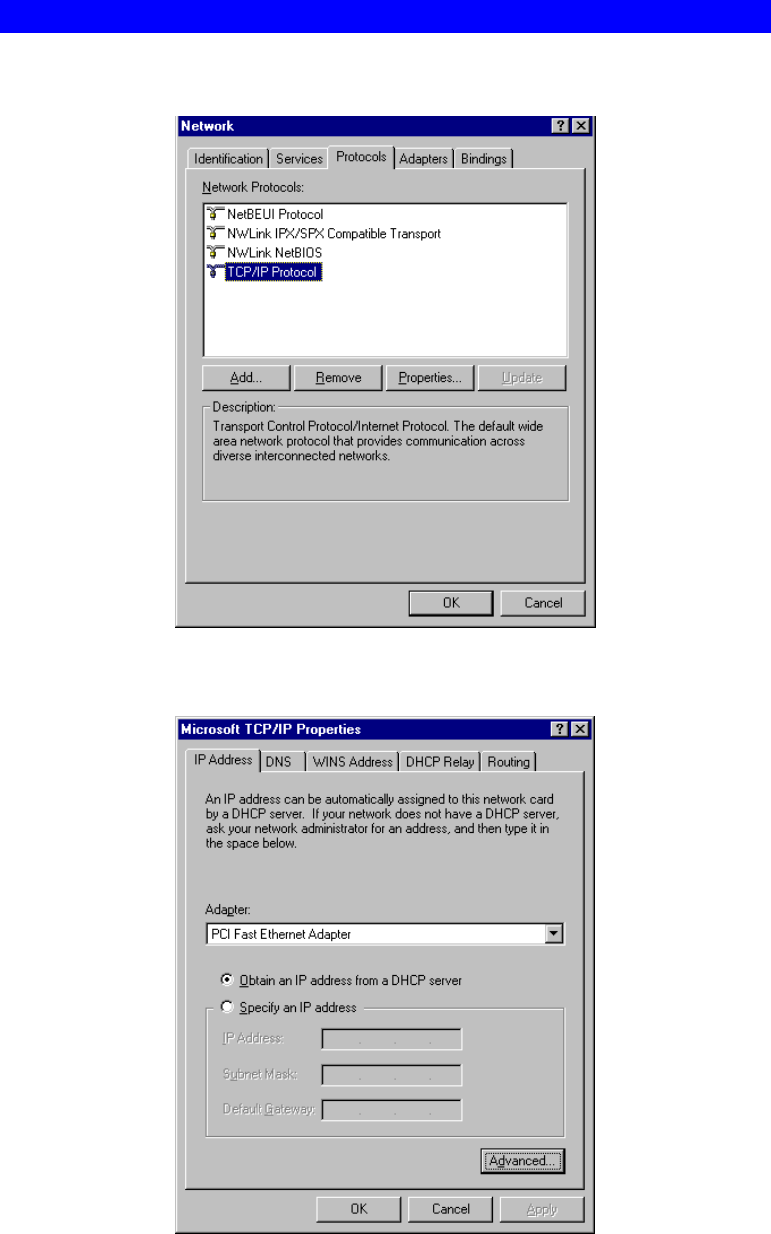
Wireless Access Point User Guide
86
Checking TCP/IP Settings - Windows NT4.0
1. Select Control Panel - Network, and, on the Protocols tab, select the TCP/IP protocol, as
shown below.
Figure 67: Windows NT4.0 - TCP/IP
2. Click the Properties button to see a screen like the one below.
Figure 68: Windows NT4.0 - IP Address
Appendix C - Windows TCP/IP
87
3. Select the network card for your LAN.
4. Select the appropriate radio button - Obtain an IP address from a DHCP Server or Specify
an IP Address, as explained below.
Obtain an IP address from a DHCP Server
This is the default Windows setting. This is the default Windows settings. To work correctly,
you need a DHCP server on your LAN.
Using "Specify an IP Address"
If your PC is already configured for a fixed (specified) IP address, no changes are required.
(The Administrator should configure the Wireless Access Point with a fixed IP address from
the same address range used on the PCs.)
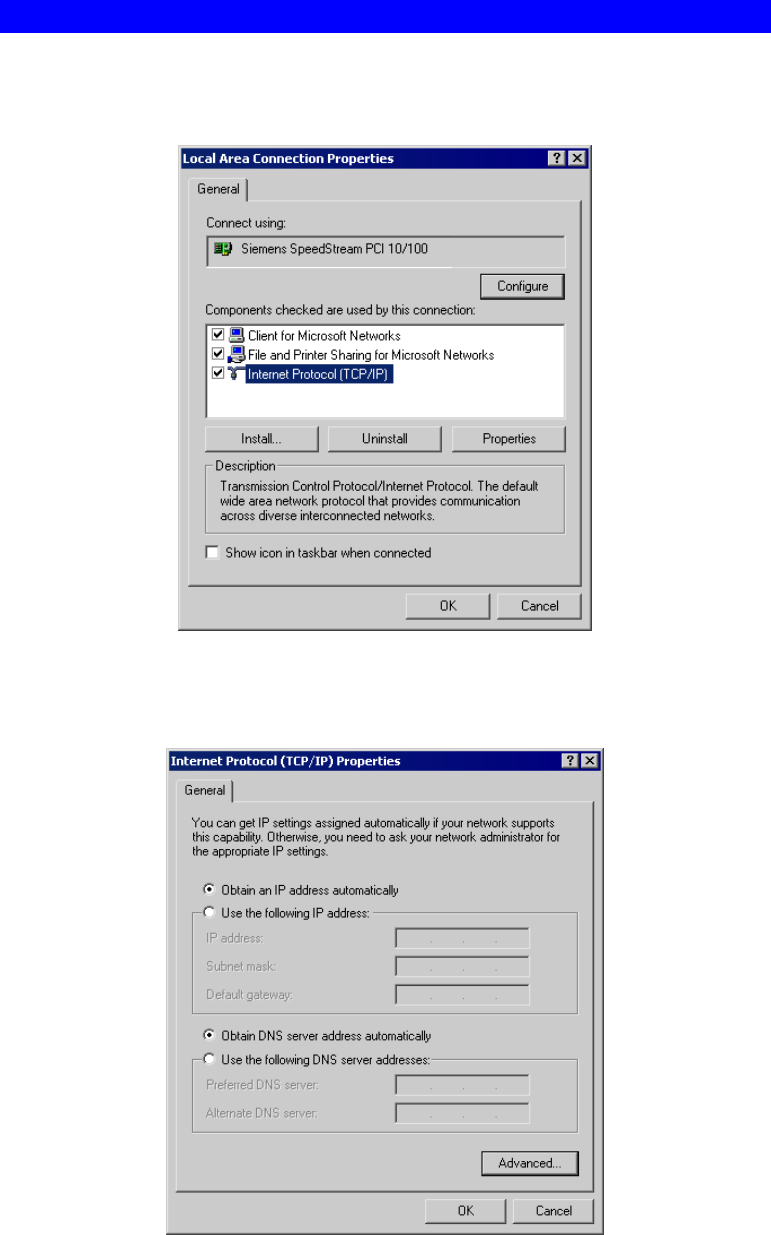
Wireless Access Point User Guide
88
Checking TCP/IP Settings - Windows 2000
1. Select Control Panel - Network and Dial-up Connection.
2. Right click the Local Area Connection icon and select Properties. You should see a screen
like the following:
Figure 69: Network Configuration (Win 2000)
3. Select the TCP/IP protocol for your network card.
4. Click on the Properties button. You should then see a screen like the following.
Figure 70: TCP/IP Properties (Win 2000)
Appendix C - Windows TCP/IP
89
5. Ensure your TCP/IP settings are correct:
Using DHCP
To use DHCP, select the radio button Obtain an IP Address automatically. This is the default
Windows setting. This is the default Windows settings. To work correctly, you need a DHCP
server on your LAN.
Using a fixed IP Address ("Use the following IP Address")
If your PC is already configured for a fixed (specified) IP address, no changes are required.
(The Administrator should configure the Wireless Access Point with a fixed IP address from
the same address range used on the PCs.)
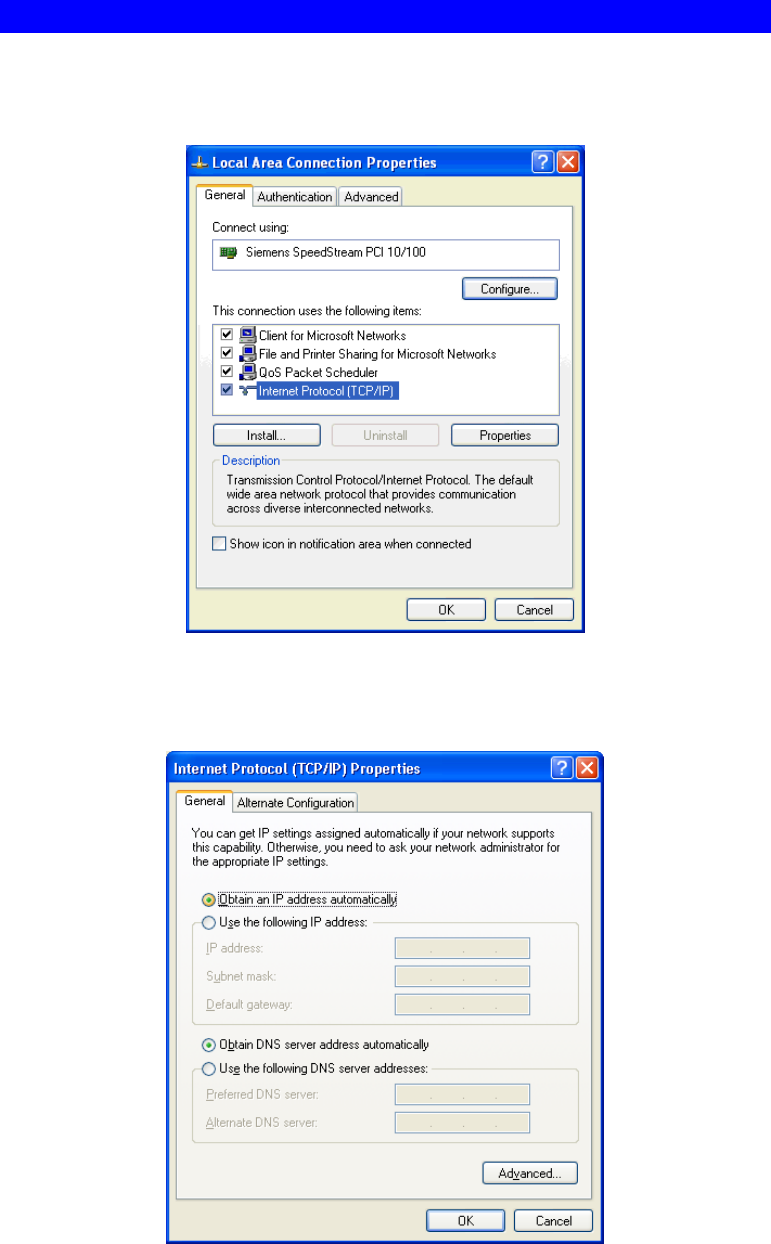
Wireless Access Point User Guide
90
Checking TCP/IP Settings - Windows XP
1. Select Control Panel - Network Connection.
2. Right click the Local Area Connection and choose Properties. You should see a screen
like the following:
Figure 71: Network Configuration (Windows XP)
3. Select the TCP/IP protocol for your network card.
4. Click on the Properties button. You should then see a screen like the following.
Figure 72: TCP/IP Properties (Windows XP)
Appendix C - Windows TCP/IP
91
5. Ensure your TCP/IP settings are correct.
Using DHCP
To use DHCP, select the radio button Obtain an IP Address automatically. This is the default
Windows setting. To work correctly, you need a DHCP server on your LAN.
Using a fixed IP Address ("Use the following IP Address")
If your PC is already configured for a fixed (specified) IP address, no changes are required.
(The Administrator should configure the Wireless Access Point with a fixed IP address from
the same address range used on the PCs.)
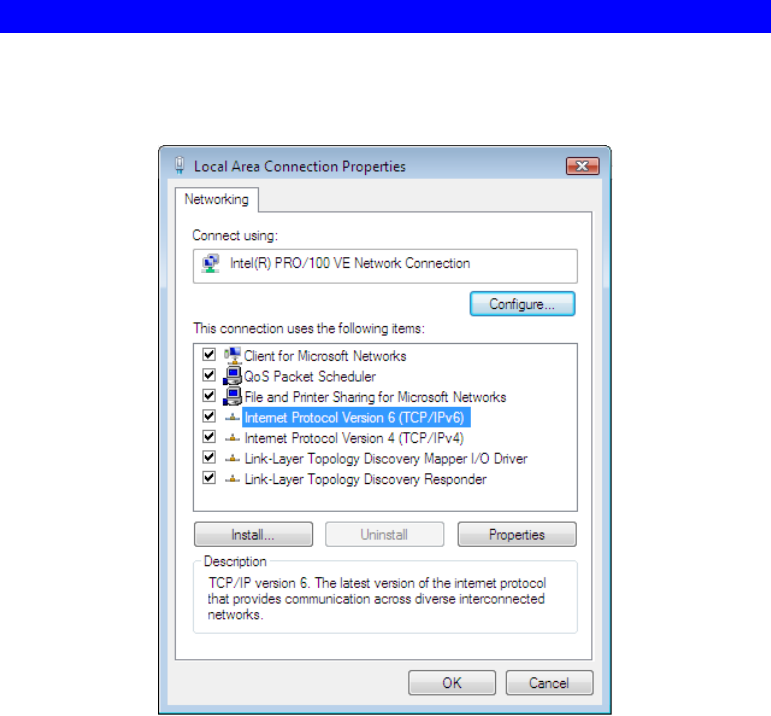
Wireless Access Point User Guide
92
Checking TCP/IP Settings - Windows Vista
1. Select Control Panel - Network Connections.
2. Right click the Local Area Connection Status and choose Properties. Click Continue to
the User Account Control dialog box, then you should see a screen like the following:
Figure 73: Network Configuration (Windows Vista)
3. Select the TCP/IP protocol for your network card.
4. Click on the Properties button. You should then see a screen like the following.
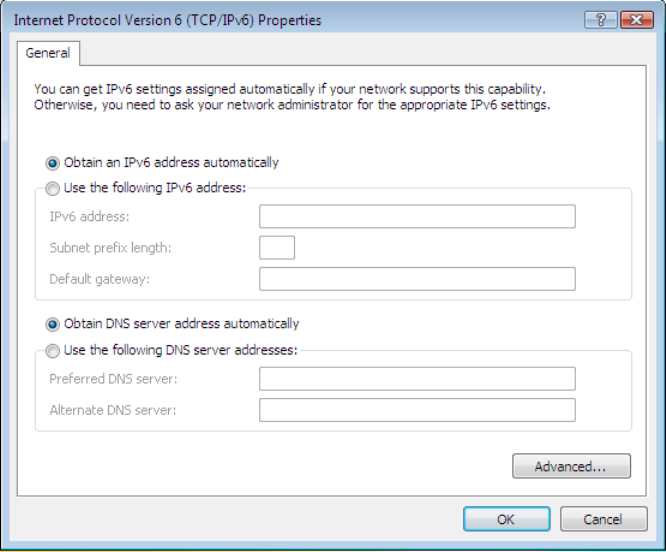
Appendix C - Windows TCP/IP
93
Figure 74: TCP/IP Properties (Windows Vista)
5. Ensure your TCP/IP settings are correct.
Using DHCP
To use DHCP, select the radio button Obtain an IP Address automatically. This is the default
Windows setting. To work correctly, you need a DHCP server on your LAN.
Using a fixed IP Address ("Use the following IP Address")
If your PC is already configured for a fixed (specified) IP address, no changes are required.
(The Administrator should configure the Wireless Access Point with a fixed IP address from
the same address range used on the PCs.)

94
Appendix D
About Wireless LANs
Overview
Wireless networks have their own terms and jargon. It is necessary to understand many of
these terms in order to configure and operate a Wireless LAN.
Wireless LAN Terminology
Modes
Wireless LANs can work in either of two (2) modes:
Ad-hoc
Infrastructure
Ad-hoc Mode
Ad-hoc mode does not require an Access Point or a wired (Ethernet) LAN. Wireless Sta-
tions (e.g. notebook PCs with wireless cards) communicate directly with each other.
Infrastructure Mode
In Infrastructure Mode, one or more Access Points are used to connect Wireless Stations
(e.g. Notebook PCs with wireless cards) to a wired (Ethernet) LAN. The Wireless Stations
can then access all LAN resources.
Access Points can only function in "Infrastructure" mode,
and can communicate only with Wireless Stations which are
set to "Infrastructure" mode.
SSID/ESSID
BSS/SSID
A group of Wireless Stations and a single Access Point, all using the same ID (SSID),
form a Basic Service Set (BSS).
Using the same SSID is essential. Devices with different SSIDs are unable to communi-
cate with each other. However, some Access Points allow connections from Wireless
Stations which have their SSID set to “any” or whose SSID is blank (null).
ESS/ESSID
A group of Wireless Stations, and multiple Access Points, all using the same ID (ESSID),
form an Extended Service Set (ESS).
D

Appendix D - About Wireless LANs
95
Different Access Points within an ESS can use different Channels. To reduce interference,
it is recommended that adjacent Access Points SHOULD use different channels.
As Wireless Stations are physically moved through the area covered by an ESS, they will
automatically change to the Access Point which has the least interference or best perfor-
mance. This capability is called Roaming. (Access Points do not have or require Roaming
capabilities.)
Channels
The Wireless Channel sets the radio frequency used for communication.
Access Points use a fixed Channel. You can select the Channel used. This allows you to
choose a Channel which provides the least interference and best performance. For 802.11g,
13 channels are available in the USA and Canada, but 11channels are available in North
America if using 802.11b.
If using multiple Access Points, it is better if adjacent Access Points use different Chan-
nels to reduce interference. The recommended Channel spacing between adjacent Access
Points is 5 Channels (e.g. use Channels 1 and 6, or 6 and 11).
In "Infrastructure" mode, Wireless Stations normally scan all Channels, looking for an
Access Point. If more than one Access Point can be used, the one with the strongest signal
is used. (This can only happen within an ESS.)
If using "Ad-hoc" mode (no Access Point), all Wireless stations should be set to use the
same Channel. However, most Wireless stations will still scan all Channels to see if there
is an existing "Ad-hoc" group they can join.
WEP
WEP (Wired Equivalent Privacy) is a standard for encrypting data before it is transmitted. This
is desirable because it is impossible to prevent snoopers from receiving any data which is
transmitted by your Wireless Stations. But if the data is encrypted, then it is meaningless
unless the receiver can decrypt it.
If WEP is used, the Wireless Stations and the Wireless Access Point must have the same
settings.
WPA-PSK
Like WEP, data is encrypted before transmission. WPA is more secure than WEP, and should
be used if possible. The PSK (Pre-shared Key) must be entered on each Wireless station. The
256Bit encryption key is derived from the PSK, and changes frequently.
WPA2-PSK
This is a further development of WPA-PSK, and offers even greater security, using the AES
(Advanced Encryption Standard) method of encryption.
WPA-Enterprise
This version of WPA requires a Radius Server on your LAN to provide the client authentica-
tion according to the 802.1x standard. Data transmissions are encrypted using the WPA
standard.

Wireless Access Point User Guide
96
If this option is used:
The Access Point must have a "client login" on the Radius Server.
Each user must have a "user login" on the Radius Server.
Each user's wireless client must support 802.1x and provide the login data when required.
All data transmission is encrypted using the WPA standard. Keys are automatically generated,
so no key input is required.
802.1x
This uses the 802.1x standard for client authentication, and WEP for data encryption. If possi-
ble, you should use WPA-Enterprise instead, because WPA encryption is much stronger than
WEP encryption.
If this option is used:
The Access Point must have a "client login" on the Radius Server.
Each user must have a "user login" on the Radius Server.
Each user's wireless client must support 802.1x and provide the login data when required.
All data transmission is encrypted using the WEP standard. You only have to select the
WEP key size; the WEP key is automatically generated.

97
Appendix E
Command Line Interface
Overview
If desired, the Command Line Interface (CLI) can be used for configuration. This creates the
possibility of creating scripts to perform common configuration changes. The CLI requires a
Telnet connection to the Wireless Access Point.
Using the CLI - Telnet
1. Start your Telnet client, and establish a connection to the Access Point.
e.g.
Telnet 192.168.0.228
2. You will be prompted for the user name and password. Enter the same login name and
password as used for the HTTP (Web) interface.
The default values are admin for the User Name, and password for the Password.
3. Once connected, you can use any of the commands listed in the following Command
Reference.
Command Reference
The following commands are available.
config vap Config Virtual AP X
? Display CLI Command List
help Display CLI Command List
get 11nampdu Set 11n A-MPDU Aggregation Mode
get 11namsdu Set 11n A-MSDU Aggregation Mode
get 11nguardinterval Set 11n Guard Interval Mode
get 11nsubchannel Set 11n Extension Sub-Channel
get 11nradioband Set 11n Radio Band
get 802.11d Display 802.11d Mode
get acctserver Display Accounting Server
get acctport Display Accounting Port
get acctsecret Display Accounting Secret
get acl Display Access Control Status
get active Display VAP Active (up) Mode
get aging Display Idle Timeout Interval
get authentication Display Authentication Type of WEP
E

Wireless Access Point User Guide
98
get beaconinterval Display Beacon Interval
get channel Display Radio Channel
get country Display Country/Domain
get defaultkey Display Default Key Index
get description Display Access Point Description
get dhcp Display DHCP Mode
get dhcpserverendip Display DHCP Server End IP Address
get dhcpserverstartip Display DHCP Server start IP Address
get dnsserver Display IP Address of DNS Server
get
dot1xdynkeyupdate Display 802.1x Dynamic Key Update Mode
get dot1xdynkeylife Display 802.1x Dynamic Key Life Time (in Minutes)
get dot1xkeytype Display 802.1x Distribute Key Method
get fragthreshold Display Fragment Threshold
get gateway Display Gateway IP Address
get gtkupdate Display Group Key Update Mode
get gtkupdateinterval Display Group Key Update Interval (in Seconds)
get http Display HTTP Mode
get httpport Display HTTP Port Number
get https Display HTTPS Mode
get httpsport Display HTTPS Port Number
get ipaddr Display IP Address
get ipmask Display IP Subnet Mask
get isolation Display Isolate All Virtual APs State
get key Display WEP Key Value
get keylength Display WEP Key Length
get lltd Display LLTD Mode
get md5supplicant Display 802.1x MD5 Supplicant Mode
get md5suppname Display 802.1x Supplicant MD5 Name
get md5supppassword Display 802.1x Supplicant MD5 Password
get md5supptype Display 802.1x MD5 Supplicant Type
get nativevlanid Display Native VLAN ID
get ntp Display NTP Server IP Address
get operationmode Display Operation Mode
get password Display Login Password

Appendix E - Command Line Interface
99
get psk Display Pre-shared Key
get radiusserver Display RADIUS Server IP Address
get radiusport Display RADIUS Port Number
get radiussecret Display RADIUS Shared Secret
get remoteptmp Display PTMP's Remote MAC Address List
get remoteptp Display PTP's Remote MAC Address
get roguedetect Display Rogue AP Detection Mode
get rogueinteval Display Interval of Every Rogue AP Detection
get roguelegal Display Legal AP List of Legal AP
get roguetrap Display Rogue AP Detection Send SNMP Trap Mode
get roguetype Display Rogue AP Definition
get rtsthreshold Display RTS/CTS Threshold
get security Display Wireless Security Mode
get shortpreamble Display Short Preamble Usage
get snmpreadcommu-
nity Display SNMP Read Community
get snmpwritecommu-
nity Display SNMP Write Community
get snmpmode Display SNMP Mode
get snmpmanagemode Display SNMP Manager Mode
get snmptrapmode Display SNMP Trap Mode
get snmptrapversion Display SNMP Trap Version
get snmpv3username Display SNMP v3 User Name
get snmpv3authproto Display SNMP v3 Authentication Protocol
get snmpv3authkey Display SNMP v3 Authentication Key
get snmpv3privproto Display SNMP v3 Private Protocol
get snmpv3privkey Display SNMP v3 Private Key
get ssid Display Service Set ID
get ssidbroadcast Display SSID Broadcast Mode
get stp Display STP Mode
get strictgtkupdate Display Group Key Update Strict Status
get syslog Display Syslog Mode
get syslogport Display Syslog Port
get syslogserver Display Unicast Syslog Server Address
get syslogseverity Display Syslog Severity Level

Wireless Access Point User Guide
100
get systemname Display Access Point System Name
get telnet Display Telnet Mode
get time Display Current System Time
get timezone Display Time Zone Setting
get uptime Display Access Point Up Time
get username Display Login User Name
get vapname Display Virtual AP Name
get version Display Firmware Version
get vlan Display VLAN Operational State
get vlanid Display the VLAN ID
get wirelessmode Display Wireless LAN Mode
get wirelessseparate Display Wireless Seprate Mode
get wmm Display WMM Mode
get wmmnoack Display WMM No Acknowledgement status
set 11nampdu Set 11n A-MPDU Aggregation Mode
set 11namsdu Set 11n A-MSDU Aggregation Mode
set 11nguardinterval Set 11n Guard Interval Mode
set 11nsubchannel Set 11n Extension Sub-Channel
set 11nradioband Set 11n Radio Band
set 802.11d Set 802.11d Mode
set acctserver Set Accounting Server
set acctport Set Accounting Port
set acctsecret Set Accounting Secret
set acl Set Access Control
set active Set Active (up) Mode
set aging Set Idle Timeout Interval
set authentication Set Authentication Type of WEP
set beaconinterval Set Beacon Interval
set channel Set Radio Channel
set country Set Country/Domain
set defaultkey Set Default Key Index
set description Set Access Point Description
set dhcp Set DHCP Mode
set dhcpserverendip Set DHCP Server End IP Address
set dhcpserverstartip Set DHCP Server start IP Address

Appendix E - Command Line Interface
101
set dnsserver Set DNS Server IP Address
set dot1xdynkeyupdate Set 802.1x Dynamic Key Update Mode
set dot1xdynkeylife Set 802.1x Dynamic Key Life Time (in Minutes)
set dot1xkeytype Set 802.1x Distribute Key Method
set fragthreshold Set Fragment Threshold
set gateway Set Gateway IP Address
set groupkeyupdate Set Group Key Update Mode
set groupkeyupdatein-
terval Set Group Key Update Interval (in Minutes)
set http Set HTTP Mode
set httpport Set HTTP Port Number
set https Set HTTPS Enable/Disable
set httpsport Set HTTPS Port Number
set ipaddr Set IP Address
set ipmask Set IP Subnet Mask
set isolation Set Isolate All Virtual APs State
set key Set WEP Key Value
set keylength Set WEP Key Length
set lltd Set LLTD Mode
set md5supplicant Set 802.1x MD5 Supplicant Mode
set md5suppname Set 802.1x Supplicant MD5 Name
set md5supppassword Set 802.1x Supplicant MD5 Password
set md5supptype Set 802.1x MD5 Supplicant Type
set nativevlanid Set Native VLAN ID
set ntp Set NTP Server IP Address
set operationmode Set operation Mode
set password Modify Login Password
set psk Modify Pre-shared Key
set radiusserver Set RADIUS IP Address
set radiusport Set RADIUS Port Number
set radiussecret Set RADIUS Shared Secret
set remoteptmp Set PTMP's Remote MAC Address List
set remoteptp Set Remote PTP MAC Address
set roguedetect Set Rogue AP Detection Mode
set rogueinteval Set Interval of Rogue AP Detection(Range: 3 ~ 99)

Wireless Access Point User Guide
102
set roguelegal Add/Delete Legal AP MAC/OUI
set roguesnmp Set Rogue AP Detection SNMP Trap Mode
set roguetype Set Rogue AP Definition
set rtsthreshold Set RTS/CTS Threshold
set security Set Wireless Security Mode
set shortpreamble Set Short Preamble
set snmpreadcommu-
nity Set SNMP Read Community
set snmpwritecommu-
nity Set SNMP Write Community
set snmpmode Set SNMP Mode
set snmpmanagemode Set SNMP Manager Mode
set snmptrapmode Set SNMP Trap Mode
set snmptrapversion Set SNMP Trap Version
set snmpv3username Set SNMP v3 User Name
set snmpv3authproto Set SNMP v3 Authentication Protocol
set snmpv3authkey Set SNMP v3 Authentication Key
set snmpv3privproto Set SNMP v3 Private Protocol
set snmpv3privkey Set SNMP v3 Private Key
set ssid Set Service Set ID
set ssidsuppress Set SSID Broadcast Mode
set stp Set STP Mode
set strictgtkupdate Set Group Key Update Strict Status
set syslog Set Syslog Mode
set syslogport Set Syslog Port
set syslogserver Set Unicast Syslog Server Address
set syslogseverity Set Syslog Severity Level
set systemname Set Access Point System Name
set telnet Set Telnet Mode
set timezone Set Time Zone Setting
set username Modify Login User Name
set vlan Set VLAN Operational State
set vlanid Set the VLAN Tag
set wirelessmode Set Wireless LAN Mode
set wirelessseparate Set Wireless Seprate Mode

Appendix E - Command Line Interface
103
set wmm Set WMM Mode
set wmmnoack Set WMM No Acknowledge
factoryrestore Restore to Default Factory Settings
apply To make the changes take effect
exit Quit the telnet
This device complies with part 15 of the FCC Rules. Operation is subject to the following
two conditions: (1) This device may not cause harmful interference, and (2) this device
must accept any interference received, including interference that may cause undesired
operation.
For a Class B digital device or peripheral, the instructions furnished the user shall
include the following or similar statement, placed in a prominent location in the text of
the manual:
NOTE: This equipment has been tested and found to comply with the limits for a
Class B digital device, pursuant to Part 15 of the FCC Rules. These limits are
designed to provide reasonable protection against harmful interference in a
residential installation. This equipment generates, uses and can radiate radio
frequency energy and, if not installed and used in accordance with the
instructions, may cause harmful interference to radio communications. However,
there is no guarantee that interference will not occur in a particular installation.
If this equipment does cause harmful interference to radio or television reception,
which can be determined by turning the equipment off and on, the user is
encouraged to try to correct the interference by one or more of the following
measures:
--Reorient or relocate the receiving antenna.
-- Increase the separation between the equipment and receiver.
-- Connect the equipment into an outlet on a circuit different
from that to which the receiver is connected.
-- Consult the dealer or an experienced radio/TV technician for
help.
(c) The provisions of paragraphs (a) and (b) do not apply to digital devices exempted
from the technical standards under the provisions of Section 15.103.
(d) For systems incorporating several digital devices, the statement shown in
paragraph (a) or (b) needs to be contained only in the instruction manual for the main
control unit.
(e) In cases where the manual is provided only in a form other than paper, such as on
a computer disk or over the Internet, the information required by this section may be
included in the manual in that alternative form, provided the user can reasonably be
expected to have the capability to access information in that form.
RF exposure warning
This equipment must be installed and operated in accordance with provided instructions
and the antenna(s) used for this transmitter must be installed to provide a separation
distance of at least 20 cm from all persons and must not be co-located or operating in
conjunction with any other antenna or transmitter. End-users and installers must be
provide with antenna installation instructions and transmitter operating conditions for
satisfying RF exposure compliance.